|
|
||||||||||||||||||||||
 |
This page is linked to the Kenosha Potato Project
click here to review the Project Guidelines This page is updated with the help of many gardeners who are growing these potatoes in SE Wisconsin. Join us on Facebook - click here. |
|||||||||||||||||||||
| Potato varieties are organized on this catalog web page by the known name (some varieties are grown with several names). This list is expected to grow to 400+ varieties by the end of 2015. All grown from tubers by KPP or SSE members. | ||||||||||||||||||||||
|
Many thanks to Jeff Baas, a professional videographer, who donated his time to document the Kenosha Potato Project in the summer of 2012. See for yourself what I learned about growing potato during a season of extreme drought, without access to water for irrigation. The video runs for a full hour, starting in June and ending with the harvesting of late varieties in October. About half way [31 min] I show you seed berries of the variety Dheera. Seed berries produce potato botanical seed [aka TPS]. Growing potato from seed produces new tuber varieties. And thanks to Barb Leable for providing this VIDEO TRANSCRIPT ... so you can read while you watch the video and better understand what I'm saying ;+).
|
||||||||||||||||||||||
| We are interested in receiving feedback to complete our records. Many crop catalogs are developed by University Extension Offices for the commercial farming community. This catalog focuses on rare varieties grown in home gardens. We are particularly interested to keep records of recipes - best use for each variety. As these recipies are made available to us, they will be linked to each variety that can be used.
Duplicate Names: Heirloom varieties may be found with different names because of misspelling, or name changes for marketing purposes. But sometimes the same cultivar is grown in very different regions for many years with different names, those tubers may have evolved to a sport. Often you find all the sport cultivars bunched together as one variety, but in this listing we keep the sports separate, as we grow them out as separate varieties. Sometimes growers add their regional name to a cultivar name to imply that their soil, climat, or daylength produces better tubers - those regional additions are here listed as "aka" - if you grow these varieties, you should drop the regional addition to prevent confusion and/or fraud. Pictures: Few pictures were taken before the tubers were planted - not the best condition! We are planning to replace all pictures with tubers at harvest time (best condition) following these standards:
Gardeners' Network Feedback: Local gardeners who are participating should report back to correct listings.
Any reader, local or non-local, may provide additional text for this page, if you have additional comments relative to any variety you are growing. Please help us complete this catalog. Send us an email with your comments and advise for interesting varieties, both US Heritage and Old World Specialties. SPECIAL PROJECTS As the Kenosha Potato Project Collection is growing in size and depth, Curzio Caravati is taking a little different approach to the duplication of the Seed Saver Exchange Potato Crop collection. I'm no longer interested in any white potato, except for heritage varieties with 100+ years of age. The focus of my share of the Kenosha Potato Project collection focuses on these special projects.
Plus I'm planning to add links to recipes ... please send me recipes , tips for good recipe books and suggest interesting web sites to find more recipes for the cultivars that you grow in your garden. KEY WORD SEARCH If you are interested in my special projects, please search this catalog with the key words
I often refer to tuber sizes as standard, mini and micro tubers. For seed purpose whole tubers are best in the 1 to 2 oz weight. Mini tubers may be a small as a chestnut and weigh as little as 1/2 oz. - Micro tubers are smaller than a chestnut [like a hazel nut] and may be smaller than a pea. ALTERNATIVE SEED SOURCES Many viewers of this page study my descriptions and special project reports to make decisions on which varieties to grow. If you need to order seed, please become a member of Seed Savers Echange (to order from me or other listed members). When you order from SSE Listed Members you only get 3-4 small tubers for $6 and often you would NOT have an alternative - especially if the variety is rare. Often heritage varieties are offered by commercial vendors - we recommend these commercial vendors (see codes in the variety descriptions):
Last update: December 2014 - Last entry: #398 Okella Quehuil Commercial Vendor Retail Catalogs - Please send a message to seedsaver@curzio.com if you accept small orders from gardeners and wish to be added to this recommended Commercial Vendors Listing. It is a lot of work to keep the commercial offerings updated! A donation to the Project would motivate me to get to it ... you get the hint! Thanks, Curzio
|
||||||||||||||||||||||
| PI 473276
Small round tubers with dark burgundy blue skin and yellow flesh. The vine growth is consistent with South American landraces, probably a diploid, S. andigenum or S. tuberosum ssp andigenum. Tom Wagner posted on Kenosha Potato Project Facebook page: 'I was playing around with seedlings, including PI 473276 in 2011 + and other Facebook group members recognized the picture posted'. This vine may need an extra long growing season to tuberize larger spuds. The vine develops long stolons and sets tubers high and serial. |
||||||||||||||||||||||
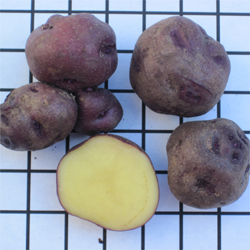 |
||||||||||||||||||||||
| Source: WASTD13 Local grower: Curzio
Grown in 2013 in a 14" black bag, 3 mini tubers produced 13 oz, 80 tubers, 40 mini and 40 micro. The variety is flagged for 2014 to be tested with 6 mini tubers as starting seed to check if we can increase yields with seed crowding. Also, we shall try to plant the bag earlier in a hoophouse to give the vine a longer growing season. Best use in the kitchen for this starchy variety? We tasted this potato and found it flaky with a nice flesh texture, flavor and bitter aftertaste. The skin is medium and bitter. |
||||||||||||||||||||||
| Achirana, aka Achirana INTA
Medium size round tubers with yellow skin and white flesh. South American origin (Peru, Argentina). Found web posting mentioning Bt (Bacillus Thurengensis) to control the potato tuber moth (PTM, Phthorimaea operculella) by INTA, the Argentian Dept of Agriculture - which reports from 2004 World Potato Congress claiming that China grows about 1.25 million acres of Achirana (or 10% of the estimated total production of 70 million metric tonnes). A cross of MP161.375/23 x B25.65 Source: VT BI J08 Local grower: dropped Best use in the kitchen? waxy |
||||||||||||||||||||||
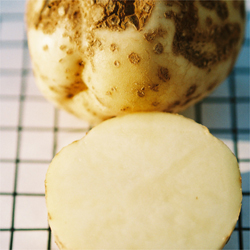 |
||||||||||||||||||||||
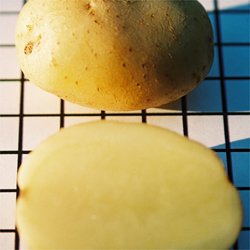 |
Adam's Yellow Fleshed
Medium-large, oblong tubers with white skin and yellow flesh. Rare variety from Canada. Tall Vines Source: ME BO W08 Local grower: Curzio Best use in the kitchen? starchy |
|||||||||||||||||||||
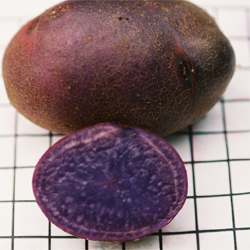 |
Adirondack Blue
Medium-large, oval to oblong tubers with dark blue skin and dark purple flesh. Developed by Cornell University as a cross of Chieftain x Black Russian and released in 2003. Sets true seed pods. Source: MA C08 and CV Fe5 Alt Source: CV Ron CV Ma23 CV Wo6 Local grower: What's the best use in the kitchen? |
|||||||||||||||||||||
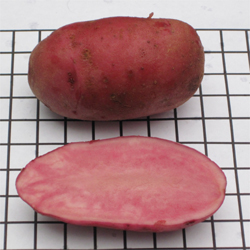 |
Adirondack Red (formely named T17-2)
Medium-large, oval to oblong tubers with dark red skin and dark red flesh. Developed by Cornell University as a cross of N40-2 x Q155-3 and released in 2004. Vines grow shorter than All Red - may be good choice for Potato Bag. Source: CV Fe5 10 Alt Source: CV Ron CV Ma23 CV Wo6 Local grower: What's the best use in the kitchen? |
|||||||||||||||||||||
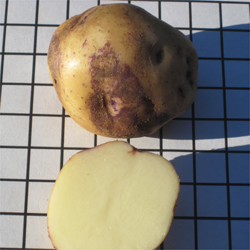 |
Advira
Medium, blocky tubers with light yellow skin with attractive purple patches and pale yellow, starchy flesh. A cross of Bona x MPI 44 335 68 released in Germany in 1960. GRIN: PI 285264 Source: ME BO W08 Local grower: Curzio Grown in a 14" black bag in 2013 it produced 16 oz, 13 mini tubers, no micro. Perhaps a good choice for a hoophouse start to check for extra early crop. The skin color is very attractive. |
|||||||||||||||||||||
| What's the best use in the kitchen for this starchy tuber? We tasted this potato and found it creamy (even though it's a starchy potato), with good flavor. It features medium-thin skin with an attractive tan/purple blotches that keep very well after boiling, therefore to show off the skin colors, perhaps this variety could be a good choice for boiled potato with the jackets. | ||||||||||||||||||||||
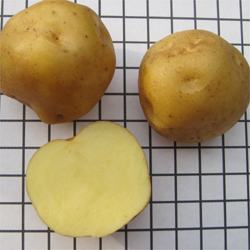 |
Aeggeblom , Aeggeblomme
Medium, round - oval tubers with light yellow skin and flesh. An old variety from Sweden. Source: ME BO W08 Local grower: Curzio Grown for several years in bags turns out to be one of the most consistent producers. Tested in 2014 as part of my Extra Early batch, with planting one month early protected by plastic. Two bags with each 3 vs 5 starting seed produced 40 vs 37 oz each, which may prove that this variety does not increase yields with seed crowding. Flagged for 2015 with 3 vs 4 starting seed. |
|||||||||||||||||||||
| What's the best use in the kitchen for this waxy variety? We have tasted this potato and found it firm with a nice nutty aftertaste. The skin is medium-thin. | ||||||||||||||||||||||
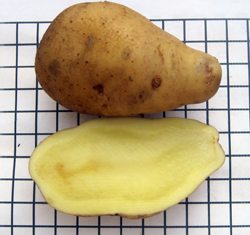 |
||||||||||||||||||||||
| Aggie Gold
Medium-large oval to oblong tubers with yellow skin and flesh. Bred by Tom Wagner who named it probably as a sibling of Aggie Red. The vines produce seed berries. Very impressive first year production. 4 starting tubers produced 159 oz (one ounce short of 10 pounds0 which is exceptional for one bag production, 87 tubers, mostly mini and above 2 oz, just 2 micro. |
||||||||||||||||||||||
| Aggie Red
Medium-large oval to oblong tubers with red skin and red-dark yellow flesh. Bred by Tom Wagner who posted on the Kenosha Potato Project Facebook Group: 'Aggie Red was one of several clones developed from the cross of Agria and Blue Blood Russet. Agria is a good source parent for making crosses. The blue coloring in the sprouts of Agria combined with the red of the Colorado Aberdeen number to make the purple skin of the hybrid. Agria is male sterile and I am surprised that the fertility is restored in the Aggie Red as I think there must be some pollen fertility restoring genes from my Blue Blood Russet.' |
||||||||||||||||||||||
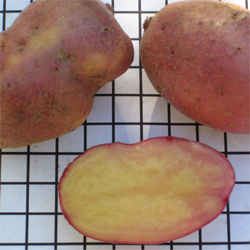 |
||||||||||||||||||||||
| It grows TALL VINES, sets tubers high and produces seed berries. Certainly a keeper for potato growing in containers.
Source: WASTD13 Local grower: Curzio What's the best use in the kitchen for this starchy variety? This variety fared pretty well in a blind test of 11 red-fleshed varieties, oven roasted. It keeps the a nice flesh color after cooking. |
||||||||||||||||||||||
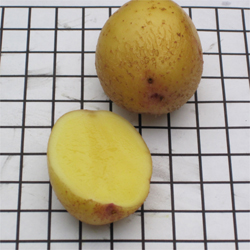 |
Agnes
Medium-small, round to oval tubers with yellow flesh and yellow skin with red blush at the stern end. Grown from TPS saved by Ron Sjostrand's father who died before the botanical seed was started - I'm glad to add this heritage variety from a SSE member in MN. Attention: this is NOT Agnes [Allerfruheste Gelbe x Sophie] released 1938 in Germany. Grown in 2014 as part of my Extra Early batch in a hoophouse in a 14" bag, 3 tubers produced 43.5 oz, |
|||||||||||||||||||||
| a total of 51 tubers, of which 4 above 2 oz, 31 mini and 16 micro. Planning to test 2 bags in 2015 with each 3 and 4 starting seed tubers to test seed crowding.
Source: MN SJ R11 Local grower: Curzio We tasted this potato and found it very tasty, earthy, featuring slightly bitter thin skin; What's the best use in the kitchen for this starchy variety? |
||||||||||||||||||||||
| Agria
A variety developed by Kartoffelzucht Bohm, Luneburg, Germany and released in 1985. Grows large oval to oblong tubers with yellow flesh and yellow skin. CV Ron grows this variety which they renamed "Alby's Gold"!! Tom Wagner claims this variety is a great male pollen producer [see description of Aggie Red]. Source: CV Ron Local grower: Curzio |
||||||||||||||||||||||
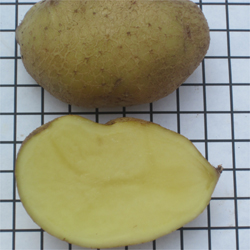 |
||||||||||||||||||||||
| Grown in 2013 an 18" tall bag, 3 mini tubers produced 53.5 oz, 26 tubers, 13 over 2 oz, 9 mini and just 4 micro. The variety is flagged for testing with 4 starting mini in 2014 to check if the total weight can be improved, as the 2013 crop is one of the highest in an 18" tall bag.
What's the best use in the kitchen for this multi-purpose variety? We have tasted this potato and found it lightly starchy, but not too dry and with good flavor. The skin is medium thick. It is remarkable how the yellow flesh color becomes darker after cooking. It probably would make wonderful hand cut fries. |
||||||||||||||||||||||
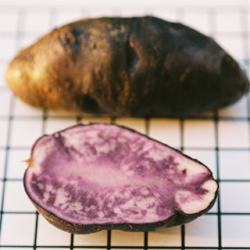 |
Ajawiri, aka Ajanhuiri
Fingerling type landrace tuber, believed to be similar (perhaps parent) to Negresse. Like Laram Ajawiri, this dark purple variety belongs to the Ajanhuiri potato group (Solanum ajanhuiri). May be identical to Negresse and Violette - Need more years to compare - this year Ajawiri had longer growing season than all other similar varieties - tuber size also appears larger. In 2013 we are sending samples of the 3 varieties Ajawiri, Negresse and Violette to be genetic fingerprinted to determine if these are different or identical. |
|||||||||||||||||||||
| Also you may be interested to further explore other interesting varieties which are grown with the common name "potato" but may not belong to the Solanum tuberosum specie [landrace species' taxa are kept for different count of chromosomes; diploid count 24, triploid 36, tetraploid 48 and pentaploid 60]. Landrace species are grown and often cross-pollinated with S. tuberosum; S. ajanhuiri [diploid], S. andigenum [diploid, triploid, and tetraploid], S. chaucha [Andean triploid], S. chilotanum [tetraploid - lowland Chilean landraces], S. curtilobum [pentaploid], S. juzepczukii [triploid], S. phureja and S. stenotomum [both diploid].
Source: ME BO W08 Local grower: Curzio What's the best use in the kitchen? Expected to taste like roasted chestnuts if similar to Violette? |
||||||||||||||||||||||
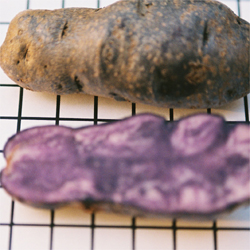 |
||||||||||||||||||||||
| Ake Truedsson Blue
A Skandinavian seedling of Congo (here listed as Russian Blue), fingerling shaped with dark blue skin and purple flesh. We have received confirmation from Ake, a Sweden SSE member, that this tuber is the result of growing vines from Congo TPS which generated a wide variety of colors - this being one of them, in 2013 this variety may be used as a comparative for genetic fingerprinting in a planned study in partnership with the US Potato Genebank to figure out which varieties of a large collection of similar tubers are |
||||||||||||||||||||||
| actually different or the same with synonymous names [All Blue, Amish Blue, Black Russian, Blue Marker, Blue of Sweden, Blue Russian, British Columbia Blue, Congo, Congo #5, MacIntosh Black, Nova Scotia Blue, River John Blue, Scotia Blue, Sharon's Blue, Taws Down Black ... what synonym names did I miss? - tell me please]
Source: ME BO W08 Local grower: What's the best use in the kitchen? |
||||||||||||||||||||||
| Alaska Indian
Medium-large fingerling shaped tubers with white skin and flesh. Most likely what is also known as Indian Tlingit. Look at my online catalog to compare description and pictures. Also I have a link to an article on Native American Heirloom tubers. At this time I have lost Indian Tlingit, so I'm not able to compare the two strains. This variety grows VERY TALL vines, but is not a good choice for growing in containers. The yield is always rather low here in Kenosha. |
||||||||||||||||||||||
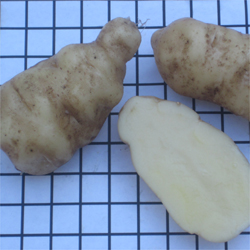 |
||||||||||||||||||||||
| Possibly the low yield is too be expected at lower latitudes due to shorter days in the Summer.
Source: SSE HF13 Local grower: Curzio What's the best use in the kitchen for this waxy variety? We have tasted this potato and found it creamy and moist, with a nice nutty flavor. The skin is thin. |
||||||||||||||||||||||
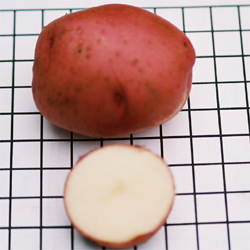 |
Alaska Red, aka Alaska Red Eye
Medium, round tubers with red skin and white flesh. A cross of Red Beauty x AK-11-57-1-59 released in 1976. Sets true seed pods. Source: MA C07 Local grower: What's the best use in the kitchen? |
|||||||||||||||||||||
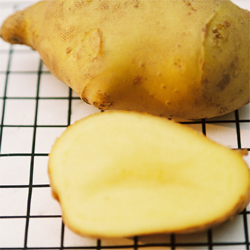 |
Alby's Gold
Medium - small round tubers with yellow skin and yellow flesh. Developed in Holland and named after Albie Buehrer, founder of Indian Rock Produce who was instrumental in introducing fingerlings to the fresh market in the late 1980's in USA. Source: VT BI J08 Alt Source: Attention: NOT from CV Ron [see Agria] Local grower: Curzio |
|||||||||||||||||||||
| Grown in 2013 in a 14" Poppy Orange bag, 3 mini produced 55 oz, 36 tubers, of which 10 standard, 24 mini and 2 micro. Flagged to be tested in 2014 with 4 mini as starting seed to check if the yield can be further improved.
What's the best use in the kitchen for this starchy variety? |
||||||||||||||||||||||
| Alcca Imilla
Small, round to oval, flat tubers with bi-color purple / yellow skin and yellow flesh, grown as part of my Exotic batch. Very long growing season. The vines produced berries and TPS. Source: US Genebank 14 Local grower: Curzio What's the best use in the kitchen for this variety? |
||||||||||||||||||||||
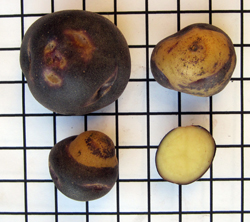 |
||||||||||||||||||||||
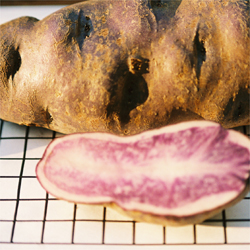 |
All Blue (aka many different names)
Known with many different names, including Congo, Russian Blue and Blue of Sweden. We keep the strains separate because they produce different yields and we like to compare them. Sets true seed pods. Source: ME BO W08 Alt Source: CV Ma23 - CV Fe5 - CV Se16 CV Wo6 Local grower: What's the best use in the kitchen for this starchy variety? |
|||||||||||||||||||||
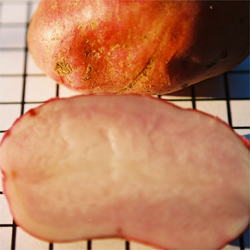 |
All Red
Large tubers with orange-red skin and pink flesh. Will Bonsall reports that this cultivar sets true seed pods - check if true for this region. Compare with Cranberry Red (Huckleberry) Source: ME BO W08 Alt Source: CV Ron and CV Se16 Local grower: Curzio Best use in the kitchen? starchy |
|||||||||||||||||||||
| Alpha
Medium oval tubers with yellow skin and pale yellow flesh. Will Bonsall reports that this cultivar is very late and sets true seed pods - check if true for this region. He also recommends to space closely. Released in 1919 a cross of Paul Kruger x Preferent. GRIN: PI 341778 Source: ME BO W08 Local grower: What's the best use in the kitchen for this multi-purpose variety? |
||||||||||||||||||||||
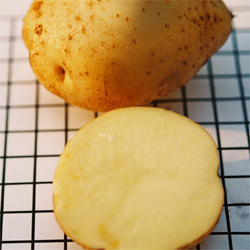 |
||||||||||||||||||||||
| Amarilla [CIP 703267]
Medium-large tubers with yellow skin and dark yellow flesh. A landrace from Costa Rica sent to US via CIP and listed as a traditional cultivar or landrace S. stenotomum subsp.goniocalyx. In 2014 it produced a huge amount of seed berries. GRIN: PI 607494 |
||||||||||||||||||||||
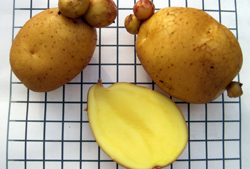 |
||||||||||||||||||||||
| Source:US Genebank 14 Local grower: Curzio
Grown in 2014 in an 18" tall bag, the vines were green for 129 days, and 1 tuber produced 40 oz, a total of 24 tubers, of which 11 over 2 oz and 8 mini, 5 micro. Flagged to be grown with the Exotic batch in 2015. What's the best use in the kitchen for this starchy variety? We tasted this potato and found it to be flaky and dry, but the flesh melts in your mouth a little gritty with a quite sweet flavor. It features a rather thick skin. |
||||||||||||||||||||||
| AmaRosa
Medium-small fingerling type tubers with red skin and flesh. A 2010 release from Oregon State University, formely known as POR01PG22-1, PVP protected. Source: WAHOC13 Local grower: Grown in 2013 in a 14" Poppy Orange bag, it produced 14.5 oz, 26 tubers, 22 mini [rated as mini because all below 2 oz in weight, but this may well be the standard size to this variety], and 4 micro. |
||||||||||||||||||||||
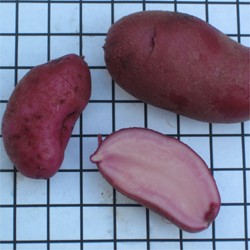 |
||||||||||||||||||||||
| What's the best use in the kitchen for this multi-purpose variety? We tasted this potato and found it to be flaky and bitter. It features a thick, bitter skin. The flavor is rated as poor, boiled in a vegetable soup, BUT turned out to be the best [baked with a light coating of olive oil, spices and sea salt] out of 11 red fleshed varieties in a blind test. Perhaps this could become the standard for large commercial production which is more concerned with desease resistance and yields than with flavor, and we may drop it from this collection soon. | ||||||||||||||||||||||
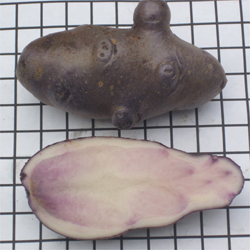 |
Amish Blue
Medium fingerling type tubers with dark purple skin and purple flesh. Rare variety. Source: ME BO W08 Local grower: Curzio What's the best use in the kitchen for this starchy variety? |
|||||||||||||||||||||
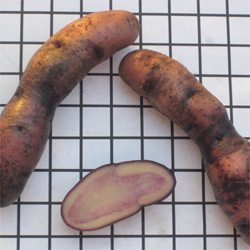 |
||||||||||||||||||||||
| Andine Peru (S100)
Bicolor landrace from South America with vines which may grow 5 ft tall. The flesh is cream, sometimes with red/purple stripes. Very rare variety. Source: BO G 11 Local grower: Curzio Grown in 2013 in a 14" Poppy Orange bag, the yield is extremely low at 5.5 oz, but I was finally able to get some decent sized tubers that show the bicolor skin pattern. The vines only grow a little over one foot long. |
||||||||||||||||||||||
| What's the best use in the kitchen for this starchy variety? We tasted this potato and found it flaky and quite bitter. In fairness we were only able to cook up 3 mini tubers, this variety is not very productive. It took 3 years to get 5 tubers in standard size, which we are keeping for seed in 2014. It is possible that mini tubers are more bitter than standard size tubers - we shall review this taste rating in the future. Interesting to note that the skin is medium-think and keeps the attractive bicolor pattern after cooking. | ||||||||||||||||||||||
| Anett
A german breed of Solanum demissum x Solanum acaule [48060 x MPI 44.1016/10], released in 1964 by Saatzucht Rudolf Pohl KG, featuring yellow (some times red blotched) skin and yellow flesh. Rob Wagner reported: This required some tricky breeding. For one thing, S. demissum is hexaploid. They had to cross it to a diploid, then they could cross it to a tetraploid which is what virtually all commercial domesticated potatoes are. Source: US Genebank 12 Local grower: Curzio |
||||||||||||||||||||||
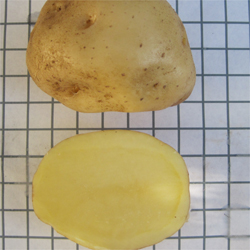 |
||||||||||||||||||||||
| Grown in an 18" tall bag in 2013 - good choice because this vine sets tuber high and I found large size mini tubers high in the bag - the bag produced 33.5 oz, 37 tubers, of which 1 standard, 30 mini and only 6 micro.
The 2014 test as part of my Extra Early Batch proved very successful. Comparing two 18" tall bags, 4 vs 6 mini tubers planted March 31 with plastic protection for 45 days to prevent frost damage, the 4 tuber bag produced 70 oz, while the 6 tuber bag produced 85.5 oz. Combined stats for both bags account for a total of 116 tubers, of which 34 above 2 oz, 46 mini and 36 micro. For 2015 I'm comparing this variety with 5 starting tubers vs. 7 to see if the yield can be further improved. What's the best use in the kitchen for this multi purpose variety? We tasted this potato and found it nice, creamy, lightly nutty, featuring a medium thin skin; excellent for soups or lightly broiled with garlic and butter. |
||||||||||||||||||||||
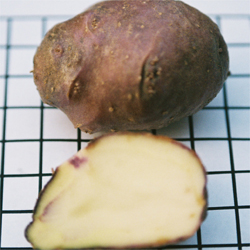 |
Angelina Mahoney's Blue
Medium-large heritage tubers from Nova Scotia, Canada. Flat, oblong shape with bright purple skin and white flesh with purple markings in the vascular ring at the terminal end of the tuber. Quite similar to Ruby Pulsiver's Blue Noser. Source: ME BO W08 Local grower: Curzio Grown in an 18" tall bag in 2013 it produced 21.5 oz, 31 tubers, of which 3 standard, 19 mini and 9 micro. Not a great producer, BUT certainly a keeper. |
|||||||||||||||||||||
| What's the best use in the kitchen for this very starchy variety with thick skin? We tasted this potato and found it very starchy with very good flavor. Probably best to cook whole with the skins as the cut pieces fall apart easily. The skin is thick and slightly bitter. | ||||||||||||||||||||||
| Antigo Gem
Medium, round tubers. Found this web post for cultivar Antigo: A 1955 release from The University of Wisconsin, Madison. Similar in appearance to Irish Cobbler, but with an extra tough skin for mechanical harvesting. Not sure if Antigo Gem is the same cultivar. Source: ME BO W07 Local grower: dropped Seems to be a waxing potato with thin skin - try to pan roast with skin. |
||||||||||||||||||||||
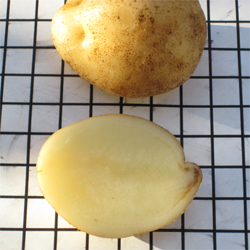 |
||||||||||||||||||||||
| Anuschka
Very large yellow tuber. The tuber in the picture came in over 9 oz. Fedco seed catalog suggest killing the vines early to prevent over size tubers. Source: CV Local grower: Curzio Grown in 2014 2 bags to compare yields. First bag with 2 starting seed tubers produced 46.5 oz; seconde bag with 4 starting tubers produced 50 oz. Both bags produced more large tubers than mini. Flagged for 2015 with greater seed crowding. |
||||||||||||||||||||||
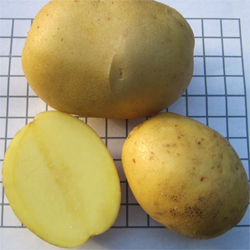 |
||||||||||||||||||||||
| What's the best use in the kitchen for this multi-purpose variety? We tasted this tuber and found it waxy and quite flavorful. We have used it in a Potato and Leek soup, and even after a few hours of cooking and rewarming the potato kept its shape well. | ||||||||||||||||||||||
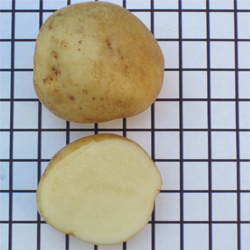 |
||||||||||||||||||||||
| Argentine White
Very rare - no much info available, except that the tubers grow round to oval, flat shape. Source: ME BO W10 Local grower: Curzio What's the best use in the kitchen for this starchy tuber? We tasted this potato in a soup, cut thin and cooked for an hour. The slices kept well. The skin is medium thin. |
||||||||||||||||||||||
| Arran Pilot
Medium-large, mostly oblong tubers. Yellow to white skin, white flesh. Good storage. A cross of May Queen x Pepo by Donald MacKelvie in 1930 in Lamash, Isle of Arran, Scotland. Source: US Genebank 12 Local grower: Curzio Planted in 2013 3 mini tubers in a 18" Tan growing bag - harvested early: 51 oz - 20 tubers total - 15 larger, 4 mini and only 1 micro. The largest tuber at 5.25 oz -Planning to test starting bags in a hoophouse to obtain extra early harvest. Also testing 3 vs 5 mini seed tubers to optimize seed crowding and check if this variety loves seed crowding. Arran Pilot does NOT set very high, but the additional 4" of compost have produced larger tubers. |
||||||||||||||||||||||
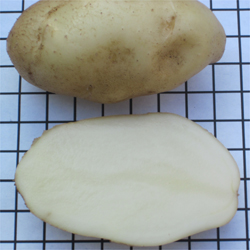 |
||||||||||||||||||||||
| What's the best use in the kitchen for this starchy potato? We tasted this potato and found it flaky, with good earthy flavor; the skin is medium-thin. It should make great hand-cut fries, or pan-fried potato. | ||||||||||||||||||||||
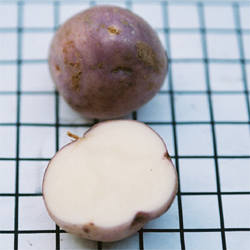 |
Arran Victory
Medium, round to oval tubers. Very attractive lavender skin, white flesh. Good storage. Hybrid by Donald MacKelvie in 1912 in Lamash, Isle of Arran, Scotland. Source: ME CU E08 Local grower: What's the best use in the kitchen for this very starchy variety? |
|||||||||||||||||||||
| Augusta
Medium, round to oval tubers. Yellow skin with red blushed eyes, and pale yellow flesh. Good storage. Reported by Fedco Seed to be one of the earliest crops with high yield. Source: CV Fe5 Alt source: CV Ma23 Local grower: dropped What's the best use in the kitchen for this waxy variety? |
||||||||||||||||||||||
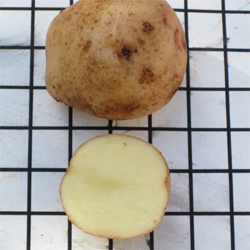 |
||||||||||||||||||||||
| Australian Crawlers
Medium-large, round to oblong tubers. Yellow skin with large red blutches, and pale yellow flesh. Perhaps called "crawler" because it grows longer stolons and may wander away from the main stems? Australian members of Kenosha Potato Project on Facebook are reporting this variety is unknown in Austalia, therefore we speculate the name was given in the US. Source: OH DZ S 14 Local grower: Curzio |
||||||||||||||||||||||
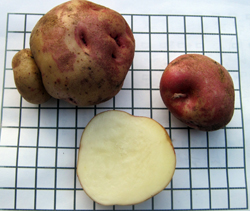 |
||||||||||||||||||||||
| What's the best use in the kitchen for this multi-use variety? We tasted this potato and found it of good earthy flavor, with thin skins. | ||||||||||||||||||||||
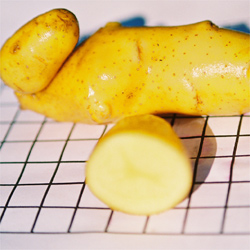 |
Austrian Crescent aka many synonyms
Very long fingerling type tubers - up to 5 - 6" long - with yellow skin and yellow flesh, also known as Kipfel and Kifli. Has tendency to grow in crescent moon shape, but name originates from bakery lingo, as Kipfel is German for croissant. In 2013 this variety may be used as a comparative for genetic fingerprinting in a planned study in partnership with the US Potato Genebank to figure out which varieties of a large collection of similar tubers are actually different or the same with synonymous names: Asparagus, Asparges, |
|||||||||||||||||||||
| Austrian Crescent I and III, Bamberger Hoernli (German for small Horn), Banana (aka Russian Banana), Corne de Mouton (French aka Corne de Belier, Cornichon, La Ratte), Fingerling Salad (German aka Ratte), Jogeva's Yellow Estonian, Kifli, Kipfel, Mandel (aka Swedish Mandel), Norwegian Fingerling, Peanut, Piekon Muikku (Finnish for small fish), Wettstein's White Crescent, White Banana ... what synonymous names did I miss? - tell me please]
Source: commercial grower 07 Alt Source: CV Ron - CV Fe5 Best use in the kitchen: Known to be excellent for potato salads - I've used it in soups un-peeled, sliced 1/4" thick, and like how the potato keeps its texture. Also fun to cut lengthwise to show the traditional croissant shape. See Austrian Potato Salad (Vegan) |
||||||||||||||||||||||
| Azul Toro
Medium-small oval tubers, bred by Tom Wagner as a cross of Negro y Azul and Kern Toro. Both parents had long stolons. It has the blue color of Negro y Azul but not as deep of blue, but much smoother skin like the red potato Kern Toro. This is a post by Tom Wagner on Kenosha Potato Facebook Group: I made the cross when both of the parents were first year TPS seedling transplants at the organic farm of Tim Thomson at the intersection of Seventh Standard Rd and I-5 |
||||||||||||||||||||||
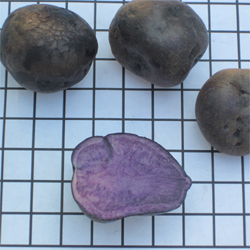 |
||||||||||||||||||||||
| near Buttonwillow, CA. That cross was made in 1995 and the first year seedling was first grown in 1996. The tubers were brought with me when I moved to Washington April 2004. The female parent was a clone I called Negro y Azul and the male parent was another clone I named Kern Toro. Both of these were in commercial production for a while near Edison, CA. [end of Tom Wagner's post]
Source: WASTD13 - Local grower: Curzio Grown in a 14" black bag in 2013 it produced 17 oz, 28 tubers, all mini, except 2 micro. Planning to grow it in 2014 starting in a hoophouse to test for an extra early crop. What is the best use in the kitchen for this waxy tuber? We tasted this potato and at this time we are rating it "BEST BLUE FLESH POTATO". Unlike most blue fleshed potato that are starchy, this one is waxy. We found it to be creamy and delicious. It features a thick skin and after cooking both the skin and flesh keep an attractive blue color. |
||||||||||||||||||||||
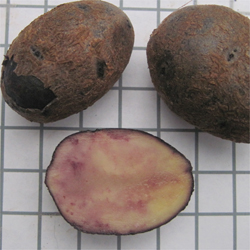 |
Azule Rose
Medium-small oval tubers, bred by Tom Wagner who reported: Azule Rose and Azul Rose are full sibs out of selfed seed of Blue Rose, which in turn is a cross of Nordic October and Azul Toro. Source: WA HO C 14 Local grower: Curzio |
|||||||||||||||||||||
| What is the best use in the kitchen for this waxy tuber? We tasted this potato and found it slightly dry, but not flaky. Very similar to Azul Toro in taste. The flesh cooks to a creamy color, but after boiling with the skins, the outer layer of the flesh keeps a nice blue color. We suggest to use it for a potato salad. The skin is medium thick and easy to remove. | ||||||||||||||||||||||
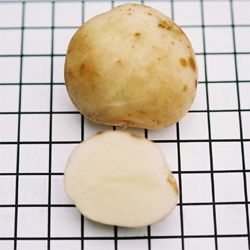 |
Bake King
Medium, flat, oblong white tubers. R. Plaisted and Peterson released the Bake-King variety, a cross of Merrimack and Green Mountain, released in NY 1967. This variety is the parent of the variety Shepody. Develops larger tubers quite early - I "stole" a 3" x 3" sized tuber in mid July. GRIN: AV 3 Source: ME BO W07 - SSE 1089 Local grower: |
|||||||||||||||||||||
| If it is true to its name .. try baking it. | ||||||||||||||||||||||
| Barbara
Medium-large drop shaped to oblong tuber, yellow skin with purple blotches and pale yellow flesh. Bred in Germany as a cross of MPI 64 956 68 x AM 62 740 , released in 1982. I received this tuber by Rick Machado who is researching drought resistance in California. He thought this variety would do well grown in bags - tubers grown in containers are more likely subject to moisture level fluctuations. |
||||||||||||||||||||||
 |
||||||||||||||||||||||
| Grown for the first time in 2014 five tubers in a Poppy Orange bag as part of my Early Batch, the yield was remarkable: 85 oz for a total of 32 tubers, of which 20 above 2 oz, 9 mini and only 3 micro. In 2015 we are going to test the Extra Early planting with 4 vs 5 starting tubers to test if one less seed piece increases or decreases the yield.
Source: CAMAR 13 Local grower: Curzio What's the best use in the kitchen for this starchy, multi-purpose variety? We tasted this potato and found it flaky but not dry. It makes a great multi purpose variety. The skin is medium thin, and we noticed that after 20 minutes boiling the flesh retained the attractive purple blushing. |
||||||||||||||||||||||
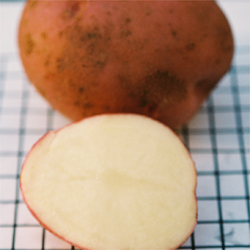 |
Batoche
Medium-large oval-blocky tuber, pale red skin with creamy white flesh. Bred by Ag Canada as a cross of Redskin x Scoff 2774-3R, released in 1963. Great potential for the 99 pounds yield. Tall Vines Source: ME BO W08 Local grower: Curzio What's the best use in the kitchen for this starchy, multi-purpose variety? |
|||||||||||||||||||||
| Bauer Gruen Rotes Auge
Medium-small round-oblong tubers, yellow skin with "red eyes" and yellow flesh. An heritage variety in Canada that originates from Germany. The name Bauer Gruen translates to Farmer Green (also spelled Grün), where Rotes Auge is Red Eye. Sets true seed pods even grown in a potato growing bag. Source: AgriCanada 09 Local grower: Curzio Grown in an 18" tall bag in 2013 it set tubers high and produced 30oz, 19 tubers, of which 6 standard, 12 mini and just one micro. Improved harvest by 50% compared to 2011 growth in a 14" black bag. |
||||||||||||||||||||||
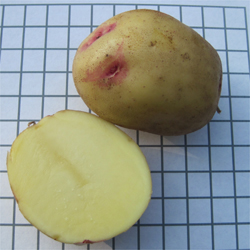 |
||||||||||||||||||||||
| Harvest yield further improved in 2014 with 4 tubers producing 43.5 oz, 11 standard and 4 mini. Flagged for 2015 with 5 tubers.
What is the best use in the kitchen for this waxy tuber? We tasted this potato and found it creamy with a nice nutty aftertaste. The skin is medium-thin, slightly bitter. Try to boil and toss in a fresh green salad, like this wonderlful fresh dandelion salad. |
||||||||||||||||||||||
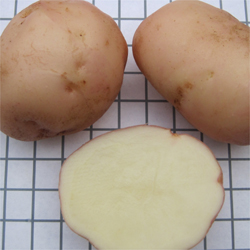 |
Beauty of Hebron
Medium-large, round to oblong tubers. Pink skin. A seedling of Garnet Chili would make it a sister of Early Rose, released in1876 at an Annual Agricultural Society Meeting in Marblehead, MA. Grown in 2014 in a 14" Poppy Orange bag, 4 tubers produced 43 oz, a total 34 tubers for 43 oz, of which 6 standard sized, 25 mini and just 3 micro. |
|||||||||||||||||||||
| Source: ME BO W07 Local grower: Curzio
What's the best use in the kitchen for this waxy, multi-purpose variety? We tasted this potato roasted and found it quite flavorful. |
||||||||||||||||||||||
| Belle de Fontenay
Horn-shaped light yellow tubers of French origin, released in 1885. Very early tuber maturity (harvest 2009 rather late - check early maturity in 2010). GRIN: PI 200115 Source: WA MC C08 Local grower: Curzio Best use in the kitchen: Reported to be waxy ... may be good for a newly discovered Southern Italian recipe that calls for waxy, yellow fleshed tubers. |
||||||||||||||||||||||
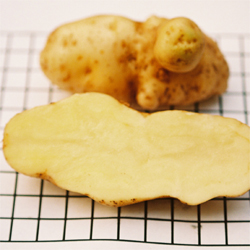 |
||||||||||||||||||||||
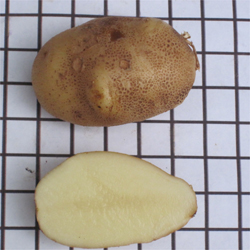 |
BelRus
Medium - large oblong tubers, heavily russeted dark skin, shallow eyes bonded by smooth white skin, dense flesh. Very early maturity for a Russet. Resistant to disease. Features shallow root system. This variety was bred by USDA/Beltsville, MD from Penobscot x W 39-1, released 1978. GRIN: AV4 Source: MEBOW07 Local grower: Curzio Grown in a 14" Poppy Orange bag it only produced 7 tubers, 9.25 oz, 2 small tubers and 5 mini, no micro. In 2014 I'm planning to grow one bag in a hoophouse to see if I can get an extra early crop. BUT I don't expect the size to grow to what is needed for a good baking potato. |
|||||||||||||||||||||
| Starchy potato variety, excellent for baking and frying. | ||||||||||||||||||||||
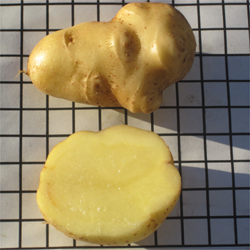 |
||||||||||||||||||||||
| Bevelander
Medium-small round to oval tubers with yellow skin and light yellow flesh. Released in 1925 in Holland as a cross of Bravo x Preferent. GRIN: PI 223726 Source: ME BO W10 Local grower: Grown in a 14" Poppy Orange bag it only produced 7.5 oz, 14 mini and 6 micro. In 2014 I'm planning to grow one bag in a hoophouse to see if I can get an extra early crop, plus increase production. Variety flagged for dropping from this collection. |
||||||||||||||||||||||
| What's the best use in the kitchen for this starchy variety? We tasted this potato and found it flaky, with good taste, like a bake potato but small in size. | ||||||||||||||||||||||
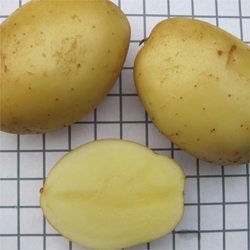 |
Bintje
Medium - large, blocky to oblong yellow tubers, reported to be the most widely grown yellow potato worldwide. Old Dutch variety was bred by K.L. deVries a cross of Munstersen x Fransen, released 1910. Tall Vines, high setting and reported to grow serial tubers. GRIN: PI 407417 Source: Fe5 09 Alt Source: CV Ron CV Ma23 Local grower: Curzio Grown in 2011 6 mini in a 14" Poppy Orange bag produced 22 oz, 42 tubers, 2 standard, 18 mini and 22 micro. |
|||||||||||||||||||||
| Grown in 2013 in an 18" tall bag, 2 seed pieces produced 20.5 oz, 10 tubers, including 3 standard in the 5 oz range, 3 mini and only 4 micro. The 2013 test clearly shows that the additional 4" of compost produce larger tubers.
Grown in 2014 in two 14" Poppy Orange bags (planted earlier) and compared 2 vs 4 starting tubers. The 4 tuber bag yielded one of the highest crops ever for me in bags: 102 oz, 93 tubers, of which 15 above 2 oz and 55 mini, plus 23 micro. As expected the 2 tuber bag produced much less, 69 oz for 44 tubers, with 14 standard (almost the same as the 4 tuber bag), 55 mini and 23 micro. This record yield is expected to be surpassed in 2015 testing 4 vs 5 starting tubers in 18" bags planted one month earlier in the potato hoophouse. Best use in the kitchen: A starchy cultivar, most widely grown variety in Italy - especially grown especially for gnocchi. We have tasted this potato and found it flaky with good flavor. The skin is med-thick which is excellent to boil for gnocchi - the potato should be boiled with the skins to keep the flesh as dry as possible. |
||||||||||||||||||||||
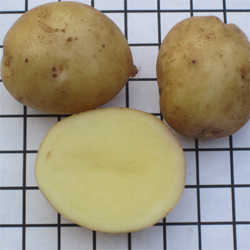 |
Birgitta
Medium sized oblong tuber, buff yellow skin with creamy pale yellow flesh. A cross of Magnum Bonum x Badera, released in Sweden in 1924. Taste is reported to be good to excellent. Rare variety. Source: ME BO W08 Local grower: Curzio Grown in 2013 in an 18" tall bag - 3 mini seed tubers produced 14.5 oz, 24 tubers, almost all of consistent size [see picture]. I'm impressed by the layers of stolons structure and hope this variety will produce higher yields with greater seed crowding; in 2014 we shall compare 4 vs 6 mini starting seed. |
|||||||||||||||||||||
| What's the best use in the kitchen for this waxy tuber? We tasted this potato and found it creamy, with good flavor and a bitter aftertaste. The skin is medium thick and bitter, but it peels off very easily after cooking. It probably makes great pan roasted small potato, cooked cut or whole. | ||||||||||||||||||||||
| Bjorna
Medium sized, slightly flattened oval tubers with middle-deep eyes. The skin is dark purple with lavender blotches and the flesh is a stronger yellow. Björna is a rather early landrace, which has been grown in Jämtland, Sweden. GRIN: PI 607483 Source: ME BO W09 Local grower: Curzio |
||||||||||||||||||||||
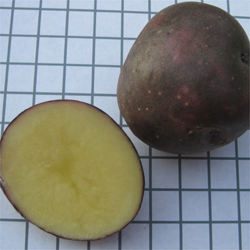 |
||||||||||||||||||||||
| What's the best use in the kitchen for this starchy tuber? We tasted this potato and found it very flaky and dry. It features a mild flavor with medium thick skin. Probably a good choice to use a soup thickener. Or roasted rather than boiled as it would fall apart. | ||||||||||||||||||||||
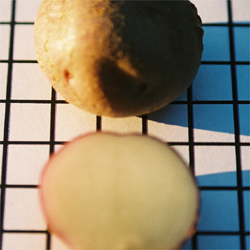 |
Blå Dalsland - see many AKA names
Small, round, dark purple tubers, white flesh, from Nordic Genebank, Sweden. Also known as Blåpotatis, Finnmarkspotatis, Hästeberget, Svart Dalsland, Svarta, Svartpotatis (in Swedish); Karungin musta, Kuusamon tumma, Lopen musta, Musta maatiainen, Musta peruna, Vanha musta (Finnish), Nordgårdspotet, Sort fra O. Helfe (Norwegian). Source: MI B07 Local grower: Curzio |
|||||||||||||||||||||
| Seems to be a waxing potato with thin skin - try to pan roast with skin. | ||||||||||||||||||||||
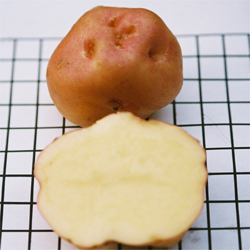 |
Black Mignion, The Cup (aka Cups)
A heritage variety, submitted by George Brinson, Carmanville, NL. This variety has been grown in the area, by members of the Brinson family, since 1870. Seems to be the same as Cups - we grow this variety as the Canadian strain to compare with the Brittish strain - in 2010 they will be planted at the same time next to each other to compare (Cup is not growing Tall Vines). Tall Vines Has grown a seed berry in 2013 Source: AgriCanada 09 Local grower: Curzio |
|||||||||||||||||||||
| When I first ate a Cup tuber it seemed starchy and falls apart easily, but Black Mignion hold the shape well - still the variety is starchy and dry, with a light earthy flavor, a light hint of chestnut. The skin is thin and keeps a nice color hue after cooking.
What's the best use in the kitchen for this starchy variety? Mini tubers must make a fantastic side dish of pan roasted potato with rosmary. |
||||||||||||||||||||||
| Blauschalige Bristen
Blauschalige = blue skinned, Bristen is a Swiss Town in Central Switzerland. A Heritage variety with deep eyes in a dark blue skin and cream flesh. It produces seed berries. Source: PSR Local grower: Curzio Grown in 2013 in a 14" Poppy Orange bag 6 mini tubers produced 18.5 oz, 25 tubers, of which 2 standard [see picture], 13 mini and 10 micro. Flagged to be tested in 2014 with 4 mini as starting seed. |
||||||||||||||||||||||
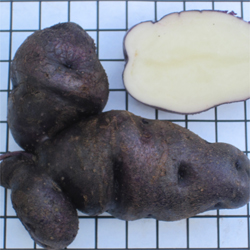 |
||||||||||||||||||||||
| What's the best use in the kitchen for this starchy variety with interesting buttery flavor? We tasted this potato and found it flaky, with good flavor. The skin is medium-thick with a bitter aftertaste. The skin keeps a strong blue color after cooking and it makes a great presentation pan-roasted with green beans. | ||||||||||||||||||||||
| Blauwe Eigenheimer, Purple Skinned E.
Medium-large oval to oblong tubers. A variation of the Dutch variety Eigenheimer, released in Austria in 1907. Tall Vines Source: ME B0 W09 Local grower: What's the best use in the kitchen for this starchy variety with interesting skin color? |
||||||||||||||||||||||
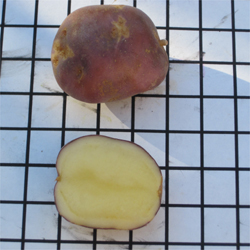 |
||||||||||||||||||||||
| Bleu d'Auvergne
Medium-small round to oval to tubers. A blue skin, blue flesh variety from France, features determinate vines and is much earlier than any other blue fleshed. Source: AN J 11 Local grower: We tasted this potato and found it starchy, as it is expected with most purple fleshed tubers, but this variety features a slightly bitter, thick skin; good pairing boiled with fish. |
||||||||||||||||||||||
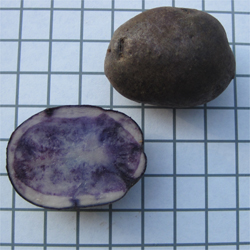 |
||||||||||||||||||||||
| Very low producer but a keeper because the tubers taste really good and buttery, unlike most blue fleshed varieties.
What's the best use in the kitchen for this starchy variety? |
||||||||||||||||||||||
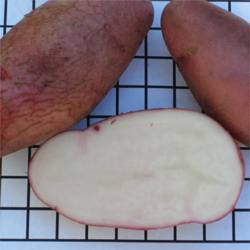 |
||||||||||||||||||||||
| Blossom
Medium - large, long to oblong tubers which may appear as fingerlings, with dark red skin and very light pink flesh. Sets true seed pods I keep growing this variety because it matures seed berries at my latitude in Kenosha. Source: CV Ron 10 Alt Source: CV Ron Local grower: Curzio |
||||||||||||||||||||||
| What's the best use in the kitchen for this starchy variety? We have tasted this potato as part of an event with 2 Chefs who compared 11 different red fleshed varieties. Blossom was rated second worst in taste, only barely better than Red Thumb. Very little red color retention after cooking. | ||||||||||||||||||||||
| Blue Butterball
Medium-small tuber harvested from a vine grown from TPS German Butterball seed which must have crossed with one of the many blue varieties grown in my garden. The TPS was harvested by my neighbor Rich. I have 3 vines started from TPS to compare for similarity in 2012. Source: SZ R09 from TPS Local grower: Curzio Grown in 2013 in an 18" tall bag, 3 tubers only produced 10 oz, 13 tubers, 10 mini and 3 micro. Usually such small yield would NOT point to further testing in 18" tall bags! |
||||||||||||||||||||||
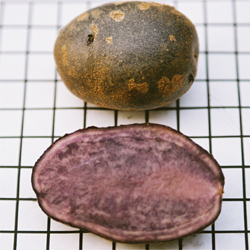 |
||||||||||||||||||||||
| But at harvest time in 2013 I noticed that larger tubers were attached higher on the vines - it is rare to find larger tubers high and smaller clustered around the seed placement. Also the tall bag possibly provided more strength to the vine which produced a seed berry.
Good storage - what's the best use in the kitchen for this starchy variety? |
||||||||||||||||||||||
| Blue Butterball Russet
Medium-large tuber with dark purple russetted skin and blue flesh. I named the variety in 2014 after growing it 3 years as TPS 2011. It will be planted next to the parent Blue Butter and compared for yield and seed berry production. Grown in 2014 in a 18" bag, 4 tubers produced 37 oz, 38 tubers, of which 3 over 2oz., 30 mini and 5 micro. |
||||||||||||||||||||||
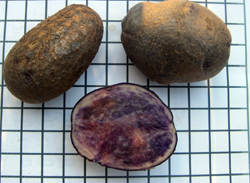 |
||||||||||||||||||||||
| What's the best use in the kitchen for this starchy variety? We have tasted this potato and found it flaky, but not too dry and buttery. It features a medium-thick skin. | ||||||||||||||||||||||
| Blue Gold, aka Peter Wilcox, Purple Sun
Medium-large tuber with dark purple skin and dark yellow flesh. One of the best market sellers for SSE Member OR DR A. A cross of B0810-1 x B0918-5 (Beltsville breeding clones), released in 2007 - Antioxidants: Carotenoid content is 15% higher than Yukon Gold with predominant carotinoids being zeaxanthin and lutein. Vitamin C: over 40% of RDA. Also reported to set tubers high, wider spacing in the furrow is recommended. |
||||||||||||||||||||||
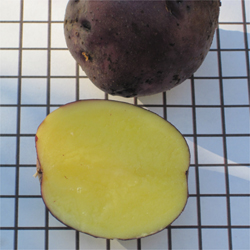 |
||||||||||||||||||||||
| Grown in 2013 in a 14" bag which I've started in a hoophouse to test for an earlier crop - it yielded 41.5 oz, 50 tubers, of which 1 standard, 34 mini and 15 micro. Also, to compare, I planted 3 tubers in an 18" bag which yielded 27 oz, 33 tubers, of which 1 standard, 24 mini and 8 micro. I recognized more "wannabe" tubers on stolons which did not bulk - the comparison shows this variety sets tubers high but does NOT produce higher yields in the taller bags. In 2014 I'm planning to grow 2 bags to compare the benefit of seed crowding with 4 mini seed tubers vs 6.
Source: OR DR A 11 Alt Source: CV Ma23 Local grower: Curzio What's the best use in the kitchen for this large, multi-purpose, waxy variety? Reported to feature a full earthy flavor with hints of hazelnuts. We tasted this potato and compared it with Koto pan-fried with olive oil and butter - side dish for trout - we found the potato to be quite tasty, creamy, with medium skin. Compared to Koto, Purple Sun did NOT fare as well. |
||||||||||||||||||||||
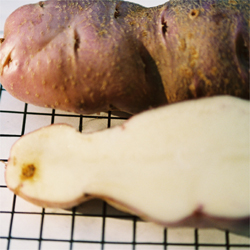 |
Blue Goose
Medium-large sized oblong tuber, purple skin and cream flesh. Many tubers grow large (5-6" long). Vines grow very tall. Rare variety. Great potential for the 99 pounds yield. Very Tall Vines Source: ME BO W08 Local grower: Best use in the kitchen: We suggest to use this tuber for really Crisp Roasted Potatoes - the shape is perfect to cut 1/2" disks that will turn crisp, while the inside stays velvety moist. |
|||||||||||||||||||||
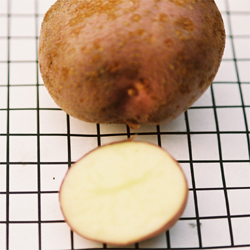 |
Blue Mac
Medium-large sized round tuber, with stem-end slightly flattened, purple skin and white flesh. Released by AgriCanada in 1979 as a cross of Arran Victory x And5-142 with resistance to Potato Wart Disease. Tall Vines Source: AgriCanada 09 Local grower: Curzio What's the best use in the kitchen for this large, multi-purpose, waxy variety? |
|||||||||||||||||||||
| We tasted this potato and found it creamy with a thin skin. | ||||||||||||||||||||||
| Blue of Sweden
Medium-large, long-oval tubers with dark blue skin and flesh - an other name for Congo, All Blue - or is it a different cultivar? DNA finger-printing is not giving us the final answer yet, but in this picture you can see a brighter purple hue, compared to the Russian Blue (partially shown on the right). All Blue seems to have deeper eyes. Sets true seed pods Source: PSR Local grower: FredB |
||||||||||||||||||||||
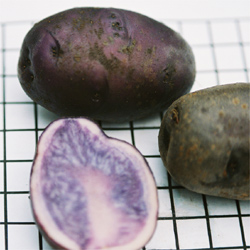 |
||||||||||||||||||||||
| What's the best use in the kitchen for this starchy variety? The potato cooks up sweet with flesh which melts in your mouth, the skins are thicker and chewy. | ||||||||||||||||||||||
| Blue Pride, AC Blue Pride
Large, oval to oblong growing, very dark blue skin and pale yellow flesh with purple streaks. Bred by AgriCanada in St. John's, NF, from the cross (N713-16 x N889-78-3). N713 received from Scotland, while N889 was a seedling of Anson. Released in 1994. Sets true seed pods. Grown in a red SmartBag in 2011 - 6 vines yielded 24 oz. of tubers, 14 in med size, no mini tubers and just 6 micro. The lack of mini tubers suggests tuberization at higher temps .. as the soil in SmartBags is much warmer than for traditional field plantings. Good Heat Tolerance |
||||||||||||||||||||||
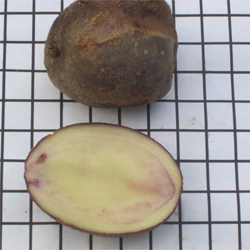 |
||||||||||||||||||||||
| Source: ME BO W09 Local grower: Curzio
What's the best use in the kitchen for this potato good for boiling? We tasted this potato and found it waxy, with thicker skin. |
||||||||||||||||||||||
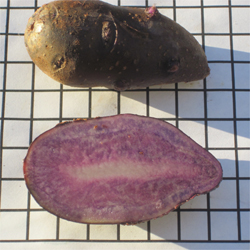 |
||||||||||||||||||||||
| Blue Tom Cat
Large fingerling type, very dark blue skin and blue flesh. A Tom Wagner breed reported to. Sets true seed pods - the seed pods are dark green. |
||||||||||||||||||||||
| Source: ME BO W09 Local grower: Curzio
What's the best use in the kitchen for this starchy potato? |
||||||||||||||||||||||
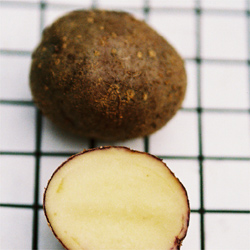 |
Blue Shetland (aka Shetland Black)
Jim tells me: I got the Blue Shetland seed from Bonsall because of the unusual color of this seed - blue skin and creamy yellow flesh with a blue "ring" in the flesh. If I do a good job of growing them and have a favorable year the seed or tubers get a little bigger than the largest tubers I send to you, but they never get very big. The largest are under 3 inches in diameter. I wonder if the small size is a characteristic of this variety or if my seed has a virus that is resulting in stunted growth. |
|||||||||||||||||||||
| The vines are also very short, not more than 18 inches tall. Mid-season maturity, originally from Scotland. Also reported to have higher content of peonidin, an antioxidant of the anthocyanidins class.
Source: MN TJ J07 - Local grower: BR F Description to be reviewed: Seems to be a waxing potato with thin skin - try to pan roast with skin. The shape and size of this cultivar seems to be consistantly small. |
||||||||||||||||||||||
| Blue Victor
Medium-large heirloom variety, round-flat, dark blue tubers, white flesh, few insects or disease problems, tolerates cool nights, keeps well, fine eating, one of the first blue varieties grown in USA (see low GRIN # - AV stands for American Variety). SSE Member Dean Reedy claims: 'Appears to have come from Mellen, WI from the Hans Dietrich farm in the 1940s, when sons Hans and Walter discovered the cross. Possible cross of Rural New Yorker and Red Ohios. |
||||||||||||||||||||||
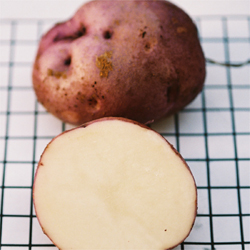 |
||||||||||||||||||||||
| Tuber set is quite deep. Grows vigorous vines and produces lots of true seed pods.
GRIN: AV 6 Source: ME BO W91, MI B07 Local grower: Curzio What is the best use in the kitchen for this multi-purpose variety? We have tasted it and found it a little flaky, tending to be waxy, sweet and earthy. The skin is very thin. |
||||||||||||||||||||||
| Blue Vic TPS 2010-1
Blue Victor [GRIN: AV 6] is one of the oldest blue skinned varieties grown in USA - here in Kenosha at 42.5822° N latitude - it is the most consistent seed berry producer. I'm posting these pictures and descriptions to show how diverse tubers produced with open pollinated seed may develop. This picture shows tubers grown from mini tubers saved and replanted for 3 years. See picture of Blue Vic TPS 2010-3 to see the three tubers harvested from 3 different vines in 2010. Blue Vic TPS 2010-1 produces seed berries. |
||||||||||||||||||||||
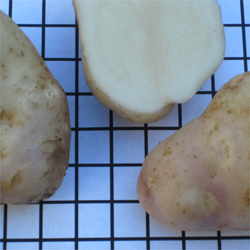 |
||||||||||||||||||||||
| Notice the light violet blush surrounding the eye in otherwise yellow colored skin. The flesh is constistent with the parent tuber.
Source: Curzio 2009 Local grower: Curzio Planted in 2013 3 in a 14" black growing bag - 3 mini tubers produced 35 oz, 24 tubers, of which 7 above 2 oz, 12 mini and 5 micro. Flagged for planting in 2014 in a 14" tan bag with 4 mini as starting seed to check if we can increase the yield. We have tasted this potato and found it flaky, with a nice, mild flavor. The skin is thin. |
||||||||||||||||||||||
| Blue Vic TPS 2010-2
Blue Victor [GRIN: AV 6] is one of the oldest blue skinned varieties grown in USA - here in Kenosha at 42.5822° N latitude - it is the most consistent seed berry producer. I'm posting this picture and description to show how diverse tubers produced with open pollinated seed may develop. This picture shows tubers grown from mini tubers saved and replanted for 3 years. See picture of Blue Vic TPS 2010-3 to see the three tubers harvested from 3 different vines in 2010. Blue Vic TPS 2010-2 produces seed berries. |
||||||||||||||||||||||
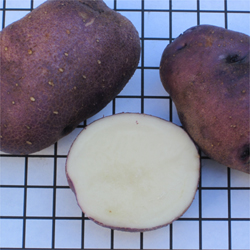 |
||||||||||||||||||||||
| Notice the skin color is a darker purple, seems darker than the parent. The flesh is constistent with the parent tuber.
Source: Curzio 2009 Local grower: Curzio Planted in 2013 in a 14" black growing bag - 3 mini tubers produced 27 oz, 19 tubers, of which 8 above 2 oz, 7 mini and 4 micro. Flagged for planting in 2014 in a 14" tan bag with 4 mini as starting seed to check if we can increase the yield. We have tasted this potato and found it flaky, with more earthy flavor compared to Blue Vic TPS 2010-1. The skin is medium-thin. Clearly thicker and slightly bitter. |
||||||||||||||||||||||
| Blue Vic TPS 2010-3
Blue Victor [GRIN: AV 6] is one of the oldest blue skinned varieties grown in USA - here in Kenosha at 42.5822° N latitude - it is the most consistent seed berry producer. I'm posting this picture and description to show how diverse tubers produced with open pollinated seed may develop. This 2010 picture shows tubers grown from botanical seed harvested in 2009 and consequently named Blue Vic TPS 2010 1 - 2 - 3. |
||||||||||||||||||||||
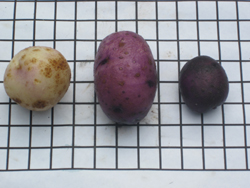 |
||||||||||||||||||||||
| Blue Vic TPS 2010-3 HAS NOT produced any seed seed berries at this time [2013].
The tuber shape seems more similar to the parent, round and flat. This skin after 3 seasons of re-planting still seems darker than Blue Vic TPS 2010-2. Source: Curzio 2009 Local grower: Curzio Planted in 2013 in a 14" black growing bag - 3 mini tubers produced 10.5 oz, 9 tubers, of which 3 above 2 oz, 3 mini and 3 micro. Flagged for planting in 2014 in a 14" tan bag with 4 mini as starting seed to check if we can increase the yield. We have NOT tasted this potato yet - flagged to be compared to the siblings. |
||||||||||||||||||||||
| Bonnie Dundee
A British variety released in 1962 - listed by Europotato as very early, featuring a pale yellow to yellow flesh and red skin, with an oval to round tuber shape, firm flesh texture. Source: LA D 12 Local grower: Curzio Planted in 2013 3 mini tubers in a 18" Tan growing bag - harvested early: ONLY 9 oz - 24 tubers total - 0 above 2 oz, 17 mini and 7 micro. Planning to test starting bags in a hoophouse to obtain extra early harvest. Also testing 3 vs 5 mini seed tubers to optimize seed crowding and check if this variety loves seed crowding. Bonnie Dundie sets very high, but the stolons don't bulk high. I found most tubers clustered around the seed piece. In 2014 I test them in 14" growing bags. |
||||||||||||||||||||||
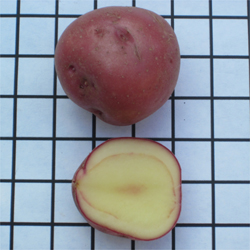 |
||||||||||||||||||||||
| What's the best use in the kitchen for this waxy potato? We tasted this potato and detected a distinctive bitterness with a metallic aftertaste, although creamy and flavorful. It features a medium-thick skin which peels off very easily after cooking. The red skin transfers a nice pink to the flesh. Perhaps it would make a nice pan roasted potato, or boiled and peeled to reduce the bitterness and show off the pink flesh color. | ||||||||||||||||||||||
| Bonnotte (aka Bonnotte de Noirmoutier)
Possibly the most expensive market potato in the world - fetched up to $350 / pound in France. French culinary masters cannot wait to put their hands on the very earliest tubers. These are grown in beds of sea weeds on the West Coast of France Island of Noirmoutier. Source: AN J 11 Local grower: Curzio For 2015 planning to start in potato hoophouse to test if early planting can further increase the yield. Grown in 2014 in a 14" Poppy Orange bag, 4 mini tubers produced 32.5 oz, 31 tubers, mostly mini tubers below the 2 oz weight range. |
||||||||||||||||||||||
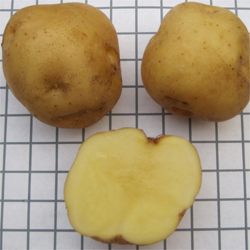 |
||||||||||||||||||||||
| What's the best use in the kitchen for this waxy potato? We tasted this potato and found it * wonderful *, tasty with creamy, thick flesh and medium skin. Certainly worth the reputation it has in France! | ||||||||||||||||||||||
| Bora Valley
Large, oval to oblong growing, purple skin and purple flesh. Registered variety in Korea, bred by Dr. Lim. For 2013 I'm listing this variety with SSE as LQ > please order from Bill Minkey (WI MI B). This variety is grown in Korea for raw eating - NOT a cooking potato! GRIN: PI 634776 Source: MI B09 Local grower: Curzio |
||||||||||||||||||||||
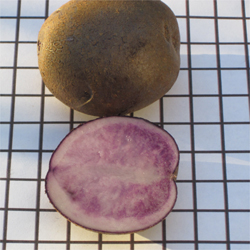 |
||||||||||||||||||||||
| What's the best use in the kitchen for this potato? It is listed on the Korean web pages as a raw eating variety! I cooked it .. but it is definitely better eaten raw, uncooked. Who has recipes for raw potato? | ||||||||||||||||||||||
| BP1
Large - medium tubers very popular in Zimbabwe. It was donated to the US Genebank from South Africa for the resistance to high temperatures. The variety was released in 1958 as a cross of (South Esk x Shamrock) x Saranac by breeder Van der Planck. Source: US Genebank 2014 Local grower: Curzio What's the best use in the kitchen for this starchy potato? |
||||||||||||||||||||||
 |
||||||||||||||||||||||
| Brigus
Large, round to oval growing, purple skin and cream to yellow flesh. A cross of G64-124.5p x SJ.62.26-9 - both parents selected for resistance to wart disease. G64 was a blue skinned, yellow fleshed obtained by Gary Johnson at UoG - a parent was an Andigena cultivar from Cuzco, Peru. While SJ62 was a sister seedling of Pink Pearl (a cross of Ultimus x Katahdin) Sets true seed pods. Source: ME BO W09 Local grower: What's the best use in the kitchen for this starchy potato? |
||||||||||||||||||||||
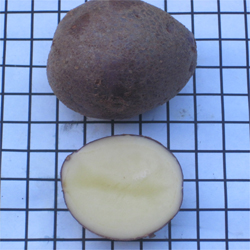 |
||||||||||||||||||||||
| British Columbia Blue
Medium-large sized long, cylindrical tuber, with dark blue skin and flesh. Original seed piece obtained from Alex Caron in 1984 and is kept in the Canadian Repository as a separate cultivar even if potential identical with the many Congo (All Blue) varieties. Will Bonsall speculates that all the blue tubers may have Solanum phureja ancestry. Source: AgriCanada 09 Local grower: |
||||||||||||||||||||||
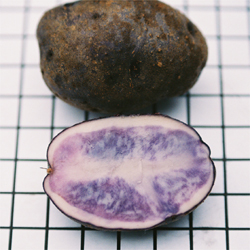 |
||||||||||||||||||||||
| Best use in the kitchen: we are looking forward to test all the different blue tubers to verify if there are differences in cooking results. For instance it would be interesting to compare how different blue potato keep the blue color in cooking. Please visit www.davesgarden.com where I have posted pictures of this potato pan cooked.
This is the first variety I'm listing in 2011 as "best grown in bags" as the 2010 season was rather poor to define other good ones. Please return to this catalog for better results after the 2011 season. Click here for more info on growing in bags.
|
||||||||||||||||||||||
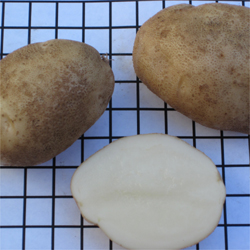 |
Butte Russet
Large, flat, oblong tubers. High protein, high vitamin C, good keeper, mid season, moderate resistance to disease. Bred by USDA and ID, OR and WA AES in 1972, from A 492-2 x Norgold Russet. GRIN: AV 7 Source: ME BO W07, SSE 1037 Alt Source: CV Wo6 Local grower: Curzio Grown in 2013 in a 14" black bag, 3 tubers produced 24 oz, 20 tubers, of which 4 above 2 oz, 12 mini and just 4 micro. This type of potato is NOT the first choice for growing potato in containers! |
|||||||||||||||||||||
| Most varieties which have been bred for processing as fries will NOT grow to standard size in containers where seed pieces are too crowded for these varieties. Butte Russet may be acceptable if you don't mind to cut short fries.
Butte Russet is one of the many russeted varieties bred to replace Russet Burbank .. but which did not succeed. 100 years later Russet Burbank is still the most grown russet type potato in USA. We have tasted this potato and found it flaky and dry, as expected for this variety. The taste is good, even for the skin which is medium thin if you don't allow the tubers to set thicker skins. |
||||||||||||||||||||||
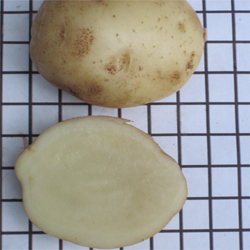 |
Cain's Irish Rocks
Major differences between Cain's and Lumpers in appearance, and in who ate the majority of them in Ireland, circa 1825. Cain's, with it's smoother appearance, was preferred by wealthier Irish, who didn't depend on it for their sole source of nourishment like those who used Lumpers. Planted in 2013 3 mini tubers in a 14" Poppy Orange growing bag - harvested early: 39 oz - 52 tubers total - 46 mini and only 6 micro. Planning to test starting bags in a hoophouse to obtain extra early harvest. Also testing 4 vs 6 mini seed tubers to optimize seed crowding. This variety loves seed crowding. |
|||||||||||||||||||||
| Source: AgriCanada11 Local grower: Curzio
What's the best use in the kitchen for this starchy variety? |
||||||||||||||||||||||
| Calico
Medium-large sized cylindrical tuber, lightly russeted light brown skin (note light purple skin markings at both the stern and blossom ends) and cream flesh. Reported to be an old Irish variety. Very Tall Vines Sets true seed pods. Grown in 2013 in a 14" Poppy Orange growing bag - early harvest: 2 starting tubers produced 21.5 oz - 20 tubers, 2 standard - 15 mini and 3 micro. Planning to test in 2014 to start bags in a hoophouse to obtain earlier vine emergence, plus testing 3 vs 5 mini seed tubers to evaluate benefit of seed crowding in the growing bags. |
||||||||||||||||||||||
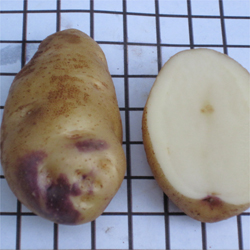 |
||||||||||||||||||||||
| Source: ME BO W08 Local grower: Curzio
What's the best use in the kitchen for this starchy variety? We tasted this potato and detect a little bitterness, a hint of root-like carrot. Skin is thin. |
||||||||||||||||||||||
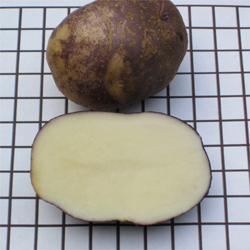 |
||||||||||||||||||||||
| O'Higgins Calico
Medium-large sized oblong tuber, mostly purple skin with yellow patches and cream flesh. A variety from the collection of Bill Higgins, Christmas Island, Nova Scotia - a seedling of Black Rocks TPS. Source: HI B11 Local grower: What's the best use in the kitchen for this starchy variety? |
||||||||||||||||||||||
| Calrose
Medium - large oblong tubers with yellow skin and white flesh. A cross of Ackersegen x Katahdin released by USDA in 1946 - rare cultivar - Jeff reports this tuber to be a good keeper. In 2011 grown in a black SmartBag - 6 seed pieces yielded 3 pounds of tubers - 14 in standard size (incl. 2 tubers in record size for my SmartBags - one at 11 oz and one at 8 oz) and only 12 micro tubers. As the soil in black bags is much warmer than for traditional field plantings, the number of standard sized tubers (but few micro) may well be a sign of great Heat Tolerance. |
||||||||||||||||||||||
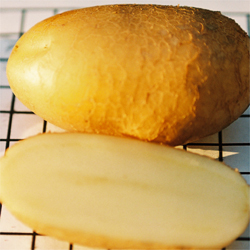 |
||||||||||||||||||||||
| Source: VT BI J08 Local grower: Curzio
What's the best use in the kitchen for this starchy tuber? We tasted this potato which cooks boiled in 20 minutes to a creamy flesh melting in your mouth. We detected a hint of butter flavor. The skin is medium thick, slightly russeted which adds to the pleasant flavor. |
||||||||||||||||||||||
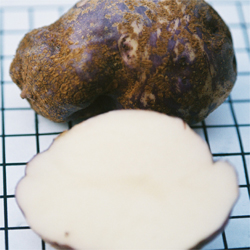 |
Calwhite
Large, oblong white tubers, rough to netted buff skin, medium deep eyes, intermediate in number, evenly distributed; slightly prominent eyebrows; white flesh. Very high yielding variety with few tubers per plant. Spacing between plants should be very close to avoid oversize tubers. A cross of Pioneer x BC8370-4 released in 1995. GRIN: AV 54 Source: ME BO W07 Alt Source: CV Ron Local grower: TY M |
|||||||||||||||||||||
| Great for fryes. | ||||||||||||||||||||||
| Candy Cane
Many of the wild and primitive relatives of the potato are diploid (24 chromosomes instead of 48). Candy Cane is a diploid cultivar, named by Dr. Coffin, UoGuelph, Ontario for the red stripes in the flesh (candy cane like pattern) of the raw tuber. Color intensity may vary for different soil pH and trace elements. The pattern is lost after cooking. Fingerling type tuber. Source: AgriCanada 09 Local grower: What's the best use in the kitchen for this very special variety? |
||||||||||||||||||||||
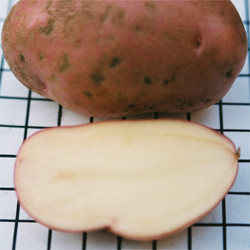 |
||||||||||||||||||||||
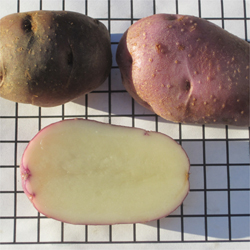 |
||||||||||||||||||||||
| Cape Breton Blue Blacks
Large, oval to oblong growing, very dark blue to light purple skin and pale yellow flesh. The tubers have tendency to grow above the soil line and turn black if exposed to light. This heirloom variety from the Iona Community on Cape Breton Island of Nova Scotia - Duncan Boniface MacNeil is reported to have grown this heirloom variety. Sets tubers quite high on the vines. Seems to be a good choice for growing in container. |
||||||||||||||||||||||
| Source: ME BO W10 Local grower: Curzio
We tasted this potato and found it to have a nice taste, very creamy, with a hint of nutty aftertaste which reminds us of acorn. It features a thin skin. What's the best use in the kitchen for this very tasty, waxy potato? |
||||||||||||||||||||||
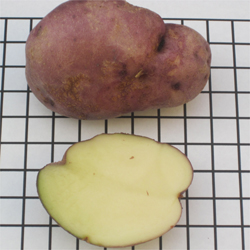 |
Caribe
Medium - large oblong purple tubers, with white flesh. Bright purple skin color fades in storage. It grows quite large in ideal conditions. Rich flavor. Vines dry out early. Tall Vines + tendency to grow above soil level (notice green color in the flesh - sign of a tuber exposed to sun light). Bred by AgCanada and released in 1969. Source: Fe5 09 Alt Source: CV Ron and CV Wo6 Local grower: Best use in the kitchen: Cooked in my vegetable breakfast, boiled for about 30 min., potato chunks keep the shape quite well. |
|||||||||||||||||||||
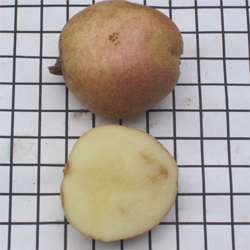 |
||||||||||||||||||||||
| Cariboo
Medium - large, oval to oblong growing, light-flaked, buff colored skin with pink blush and white flesh. Very rare variety from Canada - a cross of K113-1 x 1256A(23) released in 1968. Reported to grow extremely tall vines - which tangle farming equipment and therefore this variety was banned to take this feature out of the genetic pool of modern varieties. Source: AgriCanada 10 Local grower: Curzio |
||||||||||||||||||||||
| Interesting story about this variety - see this link.
What's the best use in the kitchen for this starchy potato? |
||||||||||||||||||||||
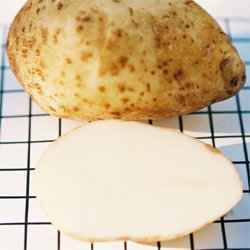 |
Century Russet
Large, oblong white tubers, long and cylindrical to slightly flattened. Skin is lightly and uniformly russeted. Eyes medium-shallow with a distinct eyebrow, moderate in number and evenly distributed. Highly resistant to disease but needs to be planted in warm soil to avoid seed rot. Released in 1995. GRIN: AV 55 Source: ME BO W07 Local grower: BR F |
|||||||||||||||||||||
| Good for boiling and baking but despite high density of the flesh, this variety does not process well for fries (commercial processing?) may still do great fryes in home cooking. | ||||||||||||||||||||||
| Charlotte
Large, oval to oblong French tubers, with yellow skin and pale yellow flesh. A cross of Hansa x Danae released in 1981. Grown in a black growing bag in 2011 - 6 vines yielded 28 oz. of tubers, 15 in med size, and just 2 mini and 6 micro. The lack of mini tubers suggests tuberization at higher temps .. as the soil in growing bags is much warmer than for traditional field plantings. |
||||||||||||||||||||||
 |
||||||||||||||||||||||
| The bag with 3 starting tubers produced 1 oz more than the bag with 5. Therefore this variety is now flagged for the comparison of 2 vs 4 tubers. The Extra Early planting extended the vine life by 20 days but did not increase the yield compared to 2013.
Source: OR DR A11 Local grower: Curzio What's the best use in the kitchen for this waxy potato? We tasted this potato and found it to be creamy, with a nutty mild flavor. It features a medium thin skin. Cooks up great in pan roasted potato dishes. |
||||||||||||||||||||||
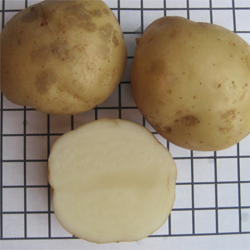 |
Chellan
Medium-large, white block tubers. A creation of Tom Wagner as a cross of Chellah, a fairly new Irish bred potato and a un-named seedling that had great late blight resistance. Members of the Kenosha Potato Project on Facebook report this to be a great producer. Source: WA HO C14 Local grower: Curzio |
|||||||||||||||||||||
| We tasted this potato and found it flaky and dry, with good earthy flavor. The skin is thin. What is the best use in the kitchen for this starchy tuber? | ||||||||||||||||||||||
| Chiar Choque Pitu
Small round, flat tubers grown on a very different plant belonging to the S. curtilobum group - interesting because this is the only pentaploid potato in this collection [60 chromosomes instead of 48]. Curtilobum is Latin for short leaves - and I guess that reflects to LONG season. This plant grows TALL VINES, but the first year I was only able to get 3 tubers. GRIN: PI 604207 Source: US Genebank 13 Local grower: Curzio |
||||||||||||||||||||||
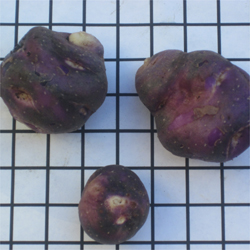 |
||||||||||||||||||||||
| Flagged to be started in a hoophouse in 2014 toexperiment if a longer season increases the yield. | ||||||||||||||||||||||
| Chiloe Ancud
Medium - small round tubers - likely a landrace from Chile, as Chiloe is the name of the archipelago just off the coast of Puerto Montt. Source: OR DR A11 Local grower: Curzio |
||||||||||||||||||||||
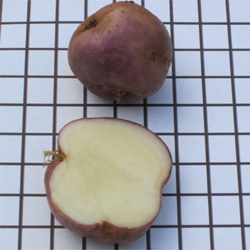 |
||||||||||||||||||||||
| What's the best use in the kitchen for this very tasty, waxy potato? We tasted this potato and found it starchy, with a good earthy flavor. The skin is medium andis likely a good choice for roasting or to cook whole in a soup. | ||||||||||||||||||||||
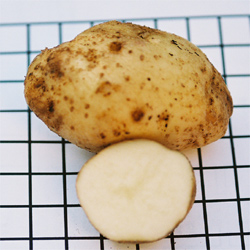 |
Chipeta
Large, round-oval white tubers, late maturing and produces a high yield of tubers with good quality. The skin is commonly covered with small, russeted areas. Eyes are moderately deep with apical eyes indented most. Eyes are moderate in number and concentrated on the apical end. Dormancy is medium. Developed to make potato chips by USDA a cross of WNC612-13 x Wischip, released in 1993. Develops true seed. GRIN: AV 56 Source: ME BO W07 Local grower: |
|||||||||||||||||||||
| An other variety devoloped for commercial processing that may have some great use in the home kitchen. Try American Fryes. | ||||||||||||||||||||||
| Christmas Island Rose
Medium - large oblond tubers - a variety from the collection of Bill Higgins, Christmas Island, Nova Scotia - a seedling of Green Mountain TPS in 2008. Reported to yield good crops. Source: HI B11 Local grower: Curzio What's the best use in the kitchen for this starchy potato? |
||||||||||||||||||||||
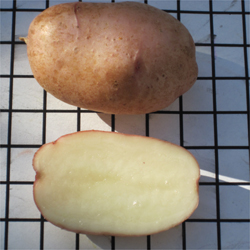 |
||||||||||||||||||||||
| Ciklamen
Medium-large oval to oblong tubers with cream white flesh and bright red skin. This variety is a PVP and must be ordered from a licensed grower, such as Grand Teton. Source: NC RY A 14 Local grower: Curzio Alt Source: CV Grand Teton Grown in 2014 in a 14" Poppy Orange bag without any irrigation this variety now holds the record to this bag size. 5 starting tubers produced 113 oz, 52 tubers, of which 24 over 2oz and 23 under 2 oz., with just 5 micro. The highest total weight of large spuds ever produced in a bag for me! |
||||||||||||||||||||||
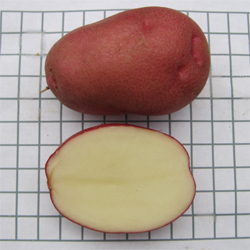 |
||||||||||||||||||||||
| What's the best use in the kitchen for this starchy potato? We have tasted this potato and found it flaky and dry, tending to mealy but with good flavor. It features a slightly bitter, thin skin which transfers a little pink to the flesh after boiling. But we feel this would make wonderful roasted wedgies. | ||||||||||||||||||||||
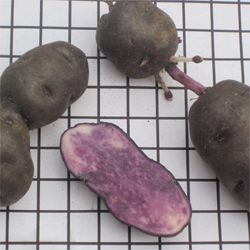 |
Congo
An other name for the variety known as All Blue [see Ake Truedsson for a long list of synonym names]. This variety seems to be keeping green vines longer than any other similar; in 2013 we noticed green vines for 50 days longer than for Blue of Sweden. Set tubers high and serial, perhaps a good choice for growing in containers. Source: LA D 12 Local grower: Curzio |
|||||||||||||||||||||
| Grown in 2013 in an 14" black bag, 3 tubers produced 49.5 oz, 97 tubers, all less than 2 oz, 69 mini and 28 micro - the highest yield of all fingerling shaped blue fleshed varieties.
What's the best use in the kitchen for this starchy potato? We have tasted this potato and found it flaky but not too dry, a hint of chestnut flavor - but not much flavor boiled, perhaps it tastes better fried? |
||||||||||||||||||||||
| Costanera
Small-medium oval tuber with white skin and flesh. Grown commercially in Latin America for chip production. Tolerant to higher soil temperature - perhaps a good choice for growing in containers. Features TALL VINES and sets tuber high. Source: US Genebank 12 Local grower: Curzio Grown in 2013 in an 18" tall bag, 3 tubers produced 52 oz, 29 tubers, of which 10 in the 3-6 oz range, 12 mini and 7 micro. Flagged to be tested in 2014 with 4 mini as starting seed to check if the yield can be further increased. |
||||||||||||||||||||||
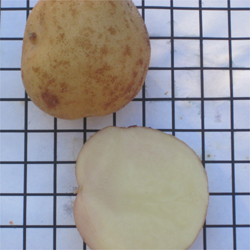 |
||||||||||||||||||||||
| What's the best use in the kitchen for this waxy potato? We have tasted this potato and found it firm, with a buttery taste, just a hint of bitter aftertaste. It features a thin skin. | ||||||||||||||||||||||
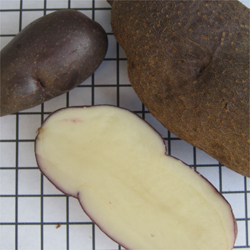 |
Cow Horn - aka La Crotte d'Ours
Late-season. Fingerling tubers with pointed tips, dark-purple skin and dry, mealy, white flesh. Good storage. Excellent resistant to common scab and late blight. Cowhorn is also known under the synonyms Purple Cowhorn and Seneca Cowhorn [but allegedly not the same as Seneca Horn]. Though listed as a fingerling in most databases, its name comes from its general appearance. Specific gravity is 1.069. Maturity is mid-to-late and it is low yielding. It is a heritage variety with uncertain origins. It has been grown in New York state since before 1853. |
|||||||||||||||||||||
| There is some speculation that it might have been developed in Vermont. There is further speculation that it might be identical to La Crotte d'Ours (Bear Poop), a Canadian heritage variety, thought to have roots to Scotland. Reported to have high levels of Glycoalkaloids (TGA). | ||||||||||||||||||||||
| Notice how the chain tuber set on the stolon produces smaller tubers that may not fully develop if the season is cut short.
I have grown many strains of Cowhorn over the years, but this last 2014 strain obtained from SSE Heritage Farm has performed the best ever. On the vines I've even got two seed berries. Also, I've noticed the skin is more netted. |
||||||||||||||||||||||
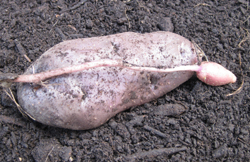 |
||||||||||||||||||||||
| Source: SSE HF14 MI HA K07, MA C06 Local grower: Curzio
Grown in 2014 in a 14" Poppy Orange bag, 4 starting tubers produced a whopping 101 oz for a total of 31 tubers, of which 19 above 2oz, 8 mini and only 5 micro. I'm planning to keep growing all the strains for a few years and keep comparing Cowhorn, Crotte and Seneca Horn as part of my Main Batch. Despite the mealy flesh described above, we found the texture firm as in any waxy variety and cooked a few tubers in a dish I prepared with Austrian Crescent tubers. Left both tubers unpeeled. The Cowhorn keeps a light purple skin color - it was fun to compare the flavors of the yellow-fleshed Austrian Crescent to the white-fleshed Cowhorn.
|
||||||||||||||||||||||
| Purple Fleshed Cowhorn
Thank you Maryel for sending this picture to show that Purple Fleshed Cowhorn (aka La Crotte d'Ours) exist ... at least in your garden! The skin color looks darker in this strain - but we still question if any strain will keep the purple color once grown in my garden. It is possible that the soil pH may change the flesh color. (see Candy Cane for analogy). Maryel tells me her soil has a clay base, while mine has a sandy base. Il looks quite positive I'll have this strain to grow in 2011 ... |
||||||||||||||||||||||
| Also, Maryel tells me that she has found Cowhorn (she grows it with the alt. name Crotte d'Ours) both with and without purple flesh. It will be interesting to keep the two strains separated in the gardens. For this purpose we are "green sprouting" the tubers 2-3 weeks before planting. Tubers will be cut "lengthwise" as shown on the picture above - with the cut face exposed to air to dry out for 3 days, then turned to expose the top to moderate light. Moderate light will promote the growth of short sprouts and produce stronger vines. Cutting the tubers is usually not necessary - we must do it to ensure we keep white flesh and purple flesh tubers separated in the garden. We are testing if this particular feature is stable longterm in different gardens and look forward to your feedback. | ||||||||||||||||||||||
| Crotte d'Ours
These are 12 micro tubers harvested in 2011 from vines grown with the colored flesh tubers Maryel's provided. :O( None of the tubers grown in my garden had colored stripes in the flesh! In 2011 I've grown 12 tuber pieces in a 3 x 3 box and this is the yield detail: 14 standard tubers, 25 mini and 12 micro [see pix] for a total weight of 35 oz. My attempt is to find which variety could yield 99 pounds of tubers grown in a 3 x 3 potato box. Clearly this IS NOT A GOOD VARIETY for this purpose. But I'm not giving up on finding a way of growing purple fleshed Cowhorn - I'm keeping this strain of the variety separated .. and will list it as Crotte d'Ours. |
||||||||||||||||||||||
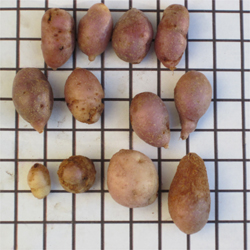 |
||||||||||||||||||||||
| Now (Oct 2011) that we know that the purple flesh feature is NOT a given for this strain .. but more likely a condition which is determined by the quality of the soil - for the 2012 season - we are planning to grow Crotte d'Ours in several red colored SmartBag WITH DIFFERENT SOIL / COMPOST compositions to compare. Perhaps the addition of different minerals in the soil may contribute to flesh color changes.
Source: BO M11 Local Grower: Curzio |
||||||||||||||||||||||
| Crackled German
Large, oval to oblong growing, yellow "crackled" skin and dark yellow flesh. Interesting new variety - somehow similar to German Butterball but with different skin and grows larger tubers. Developed by Verlin Rocky as a cross of Agria Gold x Butterball, released in 2008. Grown in a black SmartBag in 2011 (notice the strange shapes, plus has tendency to resprout in the bag while the vines are not done yet). 4 seed pieces yielded 45 oz. with several standard size tubers. As the soil in black bags is much warmer than for traditional field plantings, the number of standard sized tubers (but few micro) may well be a sign of great Heat Tolerance. |
||||||||||||||||||||||
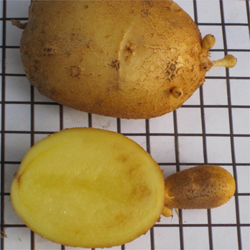 |
||||||||||||||||||||||
| Source: VT SM R10 Local grower: Curzio
What's the best use in the kitchen for this waxy potato? |
||||||||||||||||||||||
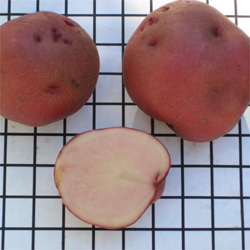 |
||||||||||||||||||||||
| Cranberry Red, aka Huckleberry?
Medium-large, oblong tubers, bright red skin with pink flesh. Hard to tell if Cranberry Red and Huckleberry are different varieties. For now I keep them both. Best variety for storage. Sets true seed pods Source: AK SC N07 Alt Source: CV Wo6 Local grower: Curzio Cranberry Red was my earliest variety in 2008 - the 4" long tuber in this picture was planted in early May and harvested in early July. |
||||||||||||||||||||||
| Grown in 2013 in a 14" Poppy Orange bag, 3 tubers produced 25.5 oz, 22 tubers, of which 2 standard, 17 mini and 3 micro. We took pictures of both Cranberry Red and Huckleberry on Sept 22, 2013 to compare the tubers. Huckleberry has clearly more red in the flesh.
What's the best use in the kitchen for this starchy variety? We tasted this potato as part of a special event with 2 Chefs who compared 11 different varieties with red flesh. The Chefs were not impressed by the taste of neither Cranberry Red, nor Huckleberry. Both varieties are rated as flaky and dry. |
||||||||||||||||||||||
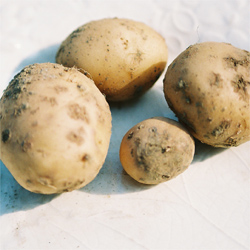 |
Croatan
Medium-large, round, blocky tubers, white flesh. Introduced in NC in 1976. Rare variety. Source: ME BO W07 Local grower: EI T What's the best use in the kitchen? |
|||||||||||||||||||||
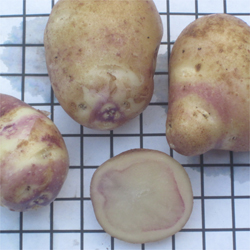 |
Cruza 148
Small-medium round, flat tubers, with purple blotched skin and white flesh, donated from Peru. Rare variety in USA but grown commercially in Mexico. This may be a day neutral variety which requires a long growing season. Oct 15 the vine was still flowering. It grows TALL VINES and set tubers high and serial. May be a good choice for growing in containers. GRIN: PI619136 Source: US Genebank13 Local grower: Curzio |
|||||||||||||||||||||
| Grown in 2013 in a 14" Poppy Orange bag, 3 tubers produced 51 oz, 95 tubers, 5 above 2 oz, 64 mini and 26 micro.
What's the best use in the kitchen for this waxy potato? We tasted it and found it quite flavorful with good nutty aftertaste. The skin is medium thin. |
||||||||||||||||||||||
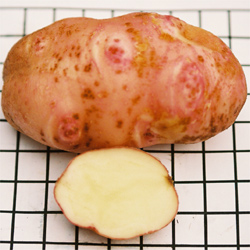 |
||||||||||||||||||||||
| Cups (aka Minions)
Medium - small, round to oblong tubers, white flesh, silvery-pink skin, originally from William Woys Weaver, of Devon, PA and author of "Heirloom Vegetable Gardening." Source: PA GI D07 Local grower: Curzio |
||||||||||||||||||||||
| GREAT GARDEN POTATO! I particularly like the crop of this cultivar - most tubers are in the 2" across size, few grow to 3" - out of my standard 3 ft. row I harvested half a 5 gallon pail of tubers. The tuber in the picture was harvested the first week of July but the vines were done in October, when I found lots of small tubers and very few larger than 2". The perfect small potato.
Seems to be a starchy potato with thin skin - try to pan roast with skin. |
||||||||||||||||||||||
| Cuzco Market
Medium-large oval to oblong tubers with pink skin and light yellow flesh. Named for it's origin, a farmers' market in Cuzco, Peru. It grew berries in 2014 and appears to be a tetraploid variety. Source: WA HO C 14 Local grower: Curzio Note to self: remember to catalog the variety temporary named Cuzco Market II which is clearly not the same. Perhaps a diploid to be grown in Exotic batch. |
||||||||||||||||||||||
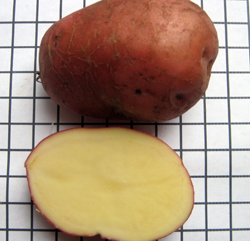 |
||||||||||||||||||||||
| Daisy Gold
Medium-large oval to oblong tubers, with yellow skin and flesh. The Maine Potato Lady wonders if this is a sport of German Butterball. It grows extremely TALL VINES and it produces seed berries. Source: CV Ma23 Local grower: Curzio Grown in an 18" tall bag in 2013, 3 seed pieces produced 31 oz, 24 tubers, 2 standard, 18 mini and 4 micro. Despite the very tall vines, this variety does NOT set tubers high. Flagged for 2014 in a 14" bag to test seed crowding with 5 seed pieces. |
||||||||||||||||||||||
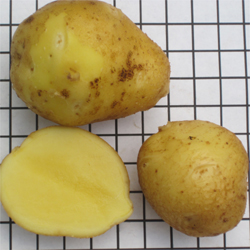 |
||||||||||||||||||||||
| What's the best use in the kitchen for this waxy tuber? | ||||||||||||||||||||||
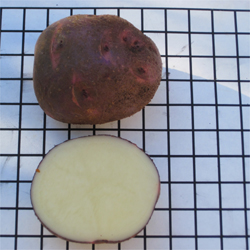 |
Daku's Round Purple
Medium-large round tubers, purple skin with bright pink blotching and white flesh. Reported to grow well also in the Southern half of the USA. Source: ME BO W08 Local grower: What's the best use in the kitchen? Stunning beatiful skin but we have not been able to produce enough to taste it yet. |
|||||||||||||||||||||
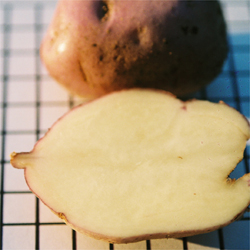 |
Danninger Blaue
Medium-large oval-round tubers, light violette skin and creamy white flesh. Heritage variety grown in Austria. Very Tall Vines Source: ME BO W08 Local grower: Best use in the kitchen? It's a starchy potato, good for mashed potato. |
|||||||||||||||||||||
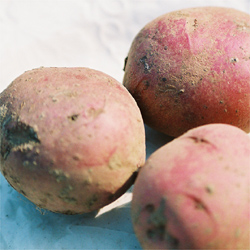 |
Dark Red Norland
A clone of Norland (which is a cross of ND 626 x Redkote) selected for the dark red color. Tubers are oblong, smooth with dark-red skin and moist, firm, white flesh. Fair storage. Source: ME BO W07 Alt Source: CV Fe5 Local grower: Seems to be a waxing potato with thin skin - try to pan roast with skin. |
|||||||||||||||||||||
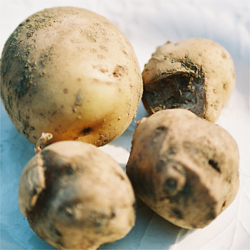 |
Denali
Oval to oblong, uniform shape, smooth and tough buff coloured skin; shallow eyes, evenly distributed, short eyebrows, white flesh. High yielding variety of attractive appearance, tolerant to heat and frost and moderately resistant to disease. Interesting feature: not affected by tuber greening because tuber set deeper than many varieties. Released in 1968 GRIN: AV 9 Source: ME BO W07 Local grower: EI T |
|||||||||||||||||||||
| Seems to be a starchy potato developed for chipping - how would you use it? | ||||||||||||||||||||||
| Desiree
Medium - large round to oval tubers with light red skin and pale yellow flesh. A Dutch variety bred as a cross of Urgenta x Depesche by ZPC, Leeuwarden - released in 1952. Compare to Nagore which seems to produce better in growing bags. Source: CV Fe5 Alt source: CV Ma23 Local grower: Curzio What's the best use in the kitchen for this multi-purpose to starchy potato? |
||||||||||||||||||||||
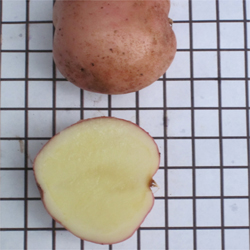 |
||||||||||||||||||||||
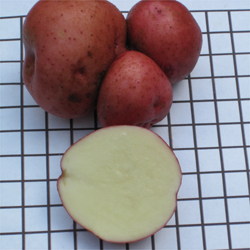 |
||||||||||||||||||||||
| De Sota
Medium - large round, blocky tubers with red skin and white flesh. A cross of Triumph x Katahdin released by Louisiana State U. in 1948 - Will reports that it yields a large crop. Notice how it may grow in bunches, which may be a reason why it is NOT grown commercially - Also we noticed it sets serial on the stolons. Sets true seed pods. Grown in 2013 in a 14" Poppy Orange bag, 2 starting tubers yielded 30 oz, 8 standard tubers, one coming in at 4.5 oz, 7 mini and 2 micro. In 2014 it shall be tested in a hoophouse for extra early crops comparing 3 vs 5 mini tubers as starter seed. |
||||||||||||||||||||||
| Source: VT BI J08 Local grower: Curzio
Great for American Fries and Rösti. We tasted this potato and found it starchy, with thin skin. It should make wonderful mash potato. |
||||||||||||||||||||||
| Dheera
Medium - large round tubers with yellow skin and white flesh. A cross of MAINE-53 x 377888.8 released in 1993 in Bangladesh. Impressive vine strength without any irrigation in extreme drought conditions of 2012. The vines were still green in late October, and the plant developed abundant flowers and seed berries. We tasted this potato and found it starchy, creamy and a little bitter. The skin is thin. TPS available. |
||||||||||||||||||||||
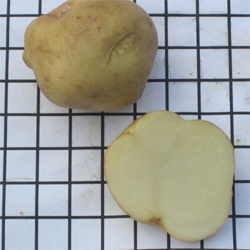 |
||||||||||||||||||||||
| Source: US Genebank 12
Local grower: Curzio What's the best use in the kitchen for this multi-purpose to starchy potato? |
||||||||||||||||||||||
| Dobro
Medium - large oval to oblong tubers with yellow skin and pale yellow flesh. A cross of 70074 17 x 69423 83 released in 1987 in Poland. It produces seed berries. Source: US Genebank 12 Local grower: Curzio Grown in 2013 in a 14" Poppy Orange bag - I only had 2 seed pieces [most 2013 bags started with 3 seed pieces] but those produced 52.5 oz, for a total of 33 tubers, of which 10 standard, 17 mini and only 6 micro; noteworthy that the largest tuber in the picture is 4oz and this variety has so far produced the largest number of standard [over 2 oz weight] tubers when grown in bags. More seed piece crowding may increase the yield? It will be tested in 2014 with 3 vs 5 comparison. |
||||||||||||||||||||||
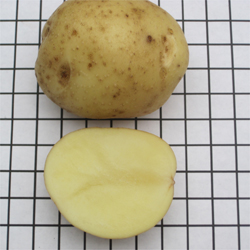 |
||||||||||||||||||||||
| What's the best use in the kitchen for this multi-purpose potato? We tasted this potato and are rating the taste bland with a slightly bitter after-taste. Yet we feel this is a good potato to grow for its good production and earlyness. It features a very thin skin that peels off easily after cooking. Probably good for mash potato. | ||||||||||||||||||||||
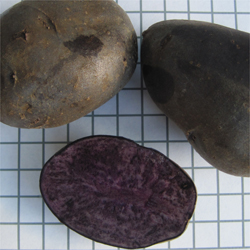 |
Doug's Wild Yard Purple
Medium-large oblong tubers with dark purple skin and flesh. Reported to be growing wild in Doug Strong's Yard, which means it over winters in WA State.. Source: WA HO C 14 Local grower: Curzio Grown in 2014 in an 14" black bag as part of my Exotic batch as I was fooled by the name. It's not an exotic variety. 3 seed pieces produced 31 oz, 14 tubers, of which 6 above 2 oz and 8 mini, ZERO micro. |
|||||||||||||||||||||
| We tasted this potato and found it starchy, dry. It features a medium thick skin with a nutty aftertaste. It is remarkable how well the flesh keeps the dark purple color even after boiling it for 20 minutes. Normally potato tubers keep a better flesh color when fried and lose color intensity if boiled. | ||||||||||||||||||||||
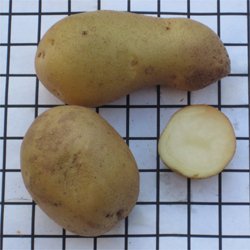 |
||||||||||||||||||||||
| Dr McIntosh
Small - medium round to oblong tubers with yellow skin and cream flesh. A cross of Herald x S rybinii released in 1944 by breeder Josef Krafft in Edinburgh, Scotland. It produces seed berries. Source: LA D 12 Local grower: Curzio Grown in 2013 in an 18" tall bag, 3 seed pieces produced 30 oz, 43 tubers, most of them mini - the vine sets tubers high, and this variety is flagged to be tested in 2014 with 4 seed pieces. |
||||||||||||||||||||||
| What's the best use in the kitchen for this starchy potato? We tasted this potato and found it flaky, not too dry, with good flavor. The skin is medium-thick which points to a good baker. | ||||||||||||||||||||||
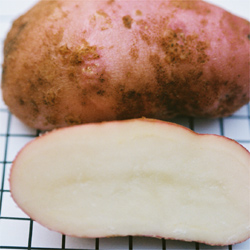 |
Duckworth
Medium-small, oval to oblong tubers, white flesh and pale red skin, has tendency to grow in fancy shapes, thus name Duck-worth. Very rare variety. Source: MI B07 Local grower: CA C Seems to be a waxing potato with thin skin - try to pan roast with skin. |
|||||||||||||||||||||
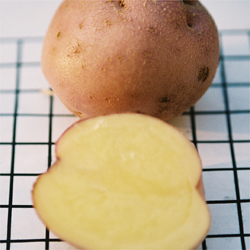 |
||||||||||||||||||||||
| Dutch Blue
Medium-large round-blocky tubers, light purple skin and pale yellow flesh. Name suggests origin from Holland, imported from Canada. In 2009 the best producer of small tubers - great potential for the 99 pounds yield. Tall Vines Sets true seed pods. Source: ME BO W08 Local grower: What's the best use in the kitchen for this waxy - multipurpose variety? |
||||||||||||||||||||||
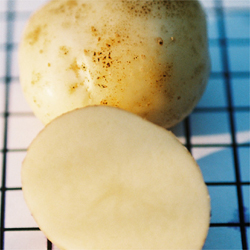 |
||||||||||||||||||||||
| Earlaine
Medium-small round tubers, light yellow skin and white flesh. Released in 1930 as a cross of Irish Cobbler and unknown parent. Sets true seed pods. Source: ME BO W08 Local grower: Best use in the kitchen for this waxy potato? |
||||||||||||||||||||||
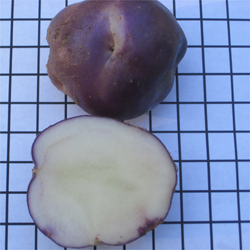 |
Early Blue
Medium-small round tubers, light purple skin and creamy white flesh. Collected in 1939 in Wisconsin and maintained by US Genebank. GRIN: AV 49 Source: US Genebank13 Local grower: Curzio Grown in 2013 in a 14" Poppy Orange growing bag - early harvest: 41 oz - 44 tubers, 2 standard - 28 mini and 14 micro. Planning to test in 2014 to start bags in a hoophouse to obtain earlier vine emergence, plus testing 4 vs 6 mini seed tubers to evaluate benefit of seed crowding in the growing bags. |
|||||||||||||||||||||
| We tasted this potato and found it starchy and flaky, great breakfast potato. It features a very thin skin which turns pale lavander after cooking - the color of the skin transfers to the flesh. What is the best use in the kitchen for this starchy potato - how would you highlight the pale lavander color of the flesh (peeled after boiling)? | ||||||||||||||||||||||
| Early Ohio
Slightly flattened round white tubers. Good storage. Seedling of Early Rose, released in Vermont in 1871. Sets true seed pods. Perhaps one of the earliest "baking" potato. Most starchy potato varieties mature late. Sets tubers high and serial on stolons. GRIN: AV11 Source: MEBOW07 Local grower: Curzio Grown in 2013 in a 14" Poppy Orange growing bag - early harvest: 26 oz - 27 tubers, 3 standard - 17 mini and 7 micro. Planning to test in 2014 to start bags in a hoophouse to obtain earlier vine emergence. plus testing for best seed crowding, starting with 3 vs 5 mini tubers. |
||||||||||||||||||||||
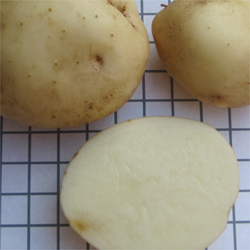 |
||||||||||||||||||||||
| What's the best use in the kitchen for this starchy potato variety? We tasted it and found it dry and flaky and sweet. The skin invisibly thin and features a bitter aftertaste, but a sweet and nutty foretaste. Great roasted. | ||||||||||||||||||||||
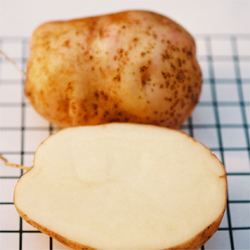 |
||||||||||||||||||||||
| Early Rose
Large size tuber, with smooth but blotchy yellow, pink skin and white flesh. Originated by Albert Breese of Vermont in 1861 as a seedling of Garnet Chili. Tall Vines GRIN: AV 12 Source: AgriCanada 09 Alt Source: CV Ron Local grower: What's the best use in the kitchen for this starchy potato variety? |
||||||||||||||||||||||
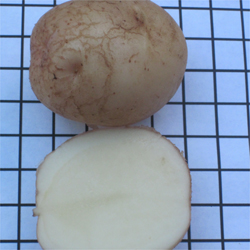 |
Early Rouge
White tuber with red blush in the skin [rouge is red in French]. W3 reports: - Going through some farm accounts/diaries from Berks County PA (1880s-1890s), this potato is mentioned under the name Early Red. Heirloom variety perhaps going back to 1840. Source: LA D 12 Local grower: Curzio |
|||||||||||||||||||||
| What's the best use in the kitchen for this potato starchy variety? | ||||||||||||||||||||||
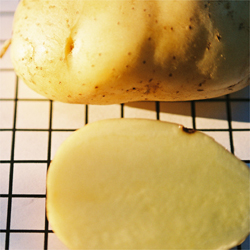 |
Eersteling, Duke of York
Medium-large oblong tubers, light yellow skin and yellow flesh. The name suggests a German origin for an early maturing cultivar, while the synonym name could be Scottish. A cross of Early Primrose x King Kidney. Great potential for the 99 pounds yield. Tall Vines GRIN: PI 407419 Source: ME BO W08 Local grower: Best use in the kitchen? starchy |
|||||||||||||||||||||
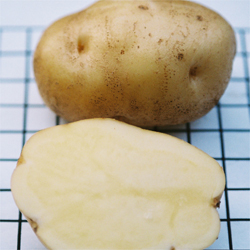 |
Eigenheimer
Medium-small oblong tubers, light yellow skin and yellow flesh. The name suggests a German origin but the cross originates in Holland, Blauwe Reuzen x Fransen, released in 1893. Tall Vines GRIN: PI 423661 Source: ME BO W08 Local grower: Best use in the kitchen? seems to be a waxy variety - multi-purpose. |
|||||||||||||||||||||
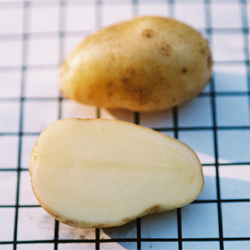 |
Eila Korvu's Thunder Bay Finnish
Medium-small oblong tubers, light yellow skin and yellow flesh. Canada's Seed of Diversity keeps the original seed saver's name with the cultivar. Source: ME BO W08 Local grower: Curzio Grown in 2013 in an 18" tall bag because I noticed the vines set tubers high .. but it turns out the vines don't bulk high. Planning to grow in a blue 14" bag in 2014 starting in a hoophouse to check if we can increase yields with more day light hours. |
|||||||||||||||||||||
| Best use in the kitchen: Skandinavian Potato Salad. See Norwegian Potato Salad
We tasted this potato and found it creamy, earthy full tasty, with medium skin. Not a very good producer, but certainly a keeper for the cooking qualities! |
||||||||||||||||||||||
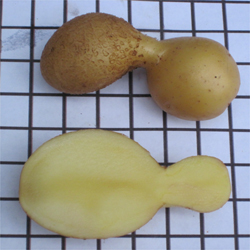 |
||||||||||||||||||||||
| Elba
Medium sized round to oblong tubers, buff color, smooth skin and pale yellow flesh. One source released in 1985 by Cornell University, EuroPotato gives Polish pedigree, released in 1987 as a cross of Certa x Istrinsky. Very late, great staple cultivar - BUT grows in strange shapes - perhaps a reason it is not grown commercially. Tall Vines Source: WA MC C08 Alt Source: CV Fe5 CV Ma23 CV Wo6 |
||||||||||||||||||||||
| Local grower: Curzio
Best use in the kitchen? seems a waxy tuber for multi-purpose use. |
||||||||||||||||||||||
| Elmer's Blue
A blue potato from the collection of Elmer Hansen, British Columbia. Fingerling type tuber with very dark blue skin and flesh. It sets tubers very high on VERY TALL vines. Has tendency to grow long stolons, setting serial tubers. A very good selection for growing in containers. It has an over 120 days vine growth. May grow larger crops if started earlier in a hoophouse. Source: AgriCanada 09 Local grower: Curzio |
||||||||||||||||||||||
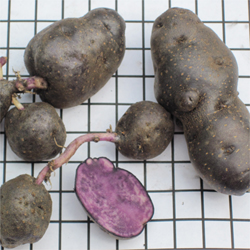 |
||||||||||||||||||||||
| Grown in 2013 in an 18" tall bag, 3 tubers produced 39.5 oz, 120 tubers, of which 4 above 2 oz [high weight for this variety], 74 mini and 42 micro. Flagged to be tested in 2014 starting it earlier to gain 30 days of growing daylight length before June 21st.
What is the best use in the kitchen for this starchy variety? We tasted this potato and found it flaky but not too dry - possibly one of the best blue fleshed varieties we have tasted so far. The skin is thick and both the skin and the flesh keep a very dark blue hue after cooking. |
||||||||||||||||||||||
| Enfula TPS 13
Large blocky, irregular oblong tubers, yellow/red skin and yellow flesh. Very long season variety grown for the first year in 2014 from tubers received from SSE Member Ann in NC. Ann grew this variety for the first time in 2013 starting with botanical seed received from Tom Wagner, who claims it is open pollinated seed which has selfed or crossed with other varieties. The original Enfula is a CIP variety developed perhaps in Peru and has this parentage: PUCA TORALAPA x POTA CONGO 1994 CIP 380606.6 - CIP is the International Potato Center in Lima, Peru. |
||||||||||||||||||||||
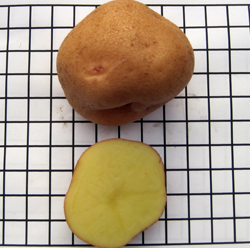 |
||||||||||||||||||||||
| Source: NC RY A 14 Local grower: Curzio
Bottom line here, progeny of this botanical seed will likely be categorized as an Exotic, as the female parent Puca Toralapa is likely an exotic potato. That would explain the very long growing season and resistance to frost. It is interesting to further observe how varieties which resist light frost likely also tolerate high temperatures. I'm planning on growing this potato in my Exotic Batch (early planting) and possibly further extend the growing season (over 180 days in 2014). What's the best use in the kitchen for this starchy potato? We tasted this potato and found it flaky but moist, with good buttery flavor. The skin is medium thin and is removed easily after boiling. |
||||||||||||||||||||||
| Epicure
Large, irregular oblong tubers, red skin and white flesh. Very early variety developed by British breeder James Clark in 1897 as a cross of Magnum Bonum x Early Regent. Epicure is capable of tuber production at lower temps. Source: ME BO W10 Local grower: Curzio Grown in a 14" Poppy Orange bag in 2013 - ONE seed piece produced 23 oz, 5 tubers all large, including one at 7.75 oz, which proves that planting one seed piece produces larger tubers, while crowding more tubers in a growing bag will produce smaller tubers, BUT potentially higher yields. |
||||||||||||||||||||||
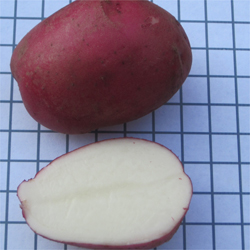 |
||||||||||||||||||||||
| In 2014 3 tubers yielded 33 oz, 19 tubers, almost all in the 2 oz range. A keeper.
What's the best use in the kitchen for this starchy potato? We tasted this potato and found it dry and fluffy. The skin is medium-thin and sweet. This variety should make great mash potato. |
||||||||||||||||||||||
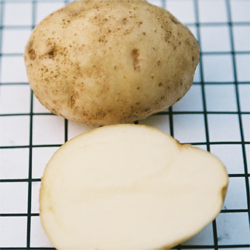 |
Erie
Medium-small round tubers, light yellow skin and white flesh. Released by USDA Ohio in 1945. Source: ME BO W08 Local grower: What's the best use in the kitchen for this waxy variety? |
|||||||||||||||||||||
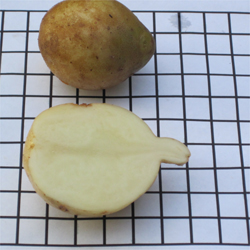 |
Espalier
Medium-small kidney shaped tubers, light yellow skin and pale yellow flesh. No historical data available - perhaps French Canadian. Source: ME BO W08 Local grower: What's the best use in the kitchen for this starchy tuber? |
|||||||||||||||||||||
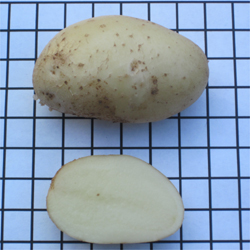 |
||||||||||||||||||||||
| Etoile du Leon
French for Star of Leo - a French mutant of Royal Kedney, listed in 1900. Euro Potato reports the white flesh to be rather firm with low starch matter, perhaps a good multi-purpose variety. Grown in a Poppy Orange bag in 2013: 25.5oz, 33 tubers - 1 standard, 31 mini and 1 micro with THREE starting seed mini tubers. I'm impressed by the consistent size of the mini tubers and almost no micro. In 2014 I'm planning to test it for an extra early crop by starting the bags in a hoophouse and testing seed crowding optimization comparing a bag with 3 seed mini vs. 5 |
||||||||||||||||||||||
| Source: LA D 12 Local grower: Curzio
What's the best use in the kitchen for this waxy tuber? We tasted this potato and found it waxy, mildly nutty, featuring a thin skin. Probably excellent for potato salads. |
||||||||||||||||||||||
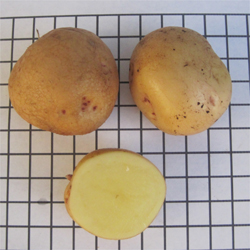 |
Fiesta Gold
Medium-small oval to blocky tuber, with yellow skin and flesh. A creation of Tom Wagner as a seedling of Tollocan Fiesta. Tollocan Fiesta was a cross of Tollocan and Boyd Toro. Boyd Toro was a round red with yellow flesh out of the cross of Designer Boyd and Kern Toro. Members of Kenosha Potato Project on Facebook report this variety to be extremely productive both for yield and berry setting. I've seen a berry in 2014 ... lost to rodents. |
|||||||||||||||||||||
| Source: WA HO C 14 Local grower: Curzio
We tasted this potato and found it flaky, but moist, with good flavor and a very light texture. It features a super thin skin. We think it could be boiled with the skins and mashed without removing the skins to make a wonder wholesome mash. What's the best use in the kitchen for this multi-purpose tuber? |
||||||||||||||||||||||
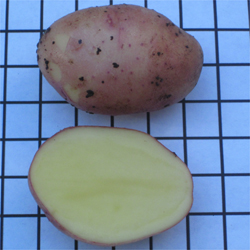 |
Finn Bad
Medium-small oval to oblong tuber, with pink skin and yellow flesh. Tom Wagner posted: This is a complicated cross of Yellow Finn and some other yellows and reds and then crossed to a seedling called Badlands Gold from my Black Hills Gold and Papa Joe hybrid made for me by Joe Pavek of Idaho. Papa Joe is a diploid that I created back nearly twenty years ago using Papa Amarilla crosses and haploid tuberosum [Although the term 'haploid' is used interchangeably across differing ploidy levels, alternative nomenclature exists that is specifically indicative of chromosome number and parental ploidy. |
|||||||||||||||||||||
| Haploids derived from tetraploid potato are called ?dihaploids? (2n = 2x =24), whereas ?monoploids? (2n = 1x = 12), or sometimes ?monohaploids,? are haploids derived from diploid potato and have the basic chromosome number (van Breukelen et al. 1977; Ross 1986). Although the induction of haploid plants is generally referred to as ?haploidization,? the various specialized techniques used across the crop spectrum may employ vastly different synthetic and biological mechanisms to achieve their goal. In potato breeding there are two main pathways by which haploid plant formation can be induced: androgenesis and gynogenesis. Courtesy of Thesis: AFLP MARKER ANALYSIS OF MONOPLOID POTATO, by John M. Varrieur]
The flavor is what makes Finn Bad a "must" to try. Tom mentions it in a post of Aug 2006 as one of his best male pollen producer. Source: ST D 13 Local grower: Curzio Sets tubers high - a good choice for containers. Grown in a 14" Poppy Orange growing bag in 2013. One tuber produced 18.5 oz - 22 tubers total, 1 standard, 14 mini and 7 micro. Late July harvest - planning to test in 2014 starting bags in a hoophouse to obtain an extra early crop. We tasted this potato and found it waxy, creamy with good flavor, it features a thin skin. What's the best use in the kitchen for this waxy tuber? |
||||||||||||||||||||||
| Flourball
Listed by Europotato as a main crop variety released in 1895 by breeder C. Raddatz-Hufenberg in the United Kingdom. A round tuber. The skin color can vary from pink to light purple, the flesh is cream. Source: LA D 12 Local grower: Curzio Grown in 2013 in an 18" tall bag, 2 seed pieces produced 44 oz, 48 tubers, incl 4 standard, 28 mini and 16 micro. Flagged to be tested with 3 seed pieces in 2014 - this variety sets tubers high on the vine and has potential for higher yields in the taller bag size. |
||||||||||||||||||||||
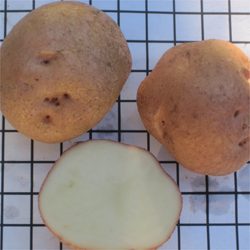 |
||||||||||||||||||||||
| What's the best use in the kitchen for this starchy tuber? We have tasted this potato and found it flaky and dry, with a mild taste. The skin is medium-thin. Possibly a great choice for gnocchi. | ||||||||||||||||||||||
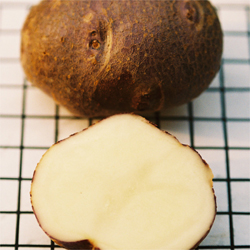 |
Fortyfold, Forty Fold
Medium-large, round to oblong shaped tubers with partly blue skin and cream to yellow flesh. Old British variety, released in 1836. Great potential for the 99 pounds yield. Tall Vines Source: ME BO W09 Local grower: Try to boil and toss in a fresh green salad, like this wonderlful fresh dandelion salad. |
|||||||||||||||||||||
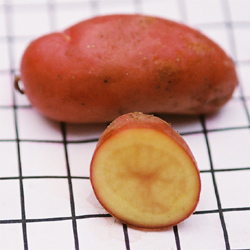 |
||||||||||||||||||||||
| French Fingerling, aka Nosebag (Roseval)
Medium-small, fingerling tubers with yellow flesh and pink skin. Will Bonsall reports that the original seed came from Mark Fulford, Monroe, ME with a curious story: a friend of Mark's went to a French farm to buy a race horse, invited to lunch, he commented on the tasty potatoes, wishing he could take back some seed but for quaranteen restrictions, no more was said, but when the horse arrived home, a single tuber was found at the bottom of the feedbag (aka Nosebag). |
||||||||||||||||||||||
| The now very popular variety is likely to be the same as the French cultivar Roseval, a cross of Vale x Rosa released in 1950. Note: the French variety Rosa (released before 1935 - aka Cornichon Rose, Rognon Rose) is not the same as the U.S. variety Rosa (sport of Early Rose).
Source: commercial grower Local grower: Alt Source: CV Ron - CV Fe5, CV Ma23 and CV Se16 Best use in the kitchen: Roasted or in a French Potato Salad |
||||||||||||||||||||||
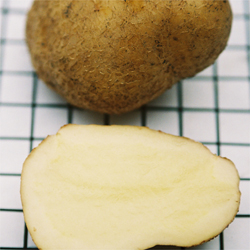 |
Fruheperle (aka Frühperle)
Medium-small round tubers, light yellow skin and yellow flesh. Old German variety (Früh = early in German) - a cross of Erstling x Rote Mäuse released in 1947. GRIN: PI 199285 Source: ME BO W08 PI 199285 Local grower: Best use in the kitchen? waxy |
|||||||||||||||||||||
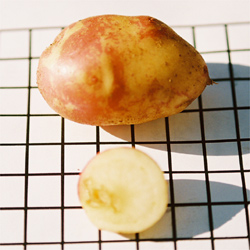 |
Frutilla
Medium-small white tubers, very attractive color, more yellow than red. I'm growing them to compare to Inca Treasure, which is a variety with yellow flesh. GRIN: PI 245808 Source: ME BO W07 Local grower: CA C Seems to be a waxing potato with thin skin - try to pan roast with skin. |
|||||||||||||||||||||
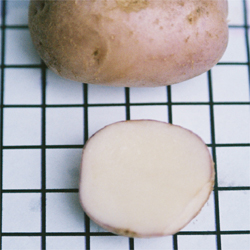 |
Gamla Blå, aka Gammal Blå
Medium-small oblong tubers, light purple skin and cream flesh. Old Skandinavian variety (Gamla = old in Swedish). Facebook friend Mikko Heikkinen reports that this variety is published with a flesh color that looks more pale yellow than cream. Source: ME BO W08 Local grower: Best use in the kitchen? starchy |
|||||||||||||||||||||
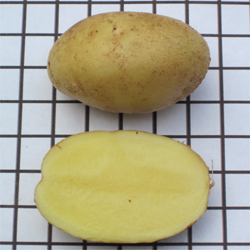 |
Gamerith II
Medium-small, oblong tubers from Annie Gamerith, Austria. Thought to be lost - the member gardener had tubers survive the Wisconsin winter and came back as a volunteer. Source: ME BO W07 Local grower: Curzio What's the best use in the kitchen for this waxy potato with thin skin? - try to pan roast with skin. |
|||||||||||||||||||||
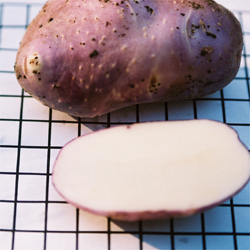 |
Gander Bay Blue
Medium-small, oblong tubers. Attractive purple blue skin and white flesh. No historic data available. Early to emerge. Tall Vines Sets true seed pods. Source: ME BO W07 Local grower: Best use in the kitchen: A starcy tuber can be used for mash potato. |
|||||||||||||||||||||
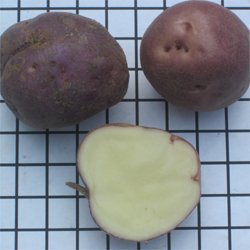 |
Gardenfiller, aka Hibernian
Medium-large, oval to oblong tubers. Dark red to blue skin and pale yellow flesh. Reported to be a true historic Irish variety, perhaps originated in Scotland, pre 1900. Source: LA D 12 Local grower: Curzio Grown in 2013 an 18" tall bag because the vines has tendency to set tubers higher AND serial, but the yield of 21 oz does not justify the extra effort to grow it in a taller bag. The variety is flagged for testing in a 14" bag in 2014 with 4 mini as starting seed. |
|||||||||||||||||||||
| What's the best use in the kitchen for this multi purpose potato? We have taste this potato and found it flaky, but not too dry, with good flavor. The skin is thin and slightly bitter. After cooking the lavender blue skin color is lost. | ||||||||||||||||||||||
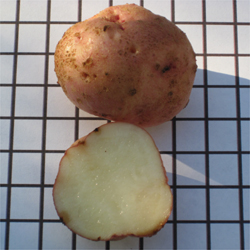 |
||||||||||||||||||||||
| Garnet Chili, Garnet Chile
Medium-large, irregular round to oval tubers, with unattractive flaky pink-red skin turns and white flesh. Very old variety obtained in 1853 by Rev. Chauncey Godrich (a prot. minister in Utica, NY) from TPS produced on a vine of Rough Purple Chili (a landrace imported from Chile in 1851). Garnet Chili is the great grandma of 90% plus of all currently grown varieties, starting as the parent of Early Rose, and providing genes for Green Mountain, Irish Cobbler, Katahdin, Kennebec, Red Pontiac, Russet Burbank, Yukon Gold and many more. |
||||||||||||||||||||||
| A variety with rather lower yield .. perhaps only interesting to keep growing for its historical value, or the taste?
GRIN: AV 15 Source: AgriCanada11 Local grower: Curzio Grown in 2013 in a 14" Poppy Orange bag, 3 tubers produced 27.5 oz, 13 tubers, of which 6 standard, 3 mini and 4 micro. Flagged for 2014 to start with 4 tubers to test if we can get more mini tubers than standard size. What's the best use in the kitchen for this waxy potato? The taste is wonderful: sweet and nutty. The skin is medium thin. |
||||||||||||||||||||||
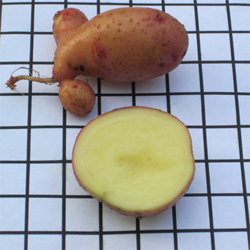 |
||||||||||||||||||||||
| Gasore
Large, oval to oblong growing, golden pink skin and yellow flesh. Developed in Belgium possibly for African countries as extremely resistant if grown without treatments - a cross of Gracilia x Soraya, released in 1996 in Gembloux, Belgium. Source: CA CO W10 Local grower: What's the best use in the kitchen for this multi purpose potato? |
||||||||||||||||||||||
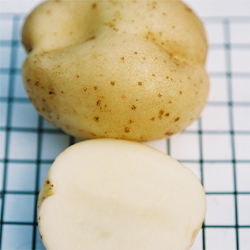 |
||||||||||||||||||||||
| Gemchip
Round to short oblong, smooth with a shallow to moderately deep bud-end. Skin is smooth but may have small scaly patches. An other variety developed for commercial processing for chips. A cross of BR5960-9 x ND5737-3 released in 1989. GRIN: AV 58 Source: ME BO W07 Local grower: What's the best use in the kitchen? |
||||||||||||||||||||||
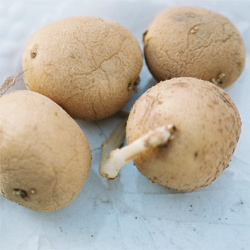 |
Genesee
Medium-small, round tuber with white flesh, late maturing. A cross of M348-45 x Katahdin released in 1993. Develops true seed. Source: ME BO W07 Local grower: What is the best use in the kitchen? |
|||||||||||||||||||||
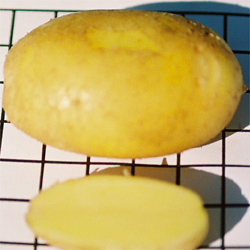 |
German Butterball
First place winner in Rodale's Organic Gardening "Taste Off." A good choice for roasting, frying and mashed potatoes. Russeted skin and buttery yellow (medium-dry) flesh. One of our favorite all-purpose potato. Most tubers are medium - small and the skin is very thin - I use them often to cook in soups, just diced with the skin. Excellent for long-term storage, if left in the ground until the vines turn brown, but I find nice size tubers to "steal" in July. |
|||||||||||||||||||||
| Grown in my biodynamic garden since 2004 - noticed that over the years the tubers have grown in size (2008 found one tuber 5" x 2.5") - perhaps the plants are telling me that they really love my soil. One vine grew true seed pods 2008 and lots of tubers over-wintered to offer volunteer vines the following year.
Source: CV Fe5 Local grower: Rich Alt Source: CV Ron CV Ma23 CV Se16 Best use in the kitchen? waxy potato, great for potato salads |
||||||||||||||||||||||
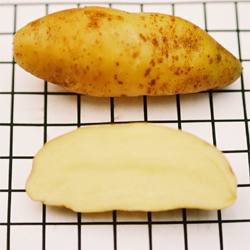 |
German Lady Finger
Medium-small, fingerling shaped tuber with yellow flesh. Will claims that this variety is drought resistant. I was a little disappointed with the yield and thought to give this variety one more chance in 2014. Grown 3 tubers in a 14" Poppy Orange bag and produced 69 tubers, all mini except a dozen micro. Great harvest of small fingerlings. A keeper flagged for 2015 with 4 tubers as starting seed. |
|||||||||||||||||||||
| Source: ME BO W07 Local grower: Curzio
Best use in the kitchen: Pan roasted or in a German Rhine Potato Salad |
||||||||||||||||||||||
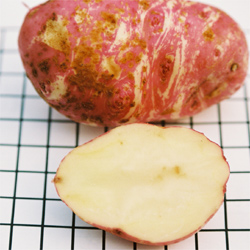 |
||||||||||||||||||||||
| Gescheckte Kolm
Medium oblong tubers, red "speckled" skin with creamy flesh. Originates in Austria. A tuber over-wintered in my garden in 2008. Source: ME BO W07 Local grower: Curzio Should be a good choice for potato salad. |
||||||||||||||||||||||
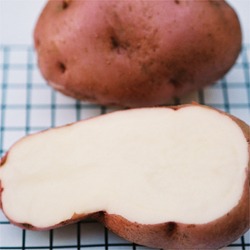 |
Glenmeer, Glenmere
Medium-large round tubers, pink skin - cream flesh color. A cross of NY ABX/6 x Redd 1152 released in NY in 1946. Sets true seed pods. Source: ME BO W07 Local grower: What's the best use in the kitchen? |
|||||||||||||||||||||
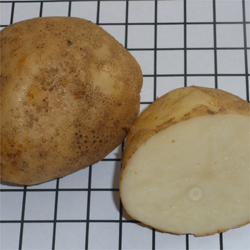 |
Gold Coin
Medium-large oblong, slightly flattened yellow tubers. No historic info available, except it is an American variety. Source: ME BO W07 Local grower: What's the best use in the kitchen? |
|||||||||||||||||||||
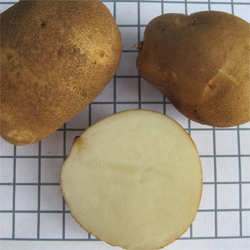 |
Goldrush, Gold Rush
Oblong to long tubers with well-russeted skin and medium-dry, white flesh. Fair storage. A cross of Lemhi Russet x ND450-3 - the last jewel dev. by Bob Johansen, released in ND in 1992. [Bob is the breeder of Norland, Norchip, and Russet Norkotah] Source: ME BO W07 Alt Source: CV Ma23 Local grower: Curzio Grown in 2014 in 3 bags to compare yield with 2 - 4 or 5 starting tubers. Unexpectedly the best result came from the bag with 2 starting tubers: 59 oz, for 26 tubers |
|||||||||||||||||||||
| of which 13 above 2 oz, 10 mini and only 3 micro. BUT none of the tubers grew to the size expected for a baking spud, 6 - 8 oz weight range. Strangely the bag with 4 starting tubers produced only 37 oz, for a total of 10 tubers, of which 6 standard (some in the 5 - 6 oz range), and 4 mini.
We DO NOT recommend to grow this variety in containers. We tasted this potato and found it dry, flaky, and detected a good earthy taste after boiling it for 20 minutes. It features a quite tasty, thick russeted skin. Typically this variety is grown for French Fries. |
||||||||||||||||||||||
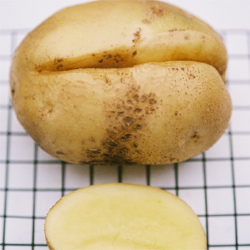 |
Goldsegen
Medium size round, yellow tubers with yellow flesh. Good performance even in poor soil. Good storage. from Austria, released in 1958. Source: ME BO W07 - PSR: KA-598 Local grower: Curzio What's the best use in the kitchen for this starchy variety? |
|||||||||||||||||||||
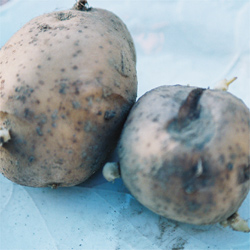 |
Grand Falls
Small-medium size round to oblong, white tubers from Canada. A cross of F48034 x SSRPB 1682c(1) released in 1965. Source: ME BO W07 Local grower: What's the best use in the kitchen? |
|||||||||||||||||||||
| Granola
Medium-large size oval to oblong tubers with brown skin and yellow flesh from Germany. A cross of Grata x Nola released in 1975. Good yield and fantastic storage ... keeps well into spring - a good choice for main crop of large tubers. Grown in a black SmartBag in 2011 - 4 vines yielded 20 oz. of tubers, 10 in med size, 14 mini tubers and just one micro. The lack of micro tubers suggests tuberization at higher temps .. as the soil in black bags is much warmer than for traditional field plantings. Good Heat Tolerance |
||||||||||||||||||||||
 |
||||||||||||||||||||||
| Source: IA FE S08 Local grower: RichS
What's the best use in the kitchen? Great utility potato - waxy - if diced you can expect the flesh to keep the shape in soups. The taste is sweet. |
||||||||||||||||||||||
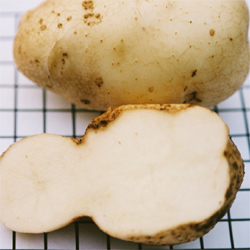 |
Great Northern
Small-medium size round white. No historic data available for this rare variety. Sets true seed pods Source: ME BO W07 Local grower: What's the best use in the kitchen? |
|||||||||||||||||||||
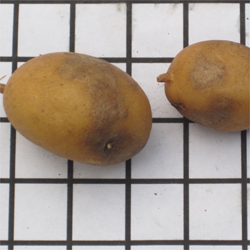 |
Great Scot
Medium-large size round tuber with yellow flesh and white flesh, a cross of Imperator x Champion by British breeder E. Miles, Mickleholm, released in 1909. Source: ME BO W07 Local grower: What's the best use in the kitchen? |
|||||||||||||||||||||
| Green Mountain
Tubers are large, short-oblong to oblong, flattened; ends usually blunt; smooth buff skin, often netted; medium-deep white eyes; white flesh. High yielding variety; stores well; well suited for washing after two months storage; grows well in light soils. First introduced in the State of Vermont in 1878 - it never dawned on me that the State's name is French: Vert (green) Mont (mountain). |
||||||||||||||||||||||
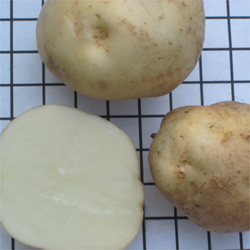 |
||||||||||||||||||||||
| GRIN: AV 16 - Source: VT BI J07 - Local grower: FredB
Alt Source: CV Fe5 CV Ma23 What's the best use in the kitchen for this starchy tuber? We have tasted this potato and found it flaky, with good flavor. It features a medium-thin skin with a mildly nutty flavor. This variety is the favorite for Max Martin, a researcher who has worked for over 24 years at the US Genebank - Potato Research Station in Sturgeon Bay, WI. |
||||||||||||||||||||||
| Guincho Negra
A diploid landrace from Amazonas, Peru. S. Tuberosum, subsp. andigenum with exceptionally high levels of total anthocyanins (16.33 mg g-1 of DW), the main anthocyanin was identified as petanin. We have seen a plant growing over 7 feet tall at the Research Station in Wisconsin - very nice flowers. Source: WASTD13 Local grower: Curzio It is advised to grow this potato in containers as the it can develop very long stolons and become invasive with lots of useless pea size tubers. |
||||||||||||||||||||||
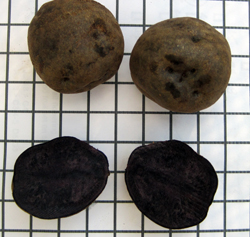 |
||||||||||||||||||||||
| What's the best use in the kitchen for this starchy, small tuber variety? We tasted this potato and found it of good taste, despite the bitter skin. Because of the very long growing season it's difficult to grow a large crop, but definitely a keeper here. Worth one exceptional meal! | ||||||||||||||||||||||
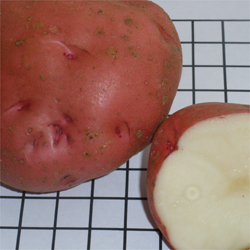 |
Gurney's Everbearing
What Will calls an opportunistic variety that keeps maturing a succession of tubers all season, so you get a wide range of sizes. Great potential for the 99 pound yield. Source: ME BO W07 Local grower: What's the best use in the kitchen? |
|||||||||||||||||||||
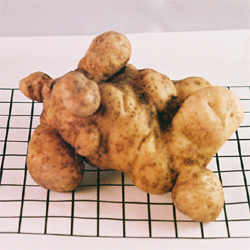 |
Haida
Very knobby tubers, waxy, white flesh. Look extremely similar to Ozette (most tubers are fingerling shaped) - In the Queen Charlotte Islands, the Haidas grew potatoes that were about two or three inches long. The individual tubers vary in shape. Some are oblong. Others are egg shaped. Still others are nearly round. Many are knobby. They have medium brown skin, with a number of eyes. The flesh is waxy, and cream-colored. Reported by PGRR to have high levels of Glycoalkaloids (TGA). Source: AgriCanada 10 Local grower: Curzio |
|||||||||||||||||||||
| I'll compare to Ozette and report - Ozette is my favorite potato! High levels of TGA make the tubers more flavorful. Stores extremely well.
In 2010 the comparison of Haida to Ozette and Indian Tlingit showed Haida growing much longer vines and in a "warmer Summer" with lower yields, Haida produced more than the other two varieties. This link provides a very complete study of early potato history among native people. |
||||||||||||||||||||||
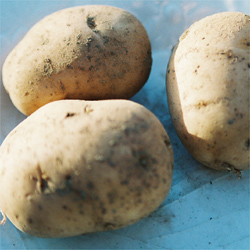 |
Hambone
Medium-large oblong, white tubers. No historic info, but rare. Source: ME BO W07 Local grower: What's the best use in the kitchen? |
|||||||||||||||||||||
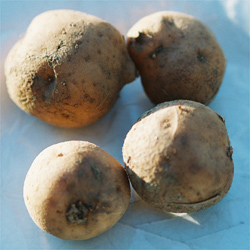 |
||||||||||||||||||||||
| Hampton
Medium-small round white tubers. A cross of NY48 x NY51 released in NY in 1985. Source: ME BO W07 Local grower: What's the best use in the kitchen? |
||||||||||||||||||||||
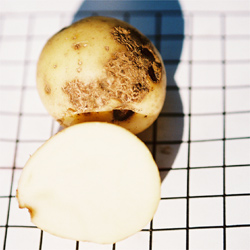 |
Hankkija's Tuomas
Medium-large oblong yellow tubers with light yellow flesh, from Finland, released in 1975. Source: ME BO W07 Local grower: Noticed that the plants grow a small yield of tubers - some scab on the surface, while deeper set tubers have no scab. What's the best use in the kitchen? |
|||||||||||||||||||||
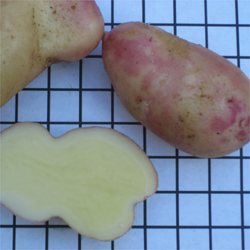 |
Harlequin
Medium-small oval to oblong tubers with pink blotched skin and yellow flesh [notice how the core is a little darker yellow with a ring below the skin], a British cross of Charlotte x Pink Fir Apple, released by James Hutton Institute with PVP rights expiring in 2034. Source: WAHOC Local grower: Curzio Grown in 2013 in a 14" black bag it produced 26 oz, 39 tubers, of which 1 at 2.5 oz, 28 mini and 10 micro. Seems to be an ideal variety for larger yields when grown in containers. |
|||||||||||||||||||||
| What's the best use in the kitchen for this waxy tuber? We tasted this potato and found it creamy with a wonderful buttery flavor. It features a medium skin, slightly bitter. The shape of these tubers is ideal for potato salads, as we recommend to always boil tubers with the skins to prevent moisture absorption. | ||||||||||||||||||||||
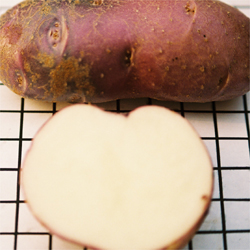 |
Heidzel Blue (aka Bodega Red ?)
Medium-large oblong tubers with red (perhaps as dark as purple) skin and white flesh, a traditional cultivar from Germany. The skin color may fade in storage to look more red than blue, hence the aka name Bogeda Red. I have harvested tubers with darker blue skin. Source: ME BO W07 Local grower: Curzio We tasted this potato and found it sweet, dry and flaky. May be a great choice for baked potato or for soup thickening as it falls apart rather quickly. The skin is thick. |
|||||||||||||||||||||
| Highland Burgundy (aka Red Cardinal)
Medium - small tubers with dark red skin and red blotched flesh. A landrace from the highlands of Scotland with high proportion of pelargonidin, an antioxidant belonging to the anthocyanidins class. Rare variety. Source: AN J11 Local grower: Curzio What's the best use in the kitchen for this starchy variety? |
||||||||||||||||||||||
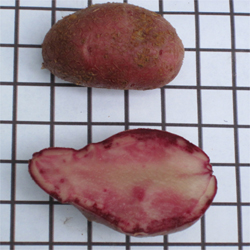 |
||||||||||||||||||||||
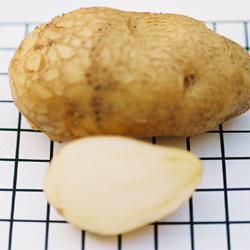 |
Hindenburg
Variable size, blocky, white tubers from Germany. Features high starch. Will tells me that cooked the tubers discolor. Released in 1916 as a cross of Ismene x Jubel. Sets true seed pods GRIN: PI 105479 Source: ME BO W07 Local grower: High starch = great baking? |
|||||||||||||||||||||
| Hokkai # 45
Small - medium, oval to oblong tubers, white skin and flesh. Some Japanese potato collector may shed some light on the history of this variety. Source: US Genebank 12 Local grower: Curzio Grown in 2013 in a 14" Poppy Orange bag, 3 mini produced 40 oz, 25 tubers, of which 7 standard and 18 mini, no micro. Flagged for testing with 4 mini as starting seed in 2014. |
||||||||||||||||||||||
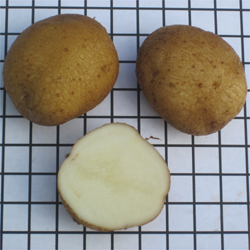 |
||||||||||||||||||||||
| What is the best use in the kitchen for this high starch variety? We tasted this potato and found it flaky and very dry. Possibly the worst potato I've cooked in my breakfast stew. I was considering dropping it from the collection, except it has produced quite well and possibly it could work very well for gnocchi - for this Italian product flour is added to the potato mash to make dough. The dryer the mash, the less flour is required, which makes very light gnocchi. Hokkai may work very well. | ||||||||||||||||||||||
| Hokkaiaka
Medium-small oblong tubers, light pink skin and cream flesh. A cross of 2770ab31 x SH290 variety was released in 1965 in Japan. Source: ME BO W08 Local grower: What's the best use in the kitchen? |
||||||||||||||||||||||
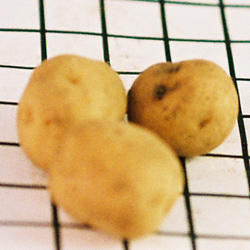 |
||||||||||||||||||||||
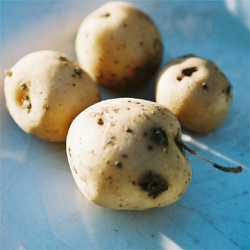 |
Houma
Mistery size round-oval, rare potato, white flesh with good flavor, if parent Katahdin is true. A cross of "Charles" Downing x Katahdin released in 1929. Source: ME BO W07 Local grower: What's the best use in the kitchen? |
|||||||||||||||||||||
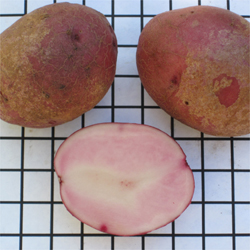 |
||||||||||||||||||||||
| Huckleberry
Medium-large, oval to oblong tubers with red skin and pink flesh. Grown to compare with Cranberry Red. Huckleberry vines grew green for 2 weeks longer. We found tubers set higher on the vines. Source: ME BO W07 Local grower: Curzio |
||||||||||||||||||||||
| Huckleberry grown in 2013 has shown higher tuber set - grown in a 14" Poppy Orange bag it produced 20.5 oz, 19 tubers, including 4 above 2 oz. in an oval shape [not as oblong as Cranberry Red], 11 mini and 4 micro.
What's the best use in the kitchen for this starchy variety? We tasted this potato as part of a special event with 2 Chefs who compared 11 different varieties with red flesh. The Chefs were not impressed by the taste of neither Cranberry Red, nor Huckleberry. Both varieties are rated as flaky and dry. |
||||||||||||||||||||||
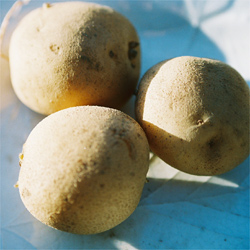 |
Hudson
Medium-large oblong, white tubers. A cross of N1F-1 x 56 N18-4 released in NY in 1972. Source: ME BO W07 Local grower: What's the best use in the kitchen? |
|||||||||||||||||||||
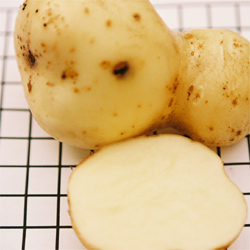 |
Huinkul
Irregular growing white tuber, rare in the USA, but is grown commercially in Argentina, released in 1948 as a cross of 336-144 x Earlaine. Source: ME BO W07 Local grower: What's the best use in the kitchen? |
|||||||||||||||||||||
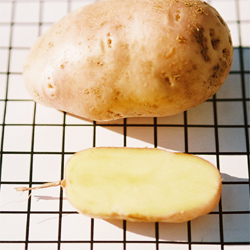 |
Hunky
Small oblong, pink skin, and yellow flesh - no history but rare. Source: ME BO W07 Local grower: What's the best use in the kitchen? |
|||||||||||||||||||||
 |
Hunter
Oval white tuber, released by New Brunswick in 1952 and derived from a wild Mexican species (Solanum demissum) and Katahdin x Irish Cobbler. Sets true seed pods Source: ME BO W07 Local grower: What's the best use in the kitchen? |
|||||||||||||||||||||
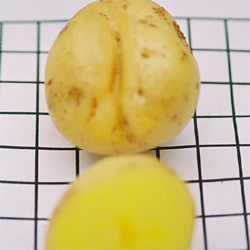 |
Ilona
Grown from commercially available true seed in Belarus. Sondra sent me a few small tubers which grew tall and healthy vines. Harvesting mid-season med-large tubers with yellow flesh. Sets small true seed pods Source: IA FE S07 Local grower: Curzio Seems to be a waxing potato with thin skin - try to boil and slice for potato salad. |
|||||||||||||||||||||
| A word about growing potato from seed - even though this variety was imported to the US as true seed (TPS), it is now cloned via tubers. I found TPS the second year of growth ... but the seed pods are much smaller than on most other cultivars. | ||||||||||||||||||||||
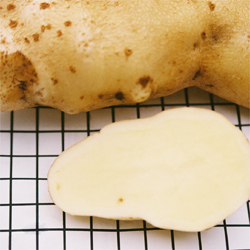 |
Ilse's North German
Medium size, oval tubers with yellow skin and yellow flesh, released in Germany in 1980. Need to test 6" planting to avoid very long tuber growth. I found one tuber (see section of the picture) which was over 8" long and about 3" wide. Sets true seed pods. Source: ME BO W07 Local grower: JanetE Best use in the kitchen: Waxy potato - try to cube for vegetable soups. |
|||||||||||||||||||||
| Waxy potatoes can be cooked for a longer period and keep the shape ... don't fall apart even if boiled for hours. Usually waxy potatoes are smaller in size. Potato salad may also be a good use. See a German Rhine Potato Salad | ||||||||||||||||||||||
| Inka Gold (aka Inca Gold)
Medium-large round to oval tuber with yellow skin blotched with purple and dark yellow flesh. One of the best market sellers for SSE Member OR DR A. Developed at UC Davis by Carlos Quiros released in 1994. Very late, perhaps a day neutral variety. May be a good choice for growing in containers. Renamed Inca Gold by Ronniger - the man who improperly "re-names" potato varieties. See Valisa [scroll down on my online catalog]! Source: OR DR A 11 Local grower: Curzio |
||||||||||||||||||||||
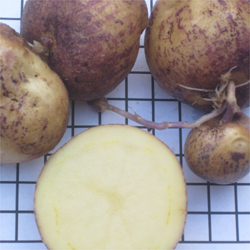 |
||||||||||||||||||||||
| Grown in 2013 in a 14" Poppy Orange bag [IN PART SHADE], 2 seed tubers produced 49 oz, 44 tubers, of which 9 above 2 oz, 24 mini and just 6 micro. It grows TALL VINES, perhaps could increase yields in an 18" tall bag? Notice in this 2013 picture how the tubers set in serial and two 2.5" tubers developed on the same stolon [left], while the second tubers on the right only developed to a mini size.
What's the best use in the kitchen for this multi-purpose, starchy variety with high carotenoid content? We tasted this potato and found it flaky and a little dry, very flavorful with a distinct nutty aftertaste. The skin is medium thin with a nutty aftertaste. |
||||||||||||||||||||||
| Inca Treasure (Highland Landrace cv.)
Perhaps the most expensive potato in the world - I paid $25 for 5 tuberlets. Unique skin color, yellow flesh and exceptional flavor, says Anpetu who sent me the seed. For this price I hope to be able to confirm! This cultivar is very late, and yet, in November I found many under-developped tubers. The tuber growth is very shallow, just around the vine crown. Lost it in 2010 but got replacement seed from WI CO M and put through the baby treatment. The second picture shows what I was able to harvest in 2010 - grown in a bag - the vines were too dry and produced only two tubers. The top tuber seems too dehydrated to overwinter. 2011 may be my last attempt to grow this variety. I eat most of my potato 2008 crop in my morning breakfast soups. Boiled in vegetable broth for about 20 minutes with the skin, the Inca Treasure tuber turned very soft, almost creamy. |
||||||||||||||||||||||
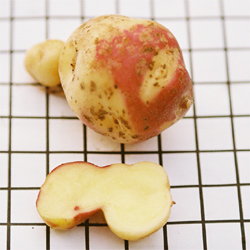 |
||||||||||||||||||||||
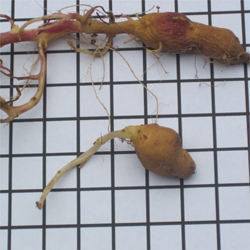 |
||||||||||||||||||||||
| Source: OI A07 Local
Grower: CA C Best use in the kitchen: Very starchy potato - very difficult cultivar for this region - in 2009 I had zero yield. |
||||||||||||||||||||||
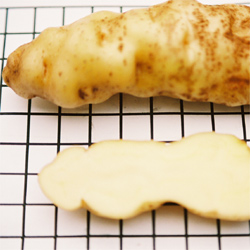 |
Indian Tlingit
Medium-large, knobby, fingerling shaped white flesh tuber, from a Tlingit elder who remembers eating them as a child in 1920s. Tlingit is the name of a native tribe in Alaska. Exceptional vine growth may benefit from pruning. Source: AK SC N07 Local grower: Best use in the kitchen: |
|||||||||||||||||||||
| The shape reminds me of Ozette - perhaps more pine cone shaped - an other variety to compare with Haida and Ozette especially in regards to the taste - vine growth is much stronger than Ozette. Stores extremely well, perhaps the best storing fingerling shaped tuber - see my storage web page.
This link provides a very complete study of early potato history among native people. |
||||||||||||||||||||||
| Institut de Beauvais
Heritage French variety bred at Institut de Beauvais, released in 1884. Light pink skin with blushed red eyes. Source: PSR Local grower: What's the best use in the kitchen for this multi-purpose, waxy variety? |
||||||||||||||||||||||
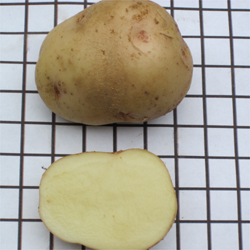 |
||||||||||||||||||||||
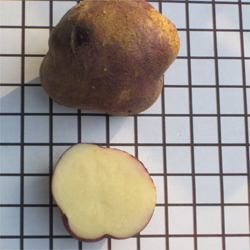 |
||||||||||||||||||||||
| Institut de Beauvais, Violette
A sport of the French Heritage variety - unkown parentage - the flesh appears more starchy. Source: AN J11 Local grower: What's the best use in the kitchen for this multi-purpose, starchy variety? |
||||||||||||||||||||||
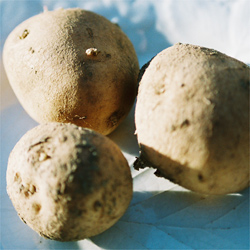 |
Iopride
Small, blocky white tubers. A cross of Irish Cobbler x IA 1165-14 released in IA in 1970. Source: ME BO W07 Local grower: Best use in the kitchen: Great for American Fries and Rösti. |
|||||||||||||||||||||
| Irish Cobbler
Large, oval to oblong growing, white tuber. One of the oldest cultivated varieties, a mutant of Early Rose, released in 1876. GRIN: AV 17 Source: ME BO W10 Alt Source: CV Ron and CV Fe5 Local grower: Curzio |
||||||||||||||||||||||
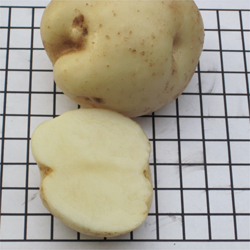 |
||||||||||||||||||||||
| What's the best use in the kitchen for this multi purpose potato? The taste is creamy with a light earthy flavor, as the flesh melts in your mouth. The skin is thin. | ||||||||||||||||||||||
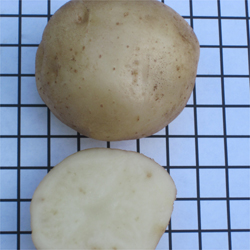 |
Irish Peace
Small-medium, oval, white tuber with light purple eyes. A Northern Ireland cross of Craigs Royal x Katahdin released in 1973. Source: LA D 12 Local grower: Curzio What's the best use in the kitchen for this starchy variety? We tasted this potato and found it flaky, with mild flavor. The skin is very thin. We believe this could be a good choice for pan frying or roasting with spices, like curry. |
|||||||||||||||||||||
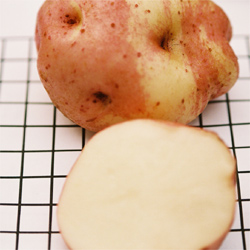 |
Irish Treasure
Medium-large, round tubers, white flesh with pink spots, excellent yields and very good storage. Exceptional vine growth may benefit from pruning. Opportunistic (see Gurney's Everbearing) Source: ND KL C01, MI B07 Local grower: FredB Seems to be a waxing potato with thin skin - try to pan roast with skin to high-light the attractive skin colors. |
|||||||||||||||||||||
| Isla Caucahua
Medium-small round tubers, light yellow skin and cream flesh. From South America. Keeps quite well - we tasted this variety mid June with tubers harvested the year before. Tall Vines Source: ME BO W08 Local grower: Curzio Grown in an 18" tall bag in 2013, ONE tuber produced 18.5 oz, 19 tubers, mostly mini. While in 2011 a 14" black bag produced 31 oz, 66 tubers, including 30 micro. This comparison points to a higher yield in the 18" tall bag, as more compost in the bag likely prevents the high number of micro tubers. |
||||||||||||||||||||||
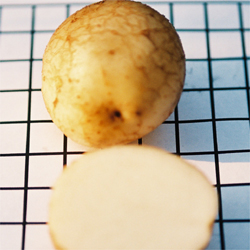 |
||||||||||||||||||||||
| For 2014 we have flagged this variety for further testing in 18" tall bags with seed crowding. We wish to test how vines bulk tubers with 2 vs 4 starting mini tubers. The goal is to keep the number of micro tubers as low as possible, while increasing the number of tubers in the 1-2 oz range. This is a tuber size chefs purchase as "early potato", BUT are very difficult to find later as mini tubers don't store as well.
What's the best use in the kitchen for these starchy, small tubers? We tasted this potato and found it starchy and creamy with a slight hint of bitterness. The skin is medium thick. |
||||||||||||||||||||||
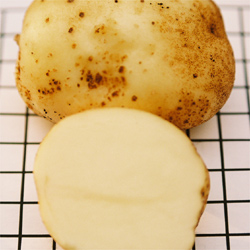 |
Island Sunshine
Round tubers with creamy yellow flesh. Developed by the Loo brothers, organic farmers on Prince Edward Island, Island Sunshine is the result of natural selection. Different from most breeding programs where the selections are 'pampered' (given insect and disease control), the Loo brothers selected only crosses that survived insect and disease pressure without controls. Released in 1984. Source: ME BO W07 Alt Source: CV Wo6 Local grower: |
|||||||||||||||||||||
| Great for eating all winter! Boiling and baking | ||||||||||||||||||||||
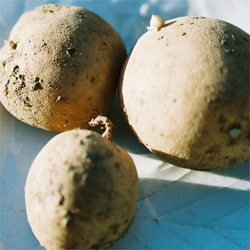 |
Itasca
Large white tubers, smooth, round to blocky and oblong. The tubers elongate as they increase in size. Well suited for dry soil. A cross of MN304.72-10 x ND58-3 released in MN in 1994. Source: ME BO W07 Local grower: Best use in the kitchen: Great for American Fries and Rösti. |
|||||||||||||||||||||
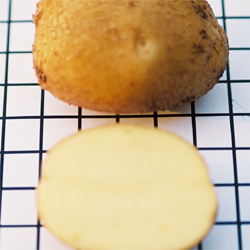 |
Jämtlandsk Vit, aka Delbopotatis, Gammal vitpotatis, Jokkmokk
Medium-large tubers, (vit is white in Swedish but the skin is buff and the flesh is pale yellow) flattened, round. Reported to be brought to Sweden by Jonas Alströmer in 1720. GRIN: PI 607480 Source: ME BO W07 Local grower: What's the best use in the kitchen for this multi-purpose variety ? |
|||||||||||||||||||||
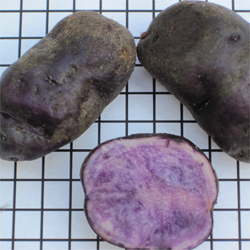 |
Jewett, aka Blue Marker
Medium-large tubers, with tendency to grow blocky to oblong tubers with purple skin and dark flesh, named by Canadian Ryan Dwyer for a local school. It is likely identical to most All Blue types, but this strain has a very high yield compared to all other known strains. Ryan also reports this strain has strong resistance to freezing [winter survival in the soil] and it produces berries very well at his latitude in Canada. The berries left in the soil produced lots of TPS seedlings in the spring. |
|||||||||||||||||||||
| The dark color of the flesh varies. The cut tuber in this picture is lighter than other tubers we have cut.
Source: CAN DWR13 Local grower: Curzio Grown in two 18" tall bags to compare yield with seed crowding. 2 tubers in full sun produced 18.5 oz, 33 tubers, mostly mini in 1-2 oz range, while the bag with just one tuber produced 49 oz, 30 tubers, of which 7 above 2 oz, 18 mini and just 5 micro. Flagged to be started in a hoophouse in 2014 to test how an earlier emergence may change the yield. What's the best use in the kitchen for this very starchy variety? We tasted this variety and found it flaky and very dry, with very bland taste. The skin is medium-thick and peels very easily after cooking. The flesh keeps the dark hue after cooking, especially if the potato is not boiled. It should make stunning blue chips or fries. |
||||||||||||||||||||||
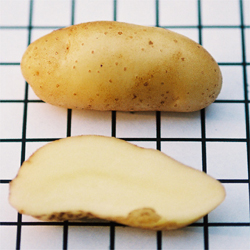 |
||||||||||||||||||||||
| Jögeva Yellow Estonian
A yellow flesh fingerling potato from the collection of Alex Caron, Ontario. Jögeva must be the name of an Estonian Potato Breeder, as this name is found for many Estonian varieties. Shown in this picture grown from an in-vitro seedling - the size is quite accurate for spuds grown from a tuber as a seed piece. Source: AgriCanada 09 Local grower: Curzio |
||||||||||||||||||||||
| What's the best use in the kitchen for this waxy variety? It reminds us of the Peanut variety - we should compare them. We tasted this variety and found it bitter with thicker skin. Not a favorite if boiled in a soup. | ||||||||||||||||||||||
| Johnny Gunter - strain # 1
Medium-large round, knobby tubers with red blotched skin and cream white flesh. American heirloom variety donated by Jerry Gatchell - google Johnny Gunter and Tom Titus for the whole story. This potato grows TALL VINES and may be a good choice for growing in containers. Source: OR GA J 13 Local grower: Curzio Grown in 2013 in an 18" tall bag, 3 tubers prodoced 55 oz., 35 tubers, 8 above 2 oz, 24 mini and just 3 micro. |
||||||||||||||||||||||
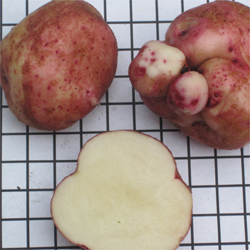 |
||||||||||||||||||||||
| What's the best use in the kitchen for this starchy potato? We tasted this potato and found it flaky, with mild flavor. The skin is medium thick. | ||||||||||||||||||||||
| Johnny Gunter - strain # 2
Medium-large round, knobby tubers with red blotched skin and cream white flesh. Tubers received from a different source being grown side by side to compare to strain # 1. Source: WA HO C 13 Local grower: Curzio Grown in 2014 in two 18" bags with 3 and 5 starting tubers to compare yield with seed crowding. |
||||||||||||||||||||||
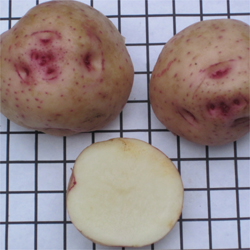 |
||||||||||||||||||||||
| Johnny Gunter - strain # 3
Medium-small round, smooth tubers with yellow skin and white flesh. I found this sport in a Johnny Gunter bag in 2013 - not sure if in strain 1 or 2. This strains' vines are done much sooner than the other two. I'll be growing this for a number of years to see if it keeps it's feature. Source: CA C 13 Local grower: Curzio |
||||||||||||||||||||||
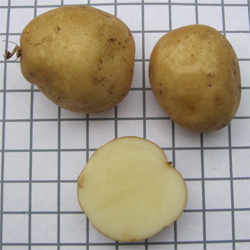 |
||||||||||||||||||||||
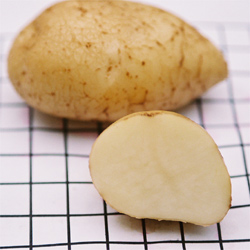 |
Jøssing
Small, egg-shaped white tubers, very smooth and regular, with white-yellow flesh. A 1945 Norwegian cultivar (Louis Botha x Jubel). Source: ME BO W07 Local grower: EbbaJ What's the best use in the kitchen? |
|||||||||||||||||||||
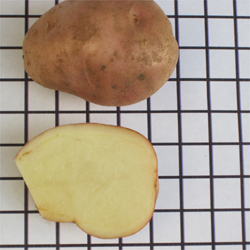 |
July
Small, flat-oblong light red tubers. A 1999 French fresh market cultivar. Who knows how it taste? We must all have sick tubers with no decent crops to cook? Source: ME BO W07 - SSE 1048 Local grower: What's the best use in the kitchen? |
|||||||||||||||||||||
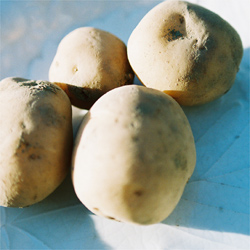 |
Kandidat
Medium, round-oval tubers with yellow skin and white flesh. A cross of Aquila x Seedling released in 1965 in Russia. GRIN: PI 362729 Source: ME BO W07 - SSE 1048 Local grower: What's the best use in the kitchen? |
|||||||||||||||||||||
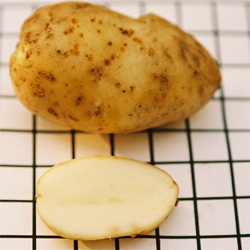 |
Karina
Oblong, tapered tubers No historic info available, likely German origin. Source: ME BO W07 Local grower: What's the best use in the kitchen? |
|||||||||||||||||||||
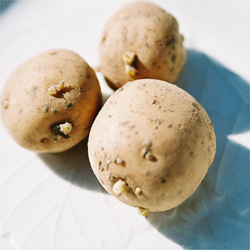 |
Kasjuri
Small round, flat tubers No historic info available, likely Austrian origin. Source: ME BO W07 Local grower: What's the best use in the kitchen? |
|||||||||||||||||||||
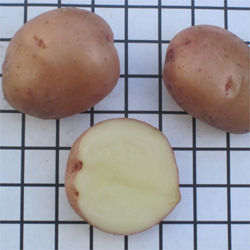 |
Kasota
Medium-small, round to oval, flat tubers with pink skin and cream color flesh. A variety with very interesting pedigree. Kasota is a cross of Minn. 29-13 x Triumph released by the University of Minnesota in 1943. The parentage of Minn. 29-13 is not that interesting, but originates with Early Rose and Garnet Chili. Much more interesting is the parentage of Triumph, a cross of Peerless x Early Rose. Both Peerless and Early Rose are siblings, both seedlings of Garnet Chili! |
|||||||||||||||||||||
| That makes Kasota a very close relative of Garnet Chili - 90 years removed in time but only three generations: Garnet Chili > Early Rose/Peerless > Triumph > Kasota.
Source: SSE LAB13 Local grower: Curzio Grown in 2013 in a sub-irrigation box from in-vitro material provided by SSE. What's the best use in the kitchen starchy variety? We tasted this potato and found it flaky but moist, with a bland taste. The skin is thin. |
||||||||||||||||||||||
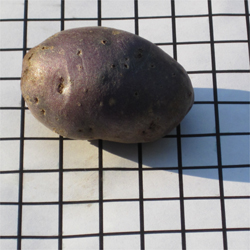 |
Kefermarkt Blau
Medium, oval to oblong growing, tuber with blue skin and blue flesh. Austrian heritage. Source: ME BO W10 Local grower: What's the best use in the kitchen for this potato? |
|||||||||||||||||||||
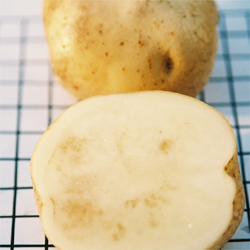 |
Kemerovskii
Medium-small round-oval tubers, light yellow skin and white flesh. From Russia, a selected clone of Volzhanskii. Great potential for the 99 pounds yield. Very Tall Vines Source: ME BO W08 Local grower: What's the best use in the kitchen for this starchy multi-purpose variety? |
|||||||||||||||||||||
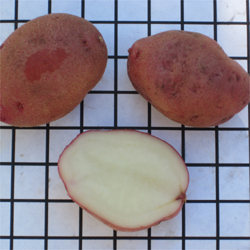 |
Kenosha 1st Red
Medium-small oval to oblong tubers produced on vines started with open pollinated seed [TPS] harvested from Blossom in 2010. I decided to name this variety after just 2 years because I noticed it sets tubers high and serial on long stolons. The vines have produced seed berries. It will be interesting to see if further progeny produces darker red flesh color. Local grower: Curzio |
|||||||||||||||||||||
| Grown in 2013 in an 18" tall bag, 3 tubers produced 19 oz, 38 tubers, none above 2 oz, 26 mini and 12 micro. Not an impressive yield but the vines produced berries. It is interesting to grow varieties which have red flesh in the parentage, as darker red flesh may return as a feature in the progeny. The lower yield would not justify the extra effort to grow it in a taller bag, but the chances to produce berries warrants the 4" of additional compost.
Also I've noticed that Blossom which grew in 2013 in a 14" Poppy Orange bag produced larger tubers in the shorter bag. The Blossom vines first set seed berries, but the berries did not mature. What's the best use in the kitchen for this starchy multi-purpose variety? We tasted this potato and found it flaky but moist, with good taste. The skin is medium thin. |
||||||||||||||||||||||
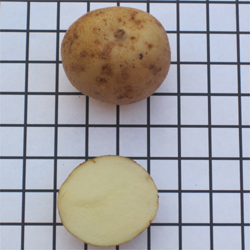 |
||||||||||||||||||||||
| Kenya Akiba
Medium-large round to oblong tubers, light yellow skin and white flesh. Unknown parentage, as this tuber has been selected from 100K TPS [botanical seed] seedlings, exposed to disease and chosen for horizontal resistance by Dr. Raoul Robinson in Kenya. For more info on Dr. Robinson's theory google "Amateur Potato Breeder Manual". Akiba is Swahili for Good Saver. |
||||||||||||||||||||||
| Source: US Genebank 12 Local grower: Curzio
What's the best use in the kitchen for this starchy multi-purpose variety? |
||||||||||||||||||||||
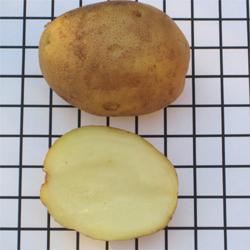 |
||||||||||||||||||||||
| Kenya Baraka
Medium-large round-oval tubers, light yellow skin and white flesh. See Kenya Akiba for parentage info. In 2012 Kenya Baraka was grown in a 14" tall, black bag to test for how high this vine sets tuber, the purpose of this study is to find out which varieties grow best in containers, find specific info on www.kenoshapotato.com, this var. is mentioned as one of the best grown in containers, as in extreme drought 2012, no watering conditions, has grown mostly larger tubers [2 small, 20 mini vs only 7 micro] showing high tolerance to drought and heat, as could be expected from an African variety. |
||||||||||||||||||||||
| Baraka is Swahili for Good Luck / Blessings.
Source: US Genebank 12 Local grower: Curzio What's the best use in the kitchen for this starchy multi-purpose variety? |
||||||||||||||||||||||
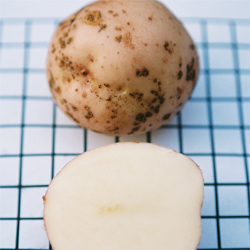 |
||||||||||||||||||||||
| Kerr's Pink
Medium-small round-oval tubers, pink red skin and creamy flesh. British variety developed by James Henry in 1907 as a cross of Fortyfold and Smiths Early (but features a late maturity). Sets true seed pods. GRIN: PI 574539 Source: ME BO W09 Alt Source: CV Ron CV Ma23 Local grower: Curzio What's the best use in the kitchen for this smaller tuber that appears to cook starchy? |
||||||||||||||||||||||
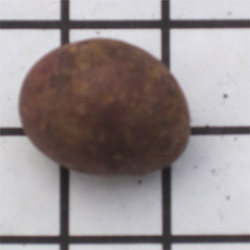 |
Kestrel
Small to medium, oval to oblong tuber, purple blotched skin and cream flesh, a cross of a seedling of S. Vernei x Cara released in 1992 in UK. Source: LA D 12 Local grower: What's the best use in the kitchen for this waxy potato? |
|||||||||||||||||||||
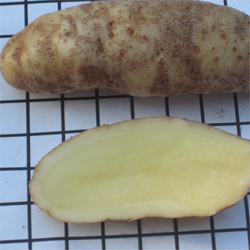 |
Kifli
Smallest variety of fingerling as reported by AgriCanada to be an excellent salad potato variety to use sliced or whole. As you can see in the picture it can grow to 4" length. Source: AgriCanada 10 Alt Source: CV Ron sold as Kipfel Fingerling Local grower: What's the best use in the kitchen for this waxy potato? |
|||||||||||||||||||||
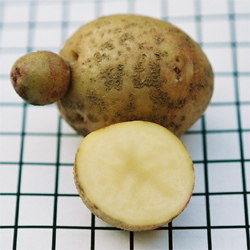 |
King Edward
Oblong, round tubers, yellowish skin with pink markings, white-cream flesh and shallows eyes. It can be used for boiling, chipping and baking. It is a mid to late season type. Released in 1902 as a cross of Magnum Bonum x Beauty of Hebron. The name is to honor King Edward VII who was coronated in 1902. GRIN: PI 407420 Source: ME BO W07 Local grower: What's the best use in the kitchen? |
|||||||||||||||||||||
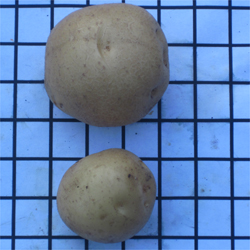 |
King George V
Medium to large, oval to oblong white tubers, bred by J.Butler, Scotter, Lincolnshire and released in 1911. Source: LA D 12 Local grower: What's the best use in the kitchen? |
|||||||||||||||||||||
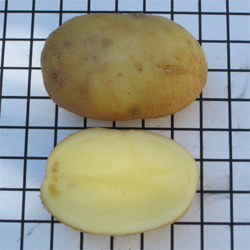 |
Koto
Medium-small size, yellow skin and flesh round to oblong tuber. A cross of Eigenheimer x Kalev, bred in Finland in 1961 by Agrifood Research Finland. Source: ME BO W10 Local grower: Curzio Grown in a 14" Poppy Orange bag in 2013 it produced only 15 oz, 16 tubers, 1 standard, 14 mini and just one micro. It will be tested in 2014 to optimize seed crowding with 3 vs 5 mini seed tubers. |
|||||||||||||||||||||
| What's the best use in the kitchen for this waxy potato? We have tasted this potato and found it to be perfect to pair with fish, as expected with a Finnish variety. The flavor is nice and earthy, the flesh is creamy and the skin is medium-thin with nutty flavor. | ||||||||||||||||||||||
| Kroop Neber
A Dutch variety of unknown parentage - interesting that this clone was the most requested at AgriCanada in 2010. Small eye drop shaped tubers with yellow skin and flesh. Source: AgriCanada12 Local grower: Curzio Grown in 2013 in an 18" tall bag with high setting tubers which did not bulk. I'm planning to grow it in a 14" Poppy Orange bag in 2014 with 8 mini seed tubers to test how well this variety produces with crowded seed when grown in a container. |
||||||||||||||||||||||
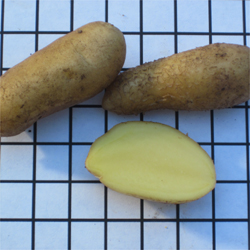 |
||||||||||||||||||||||
| What's the best use in the kitchen for this waxy potato? we tasted this potato and found it very creamy, mildly nutty flavor. It features a thin skin and is probably best cooked whole with the skin. Should make a great side dish pan-fried in olive oil with rosmary. | ||||||||||||||||||||||
| Kubanische Rote, Red Cuban
Medium round-oval tubers, pale red skin and light yellow flesh. From former Eastern German collection, believed to be collected in Cuba by Russian researcher in Cuba. Source: ME BO W08 Local grower: Curzio What's the best use in the kitchen? A starchy red - red tubers are usually waxy but this seems starchy, buttery. |
||||||||||||||||||||||
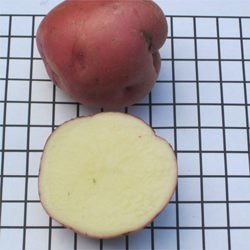 |
||||||||||||||||||||||
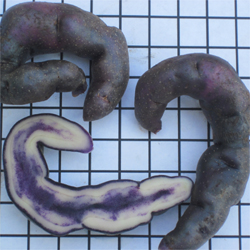 |
Khuchi Akita
3 to 5" long growing Bolivian landrace tubers [S. stenotomum], with dark purple to lavender skin and cream - purple core flesh. Tom Wagner is reporting that he was able to breed off-spring which keeps the interesting tuber shapes. Source: US Genebank 13 Local grower: Curzio Grown in 2013 in a 14" Poppy Orange bag it produced 6 oz, 10 tubers of which 6 in standard size, 2 mini and 2 micro. It set seed berries which did not mature here in Kenosha. It will be interesting to test how to increase the yields. |
|||||||||||||||||||||
| What's the best use in the kitchen for this starchy tuber? We tasted this potato and found it flaky, not too dry, with a slightly bitter, nutty flavor. It features medium-thin skin which transfer the color to the flesh after cooking. Not all skins are very dark, but dark skins will leave on the flesh surface a stunning dark blue. The very appealing shape allows for cooking the tubers whole [they cook in 15-20 minutes] and would make a fantastic addition to any vegetable dish. | ||||||||||||||||||||||
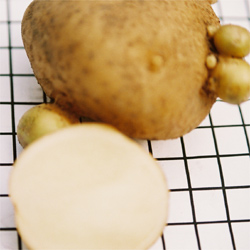 |
Kufri Jeevan
Medium size, flat, oblong, tubers with light yellow flesh Kufri is the Indian location of the Potato Research Institute. There are several dozen of Kufri labeled varieties - all with different features. Jeevan develops true seed. Also, noticed TPS left in a raised bed developed small plants in May. Extremely early tuber set. Found seed pieces in the bag mid April with small tubers developing from 1 inch long stolons. Tuber set in the storage bag is a first for me! Very early vine emergence. Tall Vines Sets true seed pods. |
|||||||||||||||||||||
| GRIN: PI 362717 Source: ME BO W07 Local grower: FredB, LynnA
What's the best use in the kitchen for this starchy variety? We have tasted this potato and found it very creamy, with a hint of nutmeg. The skin is medium thin. |
||||||||||||||||||||||
| La Ratte (aka Ratte, Corne de Mouton)
Small-medium, fingerling type tubers, originated in France 1872. The name translates to "the mouse", which in German translates to "Ratte". The latter originates from Austria - I'm planning to grow them both next year and compare for difference in the two strains. Also you may find the name La Ratte d'Ardèche - this name points to a very specific mountain area of France - only tubers grown in that area can be named "d'Ardèche"! Source: MA C08 Local grower: Alt Source: CV Ron - Cv Fe5 CV Ma23 and CV Se16 |
||||||||||||||||||||||
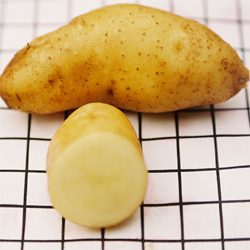 |
||||||||||||||||||||||
| Best use in the kitchen: Pan roasted or in a French Potato Salad | ||||||||||||||||||||||
| La Royale (not aka Royal Kidney)
A French Heritage variety - unkown parentage. Round to oval tubers with red skin and pale yellow flesh. Appears to be an early variety. Source: AN J11 Local grower: What's the best use in the kitchen for this multi-purpose, starchy variety? We have tasted this potato and found it sweet and creamy, with a light nutty undertone.The skin is medium thin. |
||||||||||||||||||||||
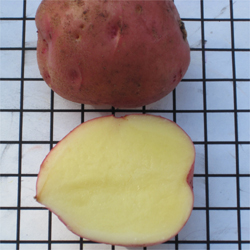 |
||||||||||||||||||||||
| La Veine Rose, aka La Belle Rose
Long-oval shaped with light pink skin. Distinctive feature is the rose marbling under the skin around the eyes. Interesting study by Dr. Fu at AgriCanada shows genetic dissimilarity close to cultivar Early Rose and Garnet Chili which may suggest a parentage. Source: AgriCanada 09 Local grower: What's the best use in the kitchen for this waxy variety? |
||||||||||||||||||||||
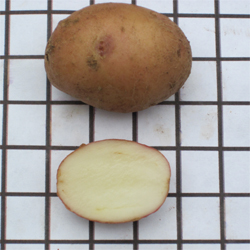 |
||||||||||||||||||||||
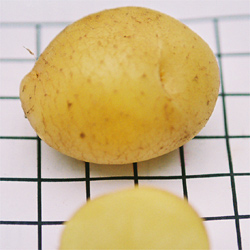 |
Laram Ajawiri
Small, round tubers, yellow flesh, donated from Peru. Very rare variety. The name Ajawiri suggests this variety belongs to the Ajanhuiri potato group (Solanum ajanhuiri) which features 24 chromosomes instead of 48, same as the blue skinned varieites Ajawiri, Negresse and Violette. GRIN: PI 599279 Source: MI B07 Local grower: Curzio |
|||||||||||||||||||||
| Best use in the kitchen: Try to cut in quarters and cook to make Home Style Crunchy Fries. Or try to boil and toss in a fresh green salad, like this wonderlful fresh dandelion salad. | ||||||||||||||||||||||
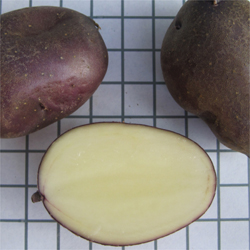 |
||||||||||||||||||||||
| Land League
Medium - small oval and flat shaped tubers with dark purple skin and cream color flesh. I need to do some research on the origin of this heirloom variety. I have seen this name in an Irish document. Source: SSE HF 14 Local grower Curzio |
||||||||||||||||||||||
| What's the best use in the kitchen for this starchy potato? We have tasted this potato and found it remarkably bitter. It features a medium thin skin with obvious bitter aftertaste. But the flesh without the skin also has a bitter aftertaste. It may make a great roasted potato. The bitter aftertaste may pair well with other ingredients in your recipes. | ||||||||||||||||||||||
| Lauterbrunnen
Heritage Swiss variety, grows many small round tubers with red skin and pale yellow flesh. It grows Tall Vines and extremely long stolons - interesting variety to grow in tall potato boxes. Source: PSR Local grower: What's the best use in the kitchen for this waxy potato? |
||||||||||||||||||||||
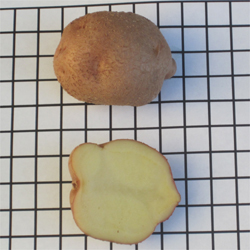 |
||||||||||||||||||||||
| GRIN: AV 29 Alt Source: CV Ron and CV Fe5 Local grower:
What's the best use in the kitchen? The standard for French Fryes |
||||||||||||||||||||||
| Laverton
Medium-small tubers with purple-yellow skin and dark yellow flesh. Bred by Tom Wagner as part of his Skagit Valley Gold series with unknown male pollen donor. Tom Wagner has been researching for crosses to offer as Papa Criolla, varieties with dark yellow flesh. Source: WASTD13 Local grower: Curzio Grown in 2013 in a 14" black bag, 3 mini tubers produced only 7 oz, 14 min vs 20 micro. The stolons grow long and set serial tubers. Higher yields may be obtained by starting the tubers earlier and allowing more day light hours. |
||||||||||||||||||||||
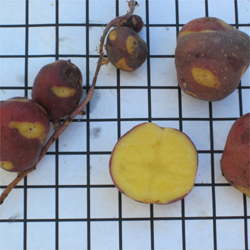 |
||||||||||||||||||||||
| What's the best use in the kitchen for this waxy variety? We have tasted this potato and found it creamy, sweet and very tasty. The skin is very thin [perhaps because I've harvested too early?]. | ||||||||||||||||||||||
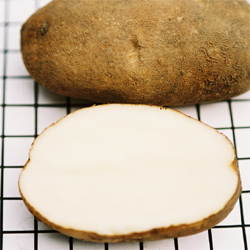 |
Lemhi Russet
Medium size, oblong, tubers, medium to heavy netted skins, shallow eyes, dense high white flesh, late maturity. A cross of Pioneer x A63126-8 released by USDA in 1981. GRIN: AV 20 Source: ME BO W07 Alt Source: CV Ron Local grower: Excellent for baking |
|||||||||||||||||||||
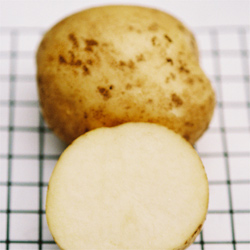 |
Lenape
Medium size, round tubers, developed in PA for pest resistance, but found to have excessive levels of glucose-alkaloids for human food (TGA). A cross of USDA S47156 x USDA B3672-3 released in 1967 - cv. holds DNA of grand-parent Solanum chacoense that attributes exceptionally high specific gravity. Sets true seed pods. GRIN: AV 21 Source: ME BO W07 Local grower: Curzio |
|||||||||||||||||||||
| Seems to have high levels of moisture - perhaps best in soups. If you are concerned with the high levels TGA, perhaps you should peel these tubers! It has been proven that high level TGA are concentrated in the skin as part of the tuber's defense from pest attacks. On the other hand, especially if this tuber is not eaten in large quantities, you may find benefits in high Alkaloids levels - apparently the Alkaloids increase the flavor ... it's a fine line between very flavorful and bitter.
In 2011 I had flagged this variety to be dropped [eat the whole crop], but then I reconsidered because it has an interesting taste, and may have medicinal benefits as a super-waxy variety. |
||||||||||||||||||||||
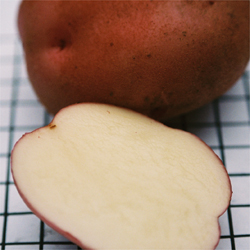 |
Lennoxville Rose
Medium round-oblong tubers, red skin and white flesh. Lennoxville is in Quebec, Canada. Rare heirloom variety. Grown in a black SmartBag in 2011 - one of the very last vines to die off. Noticed upon harvesting that a few tubers started to resprout. This is a usually unwanted feature [perhaps a sign of very short dormancy - poor storage?]. I thought it would be interesting to report this observation because perhaps this variety could allow for two seasons growing in temperate regions. Plant in the spring and replant in the fall? Please give me feedback if it works for you. This picture shows tubers harvested in October with the sprouts. Notice how in the cut piece the dark red skin color bleeds into the white flesh. Source: ME BO W08 Local grower: What is the best use in the kitchen of this very starchy tuber? The skin detaches after boiling - a novel cooking idea: Steam small tubers whole for "skin-less" pink potato - show off the pink color that bleeds into the flesh. We detected a hint of hazelnut in the nutty flavor. |
|||||||||||||||||||||
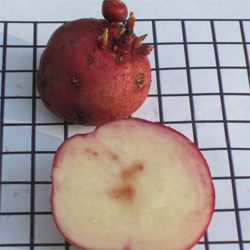 |
||||||||||||||||||||||
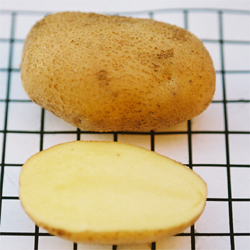 |
Lila's German Yellow
Medium round-oval tubers, yellow skin and flesh. Perhaps from German migrants to Canada. Source: ME BO W08 Local grower: What's the best use in the kitchen for this waxy variety? |
|||||||||||||||||||||
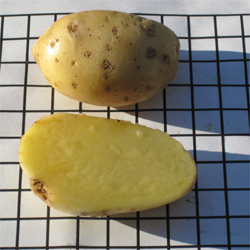 |
Linzer Gelbe, Delikatesse
A popular market potato in Europe, released in 1974 in Linz, Austria. Grows a good crop of medium-small oval to long tubers with yellow skin and yellow flesh. Sets tubers high and in series. Source: ME BO W10 Local grower: Curzio What's the best use in the kitchen for this waxy potato? |
|||||||||||||||||||||
| Linzer Rose, Linzer Rote, Pink
A popular market potato in Europe, released in 1969 in Linz, Austria. Grows a good crop of medium-small oval, flat tubers with pale red skin and tasty yellow flesh. Sets tubers high and in series. Source: ME BO W10 Local grower: Curzio What's the best use in the kitchen for this waxy potato? |
||||||||||||||||||||||
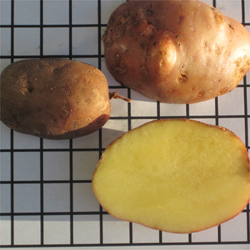 |
||||||||||||||||||||||
| Llumchuy Waqachi
Small Andean landrace tuber. Very difficult to grow because it needs a very long growing season. The name translates to "Makes your Daughter-in-Law Cry" - which hints on how difficult peeling would be! Follow this link to a Peruvian Catalog and you will find many varieties with the Waqachi name and pictures which show much deeper eyes and knobbs. This variety seems to be Puka Llumchuy Waqachi. |
||||||||||||||||||||||
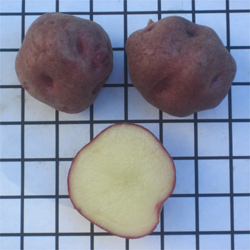 |
||||||||||||||||||||||
| Source: US Genebank 13 Local grower: Curzio
What's the best use in the kitchen for this waxy potato? We have tasted this potato and found it flaky but moist, with strong flavor and a bitter aftertaste. The skin is medium thick and bitter. One could guess that these tubers may be left in the ground to harden the skins and ensure longer storage. The thicker skins would be very hard to remove, perhaps a punishment for your daughter-in-law. |
||||||||||||||||||||||
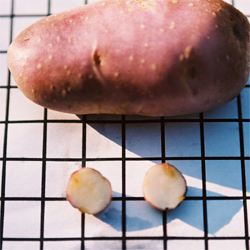 |
Long Blueish, Purple Chief
Medium-large oblong tubers, purple skin and white flesh. Source: ME BO W08 Local grower: Best use in the kitchen: Very dry and mealy, excellent baker, reports Bill Higgins. |
|||||||||||||||||||||
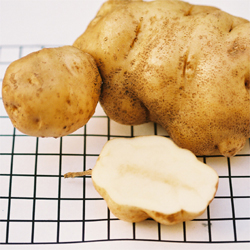 |
Lumpers
Medium - large "lumpy-shaped" tubers with white skin and white flesh. Bred in Ireland and infamous for its vulnerability to blight which cause the Irish potato famine in the 1840's. W3 claims that this cultivar is terrific for traditional Irish Boxdy. Released about 1800. Interesting observation on the yield from virus free tubers donated by AgriCanada. One tuber yielded 2#13oz - the other just one large tuber of 11oz weight (see picture). Tall Vines Source: PA WE W08 |
|||||||||||||||||||||
| Local grower: Curzio
What's the best use in the kitchen? Potato Griddle Cakes - We need to compare the taste with Irish Rocks and other similar Irish white varieties. |
||||||||||||||||||||||
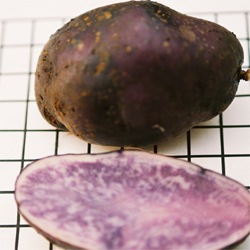 |
MacIntosh Black
Medium-large blocky oblong tubers, dark purple skin and purple flesh. Source: ME BO W08 Local grower: Curzio What's the best use in the kitchen for this starchy variety? We have tasted this potato and found it dry. The flesh falls apart rather quickly in a soup, yet the texture feels sandy. Poor taste in a vegetable soup. |
|||||||||||||||||||||
| Perhaps this variety could work to make blue fries. The tubers we cut in 2012 had much darker flesh and kept the color well after cooking. | ||||||||||||||||||||||
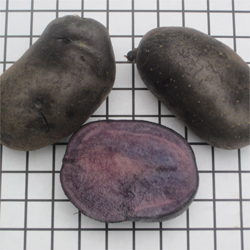 |
Magic Molly
Medium-large blocky to oblong tubers, dark purple skin and purple flesh. A new purple from Alaska with lots of medium oval nuggets on a most interesting fibrous root system. Huge stolons, upright plants and a promising dandy for the kids to marvel over. Seedling from Red Beauty produced by Bill Campbell, Alaska Plant Materials Center. Selected seedling named after his daughter. Very interesting that a marketing scheme is promoting this variety as a fingerling! While it just seems to be an oblong tuber. Perhaps looks like a fingerling if harvested early. Source: CV Fe5 2012 Local grower: Curzio Grown in 2013 in two bags to compare yields in 14" vs 18" tall bags. The results were very similar for 3 seed pieces in each bag, total yield of 25 oz., 30 tubers in a 14" black bag [full sun] vs. 23. oz, 30 tubers in an 18" tan bag [partial sun]. Both bags produced the same amount on over 2oz tubers [2] and 24 mini tubers, very few micro tubers. |
|||||||||||||||||||||
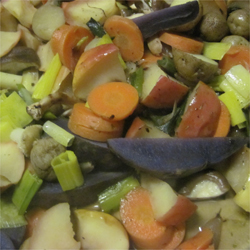 |
||||||||||||||||||||||
| What's the best use in the kitchen for this starchy variety? We have tasted this potato and found it starchy, but not too dry, with good flavor - one of the best in the blue fleshed varieties. Great purple hue after cooking as shown in this picture. It features a thick skin, easy to remove after cooking; would make a beautiful fluffy mashed potatoe (try a baked "Rosette au Four" over a stew). | ||||||||||||||||||||||
| Magnum Bonum
Medium-large oblong tubers with buff skin and cream flesh. A cross of Early Rose x Patersons Victoria, dev. by James Clark, Hampshire, England - released in 1876. Source: AA E 09 Local grower: Curzio What's the best use in the kitchen for this starchy variety? |
||||||||||||||||||||||
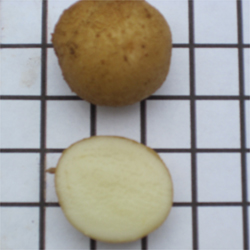 |
||||||||||||||||||||||
| Makah > compare to Ozette
A strain offered the first time in 2014 by SSE as healthy seed tubers. I believe they are virtually identical to Ozette. 2014 we found very interesting results in seed crowding to be examined again in 2015. Source: SSE HF 14 Local grower: Curzio Grown in TWO 18" bags in 2014 to compare yield with 1 vs 3 starting seed tubers. Really counter intuitive because in the past we found Ozette to produce better |
||||||||||||||||||||||
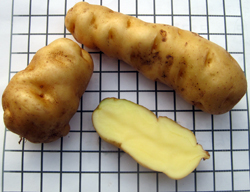 |
||||||||||||||||||||||
| yields when crowded in a furrow 6" vs 12" apart. In a growing bag one tuber produced 67 oz, 64 tubers, while the bag with 3 starting tubers produced 29 oz, 41 tubers. A much worst production with seed crowding. Planning to repeat the experiment in 2015 with 1 vs 2 starting tubers.
What's the best use in the kitchen? |
||||||||||||||||||||||
| Mama Amarilla
Medium-large round tubers with yellow flesh and skin. A difficult variety to store over-winter. Wallace Condon grows it in California in the fall and claims it's the best tasting out of hundreds he once grew in his large collection. Very difficult to grow at lower altitude - 4000 ft above sea level are required! Source: CA CO W 09 Local grower: NOBODY What's the best use in the kitchen? |
||||||||||||||||||||||
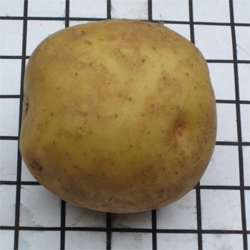 |
||||||||||||||||||||||
| Marc Warshaw's Quebec
Medium-small, round and flat potato with attractive bi-color yellow/dark pink skin and white flesh. This variety is a Canadian heirloom named for the Seed of Diversity member who collected it from a local farmer in Buckland, Quebec. Reported to grow vines that are not too attractive to bugs ... "the last vines bugs visit in my garden", said a Canadian gardener. Source: AgriCanada 13 Local grower: Curzio |
||||||||||||||||||||||
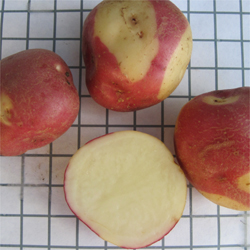 |
||||||||||||||||||||||
| Grown in 2013 in a sub-irrigation box from plant material received in-vitro. At harvest time I noticed some tubers to have more yellow than red in the skin pattern, and I've palnted them separately in 2014.
The 2014 comparison of two 14" bags, both planted with 4 starting tubers, produced an almost identical crop of 37 and 33 oz for a total of 87 tubers, of which 80 mini and only 7 micro. This variety may not produce tubers larger than 2 oz when grown in bags. Flagged for 2015 to compare 4 vs 6 starting tubers. What's the best use in the kitchen for this starchy variety? We tasted this variety and found it flaky, with a mild nutty flavor. The skin is thin. |
||||||||||||||||||||||
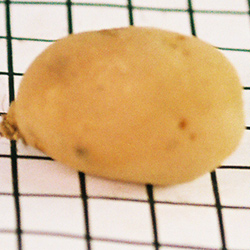 |
Maris Bard
Medium-large oblong tubers, white to pale yellow skin and white flesh. Like all Maris cultivars, originating from England, released in 1972 as a cross of Y15/139 x Ulster Prince. GRIN: PI 451705 Source: ME BO W08 Local grower: What's the best use in the kitchen? Reported to taste very good, retains white color and shape after boiling. |
|||||||||||||||||||||
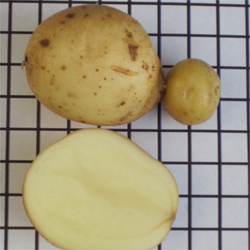 |
Maris Piper
Vigorous plants, good yield of variable oblong white tubers with yellow flesh, early-mid season, released in England in 1966 as a cross of Andigena x Ulster Knight x Arran Caim x Herald. Sets tuber high and may develop serial tubers on stolons. GRIN: PI 377745 Source: CV Ron 10 Alt Source: CV Ron (Marris Piper) Local grower: Curzio Grown in an 18" tall bag in 2013 - 3 mini produced only 12 oz, 23 tubers, including 20 mini and only 3 micro. |
|||||||||||||||||||||
| I'm particularly impressed by the multi-layer tuber setting on the vines. Even though the yield was rather small for the additional effort to grow it in an 18" bag,
In 2014 6 tubers produced 22.5 oz in a 14" Poppy Orange bag, still 20 mini and 4 micro, but 10 oz heavier yield. Flagged for testing in 2015 with 5 tubers. Seems to be a starchy potato with thin skin - try to pan roast with skin. |
||||||||||||||||||||||
| Maroon Bells
Hibrydized in Colorado and named for the Maroon Bells mountain southwest of Aspen, they grow in round shapes, with dark red skin, red flesh color. Very rare variety. Sets true seed pods Source: MI B07 Local grower: Curzio Starchy potato with thin skin - try to pan roast with skin. |
||||||||||||||||||||||
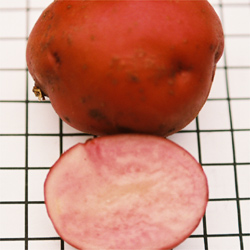 |
||||||||||||||||||||||
| Maroon Bells TPS 2010
Grown for the first time from OP botanical seed in 2010, this picture shows the tubers in their 4th year grown as a clone. Sets true seed pods Source: TPS on Maroon Bells in 2009 Local grower: Curzio We tasted this potato and found it more creamy than the female parent. The skin is very thin and the flesh cooks through a nice hue of pink. |
||||||||||||||||||||||
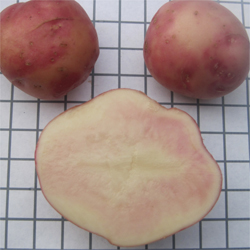 |
||||||||||||||||||||||
| Matsuyama
Medium - small, oval to oblong - flat tubers with light pink skin and white flesh. A Japanese variety for which I was not able to find parentage, nor historical info. Please send me an email if you have something to add. Source: AgriCanada12 Local grower: Curzio We tasted this potato and found it dry and flaky, with a hint of bitter. What's the best use in the kitchen for this tuber? |
||||||||||||||||||||||
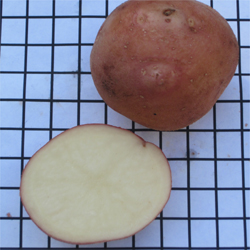 |
||||||||||||||||||||||
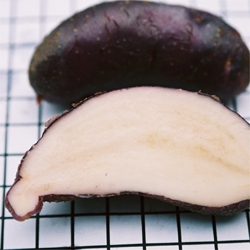 |
McIntyre Blue
Medium-large oblong to crescent, flattened tubers, purplish skin (often mixed with buff) and cream flesh. Origin and parenting unknown, but largely grown in gardens on Prince Edward Island, Canada. Tall Vines Source: ME BO W08 Local grower: Best use in the kitchen: looking for a recipe - tubers are starchy with medium thick skin - perhaps a fish dish? |
|||||||||||||||||||||
| This tuber cooks medium dry and flacky. Try cooking it with the peels, whole [not cut] to obtain a taste similar to a baked potato, slightly bitter, with a hint of metallic iron.
These tubers remind me of Cowhorn - perhaps two varieties to compare in the next taste testing? |
||||||||||||||||||||||
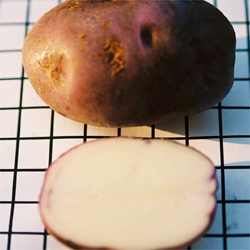 |
Mesabi Purple
Medium-large oblong tubers, purple skin and creamy flesh. Origin and parenting unknown, but Will Bonsall reports some knobby formation which points to older, landrace cultivars. Source: ME BO W08 SSE 1070 Local grower: What's the best use in the kitchen for this tuber that cooks very starchy? |
|||||||||||||||||||||
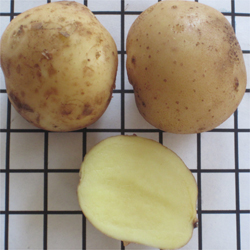 |
Michoacon
Small-medium round to oval tubers, white skin and pale yellow flesh. The state of Michoacan represents 8% of the total potato production in Mexico. A seedling of 65-BK-269 released in 1988. Could possibly be classified as a Mexican landrace - wondering if this variety may perform better at higher soil temperatures? Source: US Genebank12 PI 611108 Local grower: What's the best use in the kitchen for this tuber? |
|||||||||||||||||||||
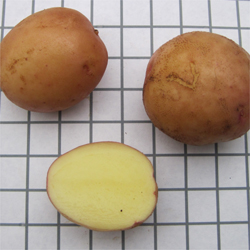 |
Michuacan
Small-medium round to oval tubers, pink skin and pale yellow flesh. Tubers received from Machado Farm in California. Rick is researching for potato which performs better in drought conditions. We are not sure about the correct spelling of the variety name, but likely the origin is Mexican. Source: CA MA R 13 Local grower: Curzio What's the best use in the kitchen for this tuber? |
|||||||||||||||||||||
| Midnight Beauty
Medium-large round-oval tubers, purple skin and light purple flesh. Rare. Vines are done in early August. Source: ME BO W08 SSE 1070 Local grower: Best use in the kitchen: a starchy tuber that turns grey after cooking. Falls apart quickly and may be used for mashed potato or thickening in soups. Blue French fries? |
||||||||||||||||||||||
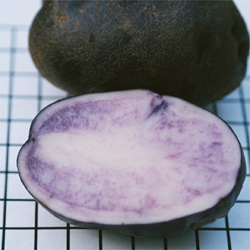 |
||||||||||||||||||||||
| We have tasted this potato and found it starchy, quite dry. It features a medium-thin skin which tastes bitter. The skin peals off very easily after boiling and leaves an intense blue hue on the flesh surface. | ||||||||||||||||||||||
| Mirton Pearl
Small-medium round tubers, white skin and flesh. A Canadian cross of Mira x F5318 - the NF Potato Breeding Program reports that this variety is the result of crosses of parentage tubers showing high resistance to wart disease: Mira's parent BRA9089 resulted from a cross of S. chiloense and 2 S. tuberosum varieties, including Switez from Poland; while F5318 may get high resistance to wart disease from its parents Katahdin and Sebago. Source: AgriCanada12 Local grower: Curzio |
||||||||||||||||||||||
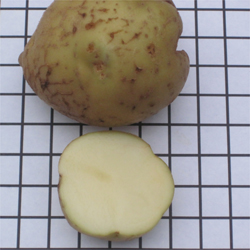 |
||||||||||||||||||||||
| What is the best use in the kitchen for this multi-purpose tuber? We taste this potato and found it to be waxy, with a mild flavor - a hint of bitter. It features a thick skin. | ||||||||||||||||||||||
| Monona
Medium size, round-oval tubers, developed by Frito-Lay in TX for chipping, but its lower density has made it drop from favor. A cross of USDA B1268-46 x USDA B1299-15 released in 1953. GRIN: AV 48 Source: ME BO W07 Local grower: What's the best use in the kitchen? |
||||||||||||||||||||||
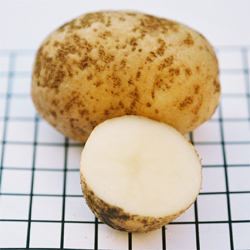 |
||||||||||||||||||||||
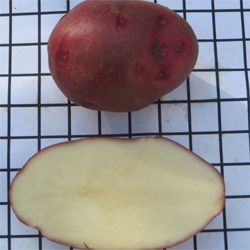 |
||||||||||||||||||||||
| Montañosa
Medium -large, oval to oblong tubers, red skin and cream flesh, donated from Peru and correctly spelled with a tilde over the second "n" to denote the proper Spanish pronunciation, meaning mountainous. Unknown parentage, may be classified as a Peruvian landrace, perhaps producing well at higher soil temperatures. See my 2012 "extreme drought season" picture of a 3.5 inch oblong tuber grown in a black growing bag, without any irrigation. |
||||||||||||||||||||||
| Source: US Genebank 12 Local grower:
We have tasted this potato and found it starchy, creamy and sweet. The skin is spicy. What's the best use in the kitchen for this starchy tuber? |
||||||||||||||||||||||
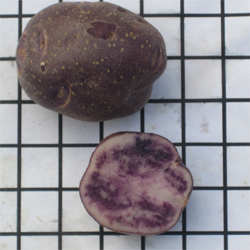 |
Morada Ojuda
Small-medium oval tubers, dark purple skin and white-purple flesh. Landrace from Los Lagos, Chile. Morada is Spanish for the color purple, while Ojuta stands for "large eyes". Grown in a black SmartBag in 2012 Morada Ojuda has produced over 140 tubers, 1 small [see picture, almost 2"], 40 mini and 103 micro. This variety produced the largest number of tubers in the extreme drought year of 2012. Source: US Genebank12 Local grower: Curzio |
|||||||||||||||||||||
| We tasted this potato and found it starchy, as it is expected with most purple fleshed tubers, but this variety is not as dry as Congo [All Blue and all synonyms]. The taste is good, the skin is thin and a little bitter What's the best use in the kitchen for this starchy tuber? | ||||||||||||||||||||||
| Morning Glory
Medium-large oblong tubers, yellow skin and pale yellow flesh. Rare. Released in 1965. Source: ME BO W08 Local grower: What's the best use in the kitchen for this starchy tuber? |
||||||||||||||||||||||
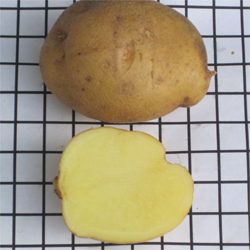 |
||||||||||||||||||||||
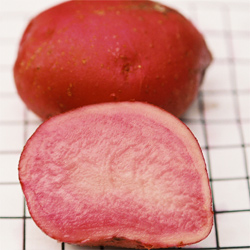 |
||||||||||||||||||||||
| Mountain Rose
Medium-large, oval to oblong tubers with dark red skin and white-red flesh. Developed by Dr. Holm in Colorado - this variety is not available for SSE Members - Google the name to find a commercial source to order from. One of the best producer in 2009 (3 seed pieces produced 7 pounds, mostly large tubers) in traditional furrow - great potential for the 99 pounds yield. Tall Vines Source: MA C08 Alt Source: CV Ron CV Ma23 CV Se16 Local grower: Curzio |
||||||||||||||||||||||
| Best use in the kitchen: Multi color potato chips? | ||||||||||||||||||||||
| Mr. Little Yetholm Gypsy
Perhaps the only known 3-color skin variety, here listed as mostly purple and tan, with red eyes, the flesh is cream. A medium - small, round to oval heirloom variety still grown by the Little family in the town of Yetholm in Scotland. The story goes that William Little purchased the tuber at a horse fair in the 1940's but it is believed to be a pre-1900 variety. Source: LA D 12 Local grower: Curzio Planted in early May in a 14" Orange Poppy bag, vines emerged May 23, harvested Aug 22, therefore I list it as early to mid-season. |
||||||||||||||||||||||
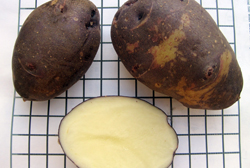 |
||||||||||||||||||||||
| What's the best use in the kitchen for this waxy potato? We tasted this potato and found it creamy with exceptional flavor, nutty with a slightly bitter aftertaste. The skin is thin with a bitter aftertaste. The skin color is stunning and the 3 colors maintain well after cooking. It makes a fantastic potato soup, especially if you are able to find enough mini tubers to cook whole, without cutting them. | ||||||||||||||||||||||
| Mrs. Moehrle Yellow Fleshed
Medium-large, long to oblong yellow fleshed tubers. Richard Smith, a SSE member in VT suggested we add this variety, reported to be a Canadian Heritage cultivar from the collection of Alex Caron. Source: VT SM R 10 Local grower: What's the best use in the kitchen for this waxy potato? Also it features a rather thick skin for a waxy potato .. perhaps it will work great in a baking recipe that requires less starch? |
||||||||||||||||||||||
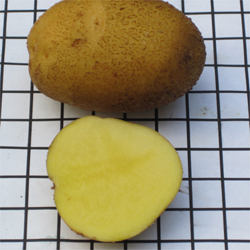 |
||||||||||||||||||||||
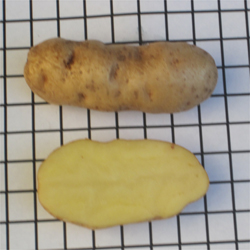 |
Multa
Medium-large fingerling tubers, yellow skin and flesh. Rare. A cross of Oberambacher Frühe x (Record x CPC1673-1) released in 1964 in Holland by breeder G.S. Mulder. GRIN: PI 407410 Source: ME BO W08 Local grower: lost What's the best use in the kitchen for this waxy tuber? |
|||||||||||||||||||||
| Muru
Medium - small oval tubers with bi-color yellow and purple skin and yellow flesh. A Peruvian cross. Tom Wagner reported on the Kenosha Potato Project Facebook Group: MURU grow like weeds since they are basically Solanum andigena, a sub species of tuberosum. MURU is a cross between XY14.7 and Renacimiento and the latter is a cross between Jiruco and Suito, both andigena varieties. I get some incredible resistance to virus Y and Late Blight. |
||||||||||||||||||||||
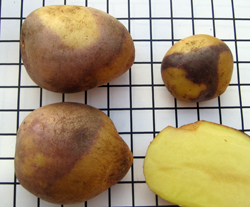 |
||||||||||||||||||||||
| The problem with andigena potatoes native to Peru is that they are late maturing. Renacimiento potatoes are popular in Peru but unlike tuberosum they need 60 days more growing time. It is not unusual for Renacimiento and Muru to take 193 days before harvest in Peru and almost 150 days here in the Seattle area.
MURU was in 2014 one of the latest varieties harvested in early November, and is grown in my Exotic Batch which is planted early with frost protection to extend the season as long as possible. 2014 season vine life length 168 days - in 2015 I'll try to plant sooner and further extend the growing season, which translates in larger tubers. The tubers in the picture are almost 3" long - certainly a good size for fresh market. Also of interest could be the variation in color contrast of the skin. Over the future years I may be able to select clones to replant which have a stronger bi-color contrast. The vines produce seed berries. The progeny may give different skin color patterns. Source: WA HO C 14 Local grower: Curzio What's the best use in the kitchen for this waxyy variety? We tasted this potato and found it creamy with very good nutty flavor. The skin is medium thin and sweet. |
||||||||||||||||||||||
| Myatt's Ashleaf, aka kidney potato
Medium - small oblong tubers with yellow skin and pale yellow flesh. Bred in England and released in 1804. W3 claims this to be an important breeding cultivar in pre-1845 England. Source: AgriCanada13 Local grower: Curzio Grown in two 14" bags in 2013 to compare Poppy Orange to black. The yield is small: 14 vs 9.5 oz,, with equal amount of tubers 34 vs 33, none above 2 oz in weight, but tubers grew a little larger in the Poppy Orange bag. |
||||||||||||||||||||||
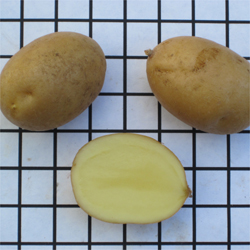 |
||||||||||||||||||||||
| What's the best use in the kitchen for this starchy variety? We tasted this potato and found it flaky but moist with good flavor and a slight bitter aftertaste. The skin is medium thin. | ||||||||||||||||||||||
| Nagore
Medium - small oblong tubers with red brown skin and pale yellow flesh. Bred in Spain as a cross of Desiree x Baraka and released in 1990. Compare this picture to Desiree and you will immediately see the similarity. Source: US Genebank12 Local grower: Curzio Grown in 2013 in an 18" tall bag in part shade, 3 tubers produced 32 oz, 36 tubers, of which 6 above 2 oz, 20 mini and 10 micro. Flagged to be compared to Desiree in 2014 - both with 4 mini tubers as starting seed in 14" Poppy Orange bags. Nagore grew pretty well in an 18" tall bag, while Desiree did not! So we need to compare them in a 14" bag. |
||||||||||||||||||||||
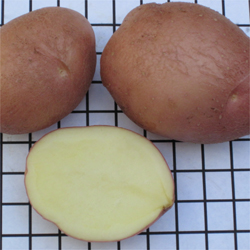 |
||||||||||||||||||||||
| What's the best use in the kitchen for this waxy potato? We tasted this potato and found it flaky but not too dry. The skin is medium thin. Seems to be a good choice for a multi purpose potato. | ||||||||||||||||||||||
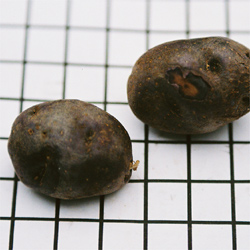 |
Négresse, aka Vitelotte Noire
Medium - large fingerling shaped tubers with dark purple skin and purple flesh. Imported from Peru to France in 1815. W3 explains that this cultivar is not the same species Solanum tuberosus, but Solanum ajanhuiri. Source: PA WE W08 - small seed tubers Local grower: MarciaC What's the best use in the kitchen? |
|||||||||||||||||||||
| This is a very special cultivar ... quite rare. We are looking for special recipes that were developed for this special variety. | ||||||||||||||||||||||
| Nice Red
Medium-small, oval to oblong, red skin with yellow flesh tubers. A creation of Tom Wagner with at this time unpublished parentage. A keeper because the vines produce berries at Kenosha latitude. Source: WASTD13 Local grower: Curzio Grown in 2013 in a 14" Poppy Orange bag, ONE tuber produced 15 oz, 29 tubers, none above 2 oz, 20 mini and 9 micro. Flagged to be tested with 3 starting mini tubers in 2014. We hope to increase the yield and verify consistency in seed berry production. |
||||||||||||||||||||||
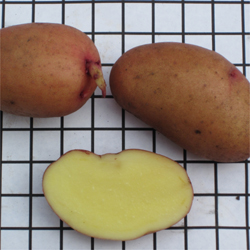 |
||||||||||||||||||||||
| What's the best use in the kitchen for this starchy potato? We tasted this potato and found it flaky but moist, with good taste. The skin is medium thin. | ||||||||||||||||||||||
| Nicola
Medium-large, long to oblong yellow fleshed tubers. A German cross of Clivia x wild potato, released in 1973, which cooks as a waxy potato with lower sugar content - the one variety recommended for use by diabetics for the lower insulin spike. GRIN: PI 607475 Source: CV Ron 10 Alt Source: CV Fe5 CV Ma23 CV Se16 Local grower: Curzio |
||||||||||||||||||||||
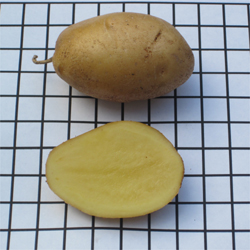 |
||||||||||||||||||||||
| What's the best use in the kitchen for this waxy potato?
It cooks firmly, like one would expect from a waxy potato, with a slightly nutty flavor and the skin keeps a pleasant texture. |
||||||||||||||||||||||
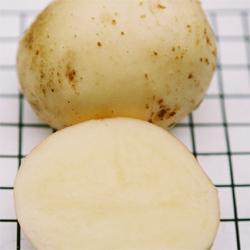 |
Niska
Medium size, oval to oblong tubers with white skin and flesh, developed by U of WI-Rhinelander for chipping. Good storability, but susceptible to growth cracks - perhaps needs to be planted closer to keep size smaller. A cross of Wischip x B5141-6 released in 1976. Source: ME BO W07 Local grower: Good for baking, boiling, chips. The waxy |
|||||||||||||||||||||
| texture of the flesh keeps the shape of diced potato when cooked in soups. I always eat my potatoes with the skin. This cultivar has tendency to develop a rough skin which adds character to my soups. | ||||||||||||||||||||||
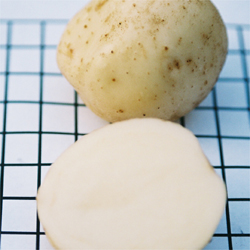 |
Norchip
Medium size, oval to oblong tubers, developed by Bob Johansen in Fargo, ND for chipping. Performs well on well drained heavy soils, but is very intolerant to drought. A cross of ND 4731-1 x M 5009-2 released in 1968. Tall Vines GRIN: AV 22 Source: ME BO W07 Local grower: Chipping, French frying, boiling, and baking. |
|||||||||||||||||||||
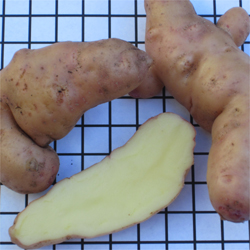 |
Norwegian - SSE 225
Medium-small fingerling shaped tuber with yellow / red skin and yellow flesh. The variety has an "American heirloom" name, NOT a true Norwegian variety. It growsTall Vines, may be a good choice for growing in containers. Source: SSE HF13 Local grower: Curzio Grown in 2013 in an 18" tall bag [just because this variety grows tall vines], turned out to be better than most fingerlings grown in a bag. 3 tubers produced 24.5 oz, 54 tubers, 3 standard, 40 mini and 11 micro. |
|||||||||||||||||||||
| What's the best use in the kitchen for this waxy potato? We tasted this potato and found it creamy, with mild flavor. The skin is medium thin. Likely an excellent choice for potato salads. | ||||||||||||||||||||||
| Nova Scotia Blue
Medium-small oval shaped tuber with purple skin and purple flesh. Interesting study by Dr. Fu at AgriCanada shows genetic dissimilarity to be identical with many blue varieties. Tall Vines Source: AgriCanada 09 Local grower: Even if many blue cultivar are similar genetically ... we like to compare how they differ once cooked ... stay tuned! |
||||||||||||||||||||||
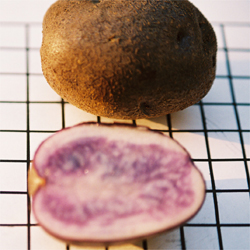 |
||||||||||||||||||||||
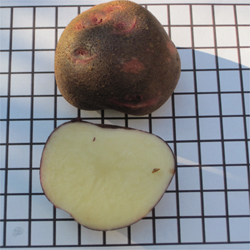 |
O'Higgins Blue
Medium-large, long tubers, dark purple skin, purple flesh, rare. Developed by Bill Higgins from Black Rocks TPS in 1985, Christmas Island, Nova Scotia, Canada. Source: AK WO K07 Local grower: A tuber that is blue-purple throughout may have striking use in the kitchen - we are looking for specific recipes. |
|||||||||||||||||||||
| Odenwaelder Blaue
A German Heritage variety - a seedling of Wilhelm, released in 1908. Round to oval tubers with blue skin and pale yellow flesh. Source: AN J11 Local grower: What's the best use in the kitchen for this multi-purpose, starchy variety? |
||||||||||||||||||||||
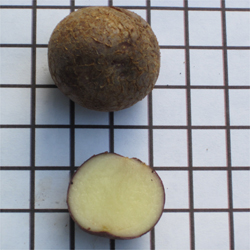 |
||||||||||||||||||||||
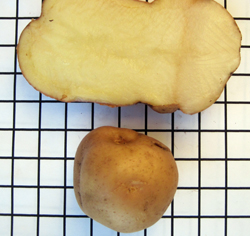 |
Okella Quehuil
Large - medium size, oblong tubers, grown as part of my Exotic Batch. Very long season. The vines developed seed berries in 2014 too tate to mature seed. Source: US Genebank 14 Local grower: Curzio What's the best use in the kitchen? |
|||||||||||||||||||||
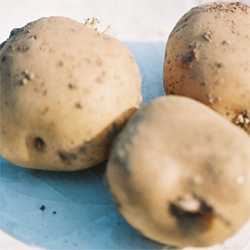 |
Oneida
Large - medium size, oblong tubers, developed in WI. A cross of Wis. 285 x Wis. 231 released in 1976. Develops true seed. Source: ME BO W07 - SSE 1147 Local grower: What's the best use in the kitchen? |
|||||||||||||||||||||
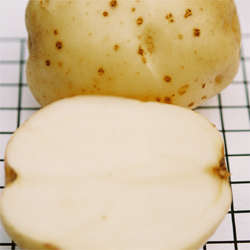 |
Ontario
Medium size, oblong tubers with a creamy buff smooth skin and white flesh, bred by USDA NY. A cross of Richter Jubel x USDA S44537 released in 1946. Develops true seed. GRIN: AV 25 Source: ME BO W07 Local grower: FredB What's the best use in the kitchen? |
|||||||||||||||||||||
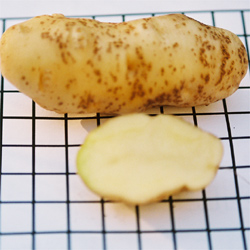 |
Ozette, aka Anna Cheeka's Ozette
Dating back more than 200 years to the late 1700s, two surviving potato varieties, the 'Haida' and the 'Ozette,' may have been carried here by the Voyages of Discovery. Crews from some of these vessels used spuds as a trade item and showed some of the native peoples along the coast how to grow them. Indians liked the potatoes well enough to keep them going, saving two varieties that are thought to be very old. First cultivated by Swedish colony then Makah Native American Tribe. |
|||||||||||||||||||||
| Like the Haidas, the Makahs at Neah Bay in Washington grew potatoes. Their variety is known as the 'Ozette,' or sometimes 'Anna Cheeka's Ozette.' The name derives from Lake Ozette (WA). It is a fingerling potato, somewhat oblong in shape. The tubers range in size from three to eight inches, and occasionally grow together, forming zigzag tubers. They have beige skin with faint pinkish highlights. The tubers are circled with moderately deep eyes that are evenly spaced, making the surface of the potato wavy. The skin is thin, and the flesh is creamy white and waxy. Anthropologist Steven J. Gill reports that it was "...formerly grown at Ozette and by almost everyone at Neah Bay and supplied to schooners by local residents." The Makah have been growing it for so long that some consider it a traditional food. [This historical description is provided by Kathy Mendelson, halcyon.com]
This link provides a very complete study of early potato history among native people. Slightly nutty, earthy flavor, nice steamed, fried or roasted. 100-120 days. Planting spacing of fingerling tubers: 6"- 8" better than 12-16" - I tested the spacing on two rows of about 20ft length with tubers placed in a furrow about 6-8" apart and one row with exactly half the quantity of seed (12-16" apart); at harvest I found in the double-spaced furrow a few tubers that grew 6" long for a total weight of 6 pounds, while in the furrow with double-seed I found more smaller tubers (5" max. lenght) for a total weight of 12.5 pounds - more than double. The tubers in the picture above were harvested in early September 2008 from a vine grown as a volunteer - a vine sprouted from a tuber missed from harvesting in 2007. GRIN: AV 26 Source: SSE06 Alt Source: CV Ron Local grower: Curzio - as I'm comparing Ozette, Haida, Makah and Indian Tlingit |
||||||||||||||||||||||
| Paarsput
Medium-small round to oval tubers with yellow skin with purple eyes and pale yellow flesh. An old time Dutch variety with unknown parentage, grown by a Canadian family since the late 1800. Interesting note: in 2013 I happen to harvest Irish Peace and Paarsput the same day, and they looked identical. Check out the online pictures. The picture of Irish Peace was taken the same day, while Paarsput's was taken 2 weeks after harvesting. Both varieties looked identical 2 weeks after harvesting, with skin that looked flaky, and the light purple eye faded. |
||||||||||||||||||||||
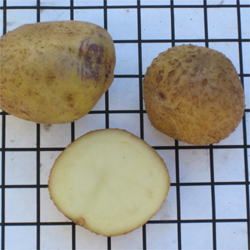 |
||||||||||||||||||||||
| Source: ONT LAS13 Local grower: Curzio
What's the best use in the kitchen for this variety? We tasted this potato and found it flaky and a little dry, with mild flavor. The skin is thin and tastes nutty, with a light bitter aftertaste. |
||||||||||||||||||||||
| Papa Amarga
Papa Amarga is Spanish for Bitter Potato - Latin American web pages report that Papa Amarga is NOT just a variety, it's a group of potato cultivars specifically grown at high altitude [resistant to light frost] for the production of "heladas" [frozen tubers] which are not eaten fresh but processed, either dehydrated by alternating freezing and drying [chuño negro] or frozen, washed and dried [moraya or tunta]. The dehydration process causes a loss of proteins but is reported to be an excellent source of calories which can be stored for many years. |
||||||||||||||||||||||
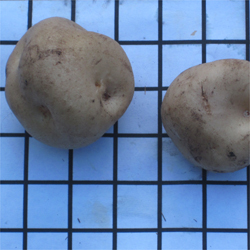 |
||||||||||||||||||||||
| This Papa Amarga is a clone donated from Uruguay to the US Genebank and may well have a different variety name. It features small-medium tubers with white skin and flesh - tubers form on very long stolons. Latin American web pages report that Papa Amarga varieties are not suggested for "coastal growth" [low altitude] and therefore I guess it would be hard to get a good yield at low altitudes. Perhaps we should try other varieties of this group, like the variety Shiri [aka Choquepito or Ocucuri] or Piñaza [grown in the South of Peru].
I would be interested to know if anyone in the US is processing tubers for "chuño negro" [dehydrated pulp], and how this product is digested, specifically if the pulp fibers are "slowly digested", perhaps releasing glucose slower to the blood stream, hence with a lower glycemic index Source: US Genebank 12 Local grower: Curzio Grown in 2013 in an 18" tall bag because I noticed that the vines develop very long stolons, but this was a big mistake! The vines senesced before forming any tubers at all. I need to try again with 14" bags. What's the best use in the kitchen for this potato? Perhaps chuño negro, moraya or tunta? |
||||||||||||||||||||||
| Papa Cacho
Long, red, horn-shaped tubers with pink flesh, donated from Peru 1998. Early to emerge but not early in tuber setting. GRIN: PI 611078 Source: MI B07 CV Ma23 Local grower: Curzio May be a waxing potato with thin skin - try to boil with skin for potato salad. |
||||||||||||||||||||||
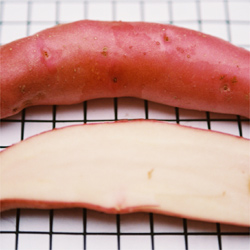 |
||||||||||||||||||||||
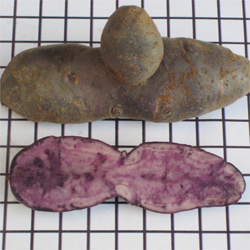 |
Papa Chonca (a perennial variety)
Medium-small fingerling shaped tubers, lavender skin purple flesh. Very late - if left to fully mature tubers may grow as 5" long. Great potential for the 99 pounds yield as I've noticed shallow tuber setting on extremely long stolons. It may be the ultimate perennial potato - small tubers left in the ground over-winter and spread over a large area [hint: like mint]. Very Tall Vines (late to dry off) |
|||||||||||||||||||||
| Small tubers may be found over the surface of the soil, but most tubers could be deep in the soil. Some may grow vertically, but some grow horizontally. The tuber in the picture grew horizontally with the central knob pointing up.
My perennial patch now spread to over 6 x 6 feet = 2011 yield 7.5 pounds in a variety of shapes and sizes [one to five inches long] with few micro tubers. GRIN: PI 607497 Source: ME BO W08 Local grower: Curzio The tubers cook starchy. I like to cut them horizontally and cook them in my breakfast soup for about 20 minutes [careful: the color bleeds and stains]. Interesting how some potato cuts warp and the center of the pieces dissolve into my soup, while the surface stays attached to the skin [almost seems waxy in texture] - eaten with the skins they have a very intense, pleasant taste. Smaller tubers may be cut in cylindrical pieces, or left whole. The center of the flesh keeps a very intense lavender blue color. |
||||||||||||||||||||||
| Papa Chonca (skin color variations)
We recommend harvesting on a sunny day to find all the tubers. If the soil is dry the tuber skin tubers very dark (difficult to find). This picture shows possible skin color variations. With the first tuber on the left being the typical dark color of the skin. The lighter tubers were only found in micro size. |
||||||||||||||||||||||
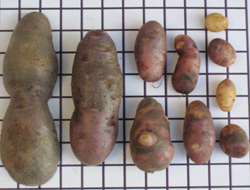 |
||||||||||||||||||||||
| I've kept these tubers separate to grow out next year and observe if lighter color sports can be consistantly grown. Also, it will be interesting to observe how micro tubers over-winter in storage.
Finally, in 2012 I'm planning to grow this variety in a tall SmartBag - I'm corresponding with the bag manufacturer to develop taller bags. Standard bags are 14" tall - it will be interesting to test this variety in 16" and/or 18" tall bags. Also, I would like to test the frost resistance by growing in it a bag which will NOT be harvested at the end of the season (October 2012)! What will the yield look like after the second season (October 2013)? The ultimate potato seed crowding? And a different method of winter storage? |
||||||||||||||||||||||
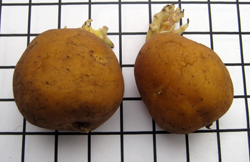 |
Papa Criolla # 5 - # 8 - # 9 and # 12
Papa Criolla is NOT a potato variety, but is the definition of a class of cultivars typically grown in Colombia and now researched as fresh tubers in the USA to prepare the traditional Colombian dish Ajiaco. People of Colombian heritage are looking for these fresh tubers to replicate the texture and flavor of their homeland. The problems to grow these tubers in the USA at higher latitude are the length of day and the shorter season. These tubers need 150 - 200 days to build up tuber size, and the vines are used to equal length of days vs nights in Colombia, while they suffer with our long summer days. With these challenges in mind the US Genebank is trying to develop varieties which eventually should produce decent crops under our Northern growing conditions. At the Kenosha Potato Project we are growing these cultivars as part of the Exotic Batch in organic compost and report back to the US Genebank our findings about tuber flavors' The skin colors range from dark yellow to red, with red yellow bi-color patterns. The flesh is a very dark yellow, almost orange. All 4 strains are the result of USDA work with S. phureja x S. stenotomum in the 90s in North Carolina. Source: US Genebank 13 and 14 Local grower: Curzio Grown in 2014 in 14" bags as part of the Exotic Batch the yield was quite low possibly because the vines were shaded by other Exotic varieties which grow very long vines. Also of interest to determine if Papa Criolla vines grow larger crops in a seed crowding environment. Flagged to be compared with 1 - 2 - 3 - 5 tubers per bag in 2015. |
|||||||||||||||||||||
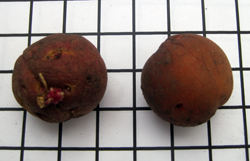 |
||||||||||||||||||||||
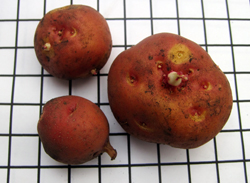 |
||||||||||||||||||||||
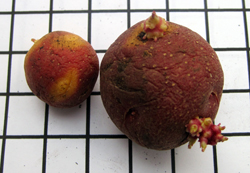 |
||||||||||||||||||||||
| The best use in the kitchen for these tubers are traditional Colombian dishes. | ||||||||||||||||||||||
| Parli
A Swiss heritage variety, possibly 200+ years old as it unknown if Parli is a sport of Yam or Wiesner, particularly appreciated in Switerzland for culinary use as a dry matter type of tuber. Parli is the last name of a farmer family in the Swiss Canton of Grisons. Source: PSR Local grower: What's the best use in the kitchen for this starchy potato that cooks with hints of chestnut flavor? |
||||||||||||||||||||||
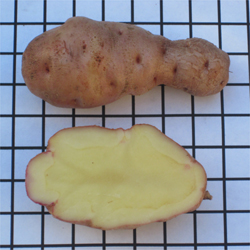 |
||||||||||||||||||||||
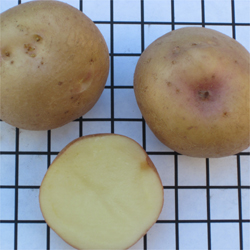 |
||||||||||||||||||||||
| Pastusa Suprema
Medium-small, round to oval yellow flesh tubers developed in Colombia for disease resistance. Notice the light purple color where the tuber was attached to the stolon. It is reported to be male sterile. Source: US Genebank 13 Local grower: Curzio It appears to be a variety which requires a longer growing season and may take a few years to adapt to the Kenosha latitude. |
||||||||||||||||||||||
| What's the best use in the kitchen for this starchy potato? We tasted this potato and found it flaky but not dry, with a sweet, nutty aftertaste. Definitely a keeper! The skin is medium thin. | ||||||||||||||||||||||
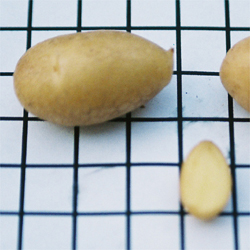 |
||||||||||||||||||||||
| Peanut (aka Swedish Peanut, Mandel)
Medium-small fingerling to oval and tear-drop shaped tuber with tan russeted skin and dense yellow flesh. Good storage is reported for this late season cultivar. Source: AgriCanada 09 Alt Source: CV Ron and CV Wo6 Local grower: Best use in the kitchen: Skandinavian Potato Salad. See Norwegian Potato Salad |
||||||||||||||||||||||
| Peerless
Medium-small round to oval tuber with yellow skin and pale yellow flesh, unknown history for this clone. Interesting to note that Peerless is a name used as a synonym of Arran Victory [which this clone is NOT], and is the name given to a seedling of Garnet Chili, that would make it a cousin of Early Rose found in 1862, but it is unlikely to be that 1862 clone [as this one has pale yellow flesh]. Source: LA D 12 Local grower: Curzio Grown in 2013 in an 18" tall bag, 3 tubers produced 45 oz, 140 tubers, of which 80 mini for 39 oz and 60 micro for 6 oz. While I was harvesting I noticed the very extensive root system, with very long stolons, and a constellation of tubers. Some tubers grew larger as a single spud at the end of a stolon, while other tubers as many as 6 were attached in a serial progression on longer stolons. This variety may be one of the best choices for growing in containers. It is flagged for testing next year in very high seed crowding! I'm planning to have two 18" bags to be compared, starting one with 5 mini and the other with 10 mini seed tubers. Peerless holds the record for the largest number of tubers in one bag! This record equals the record of Morada Ojuda, set in 2012 with 6 starting tubers, while Peerless reached 140 tubers starting with 3. It is expected that 2014 will bring new records; obviously we hope to increase the number of tubers in the mini size range [half to 2 oz] and not so much in the micro size. |
||||||||||||||||||||||
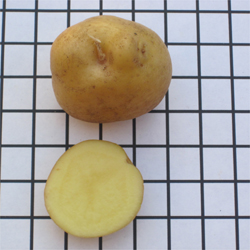 |
||||||||||||||||||||||
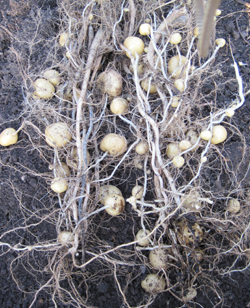 |
||||||||||||||||||||||
| What's the best use in the kitchen for this starchy variety? We tasted this potato and found it flaky but creamy at the same time, with a slightly bitter aftertaste. The skin is thin. Also considering the size of these tubers, we believe this would be a great choice for cooking whole in soups and stews, as well as pan roasting. | ||||||||||||||||||||||
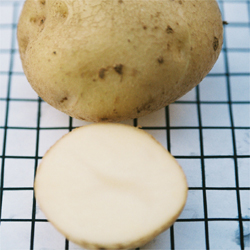 |
Penobscot
Medium - large size, round, white tubers with white flesh, bred by USDA ME. Penobscot is the name of a native tribe of eastern Maine. A cross of USDA X927-3 x Katahdin released in 1963. Develops true seed. GRIN: AV 43 Source: ME BO W07 Local grower: What's the best use in the kitchen? |
|||||||||||||||||||||
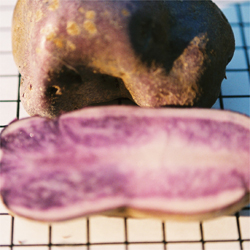 |
||||||||||||||||||||||
| Peruvian Blue
Medium-large oblong tubers, dark purple skin with cream, light purple flesh. Rare. Tall Vines Source: ME BO W08 Local grower: Best use in the kitchen: starchy |
||||||||||||||||||||||
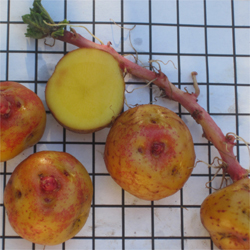 |
||||||||||||||||||||||
| PI 320370 - Papa Criolla
Small round tubers, dark yellow skin with red blotches and red eyes and sprouts, the flesh is dark yellow. A diploid landrace variety collected in Cauca, Colombia - S. phureja. In Colombia this type of potato is known as Papa Criolla for its intense yellow flesh color. Tom Wagner reports that at our latitude it is very difficult to store it. I have harvested at the end of August and found perfect tubers mixed with some with short sprouts [one was 4" long]. |
||||||||||||||||||||||
| Also Tom suggests that S. phureja should be crossed with S. stenotomum to obtain longer dormancy and better storage.
Source: WA ST D 13 Local grower: Curzio What is the best use in the kitchen for this starchy variety? We have tasted this potato and found it to be flaky, with intense flavor. The skin is thick with a bitter aftertaste. We have heard of a traditional soup - Ajiaco Colombiano? |
||||||||||||||||||||||
| PI 657146
Large round to blocky tubers donated to the US Genebank from CIP - Peru. We were not been able to find more info, except the CIP code 396286.7 and Pedigree - male [676008=(I-1039)] - female [TXY.3]. Source: RI PI N 14 Local grower: Curzio Grown in 2014 in a 14" bag, 4 starting tubers produced a stunning 77.5 oz, 27 tubers, of which 13 above 2 oz, 9 mini and 5 micro. |
||||||||||||||||||||||
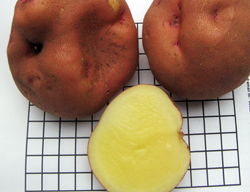 |
||||||||||||||||||||||
| This variety may be the choice for gardeners who are looking for larger tubers grown in containers. The 3 tubers in this catalog picture came in at 2 pounds. Highest weight for 3 tubers grown in one bag.
What's the best use in the kitchen for this starchy variety? We tasted this potato and found it flaky and fluffy. The skin is medium thin, slightly russetted. Perhaps a good choice for mash potato. |
||||||||||||||||||||||
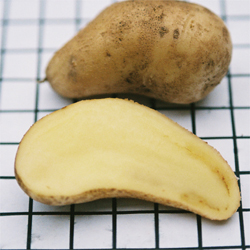 |
Piekon Muikku (Puikoloita)
Small teardrop-shaped tubers, yellow skin yellow flesh. Originating from Finland - a strain of Swedish Peanut. Source: ME BO W08 Local grower: What's the best use in the kitchen for this waxy variety? |
|||||||||||||||||||||
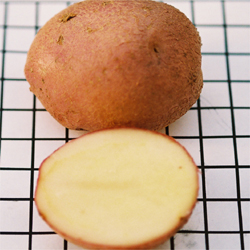 |
Pimpernel
Medium-large oval to oblong tubers, blotchy red skin and yellow flesh. Originating from Holland, released in 1953 by breeder Mulder as a cross of Populair x [Bravo x Alpha]. Sets true seed pods. GRIN: PI 238085 Source: AK WO K 13 Local grower: Curzio Interesting experiment in 2013 I tried 3 tubers each in 2 14" black bags - one full sun and one part shade. The part shade bag grew vines for over a month longer, and the yield was higher. Not very productive, perhaps diseased, |
|||||||||||||||||||||
| What's the best use in the kitchen for this starchy - multi-purpose variety? We tasted this potato and found it flaky but moist, with good flavor. The skin is thin. | ||||||||||||||||||||||
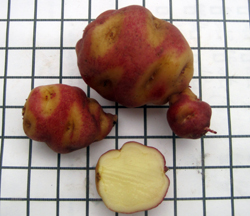 |
Pirampo
Medium-small round, Peruvian landrace belonging to S. tuberosum subsp. andigenum. This variety is the male parent of the Khuchi Akita's female progeny for Tom Wagner's Poor Dog. The vines don't grow as tall as other vines in our Exotic batch. PI 619144 CIP 701633 Source: US Genebank 14 Local grower: Curzio |
|||||||||||||||||||||
| What's the best use in the kitchen for this waxy variety? We have tasted this potato and found it creamy and nutty aftertaste. The skin is very thin. | ||||||||||||||||||||||
| Poor Dog
Medium-large fingerling shaped tubers with tan/purple skin and cream fleshed [purple stripes in the flesh possible]. A Tom Wagner breed of (Khuchi Akita x Pirampo) x Skagit Valley Gold - all diploid varieties, where Khuchi Akita is a Bolivian landrace and Pirampo is a Peruvian landrace, Skagit Valley Gold also is a Tom Wagner creation of 2002. This is a posting by Tom Wagner on Kenosha Potato Facebook Group: Poordog is from a three way cross, actually four if you count the final outcrossing . |
||||||||||||||||||||||
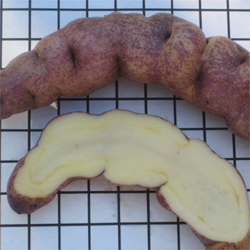 |
||||||||||||||||||||||
| I started with Khuchi Akita (PI 607472) Solanum tuberosum subspecies andigenum which four years ago was in the nomenclature as Solanum stenotomum. This pollen domor was crossed to another (stenotomum) also from Bolivia called Pirampo, PI 619144. I named one of the seedling tuber progenies Pokhip. The name was a combination of the parents and reflected the direction of the cross...PirampO x KHuchI and added a P on the end. I pronounced it po-KEEP. I pollinated Pokhip with pollen from another diploid of a complicated pedigree called Skagit Valley Gold. A selection from this cross was named Pokhipsie-----the s standing for the male parent SVG . The sie ending was also used in an oblique reverence to Rebsie Fairholm who used some of my stenotomum so well and were featured in her book----The Lost Art of Potato Breeding. An outcrossed seedling from Pokhipsie was the source of the clone Poordog. I pronounced it originally as Po Dog keeping the Po of Pokhipsie and adding the dog since the potato tuber looked like something the dog left behind the couch; hence the humor and scolding the dog was going to get! I mentioned the name during a presentation I game at Project Grow and allowed the organizers to show a tuber in the month long museum like art show on my potato work. This show was organized in Portland, OR mostly by my good friend and cooperator to this day: Tim Donovan. I have a few full siblings of Poordog growing frim TPS this Spring. One seedling is up in Whatcom County, WA among 100 other different pedigree seedlings. I am slotted to train a number of local interns there how to make crosses with those in early July. I hope to have photoessays eventually. My hope is that the interns will cross to their heart's content in my absence. [end of Tom Wagner's post] Source: WA ST D 13 Local grower: Curzio Grown in 2013 in an 18" tall bag, 3 seed pieces produced 17.5 oz, 11 tubers, 6 standard, 3 mini and only 2 micro. The vines grew very tall and produced a seed berry. Flagged to test with 4 seeds in 2014. What's the best use in the kitchen for this waxy variety? We tasted this potato and found it excellent, with firm waxy and creamy texture, leaving a very light bitter aftertaste. The skin is thin. We believe this variety should be cooked with the skin which keeps the stunning color after cooking. The smaller pieces should be cooked whole, while the longer tubers should be cut in bite size pieces to make wonderful soups, but also great pan fryed or roasted. |
||||||||||||||||||||||
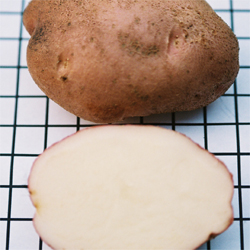 |
||||||||||||||||||||||
| Poorlander
Medium-small round-oval tubers, red skin and creamy flesh. A pre-1900 red skinned baking potato. Source: ME BO W09 Local grower: What's the best use in the kitchen? Reported to be starchy. |
||||||||||||||||||||||
| Purple Home Guard
Medium round to oblong tubers, with attractive purple/tan skin and yellow flesh. Rare. A sport of Home Guard, which is a white tuber, cross of Doon Pearl x Cumnock, bred by McGill and Smith Ltd., in Ayr, scotland and released in 1942. It is not known when this purple colored sport was found. Source: LA D 12 Local grower: Curzio Grown in a 14" Poppy Orange bag in 2013 it produced 28 oz, 29 tubers, of which 3 standard, 22 mini and just 4 micro. Planning a 2014 start in a hoophouse to test an earlier crop and also seed crowding of 3 vs 5 mini seed tubers. |
||||||||||||||||||||||
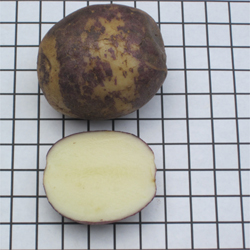 |
||||||||||||||||||||||
| What's the best use in the kitchen for this starchy tuber? We tasted this potato and noticed how thick the skins are! It's a starchy, mealy type of potato that should make great bakers; I bet the skins would crisp nicely. And grown traditionally, not in growing bags like I do, the tubers may turn out larger, more oblong. | ||||||||||||||||||||||
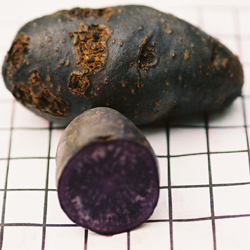 |
||||||||||||||||||||||
| Purple Peruvian aka Peru Purple Finger
Short-long, fingerling type tubers with dark purple skin and flesh. Source: MA C08 Alt Source: CV Ron CV Ma23 Local grower: Best use in the kitchen: Great for Potato Salads - Multi color potato salads? |
||||||||||||||||||||||
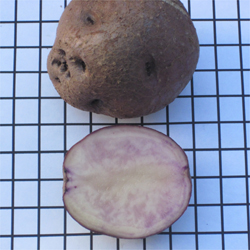 |
Purple Rose
Medium-large round to oblong tubers, with purple/white skin and dark purple flesh. Rare. Was not able to find any history. Source: ME BO W10 Local grower: What's the best use in the kitchen for this starchy tuber? |
|||||||||||||||||||||
| Purple Viking
Medium-large oblong tubers, with dark purple skin and cream with purple striped flesh. Commercially available from CV Se16 - shown in the catalog with snow white flesh - an other mistery of why this strain produces colored flesh in my garden?. Source: OR DR A11 Alt source: CV Ma23 Local grower: Curzio What's the best use in the kitchen for this multi-purpose starchy tuber? |
||||||||||||||||||||||
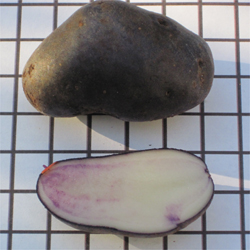 |
||||||||||||||||||||||
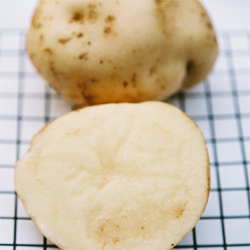 |
Quarantina Bianca
Medium-Large, round-oval tubers with white flesh. Grown in the Italian region of Liguria in 1880. Tall Vines Source: PSR Local grower: Curzio Best use in the kitchen: Gnocchi with only 25% flour addition |
|||||||||||||||||||||
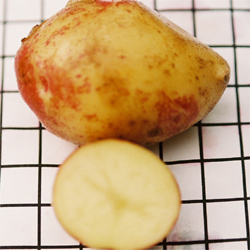 |
Rambling Rose
Medium-small, round tubers with pink eyes and pink blotches on the skin, and white flesh. I've collected a few tubers from Chris Malek who told me this strain is infected - I want to grow it in my garden and see how biodynamic soil may help the crop heal itself from the virus. Very Tall Vines Source: MA C08 Local grower: Curzio |
|||||||||||||||||||||
| What's the best use in the kitchen for these small, starchy tubers? We tasted this potato and found it starchy and creamy with a slight hint of bitterness. The skin is medium thin. | ||||||||||||||||||||||
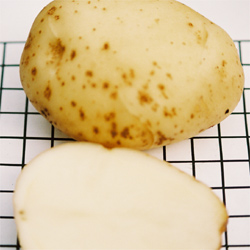 |
Ranger Russet, aka Amisk
Medium - large size, slightly flattened, oblong, russeted tubers, bred by USDA WA. Similar to Russet Burbank. A cross of Butte x A6595-3 released in 1990-91. This is the 3rd most popular potato in USA - reported to have yielded 9.4% of the total crop for Fall harvest in 2012, or almost 4 billion pounds. See Potato Production in USA |
|||||||||||||||||||||
| GRIN: AV 53
What's the best use in the kitchen? The standard for French Fryes |
||||||||||||||||||||||
| Rattviks Rod
A Skandinavian heritage variety with brown red skin and yellow flesh. Grows in bunches of small tubers. This picture also shows a micro tuber grown on top of a stolon which I found way above soil surface. Source: ME BO W09 Local grower: What's the best use in the kitchen for this very waxy potato? May be one of the best choices as the side dish to boiled fish. |
||||||||||||||||||||||
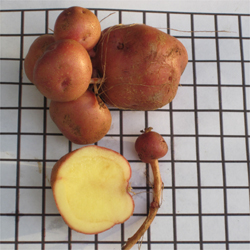 |
||||||||||||||||||||||
| Raud Kvaefjord, also spelled Rød K.
Small, round tubers with red - purple streaked skin and pale yellow flesh, from the Norvegian coast districts. Rød is red in Norvegian, but since the ø character is often missing on standard keyboards, the ø is replaced by the vowel combination "au" which explains the different spellings. Source: AA E 09 Local grower: Curzio An other Skandinavian potato - we are looking for specific recipes for use of this tuber - probably great with fish. |
||||||||||||||||||||||
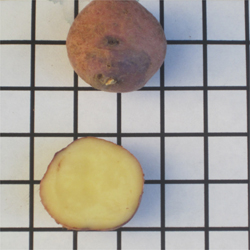 |
||||||||||||||||||||||
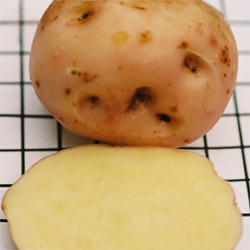 |
Raudar Islenskar (aka Red Icelandic)
Small, round, pink tubers, yellow flesh, from Iceland. A 1760 variety - perhaps a Skandinavian sport of Yam? Source: MI HA K07 Local grower: Curzio What's the best use in the kitchen for this starchy variety? We tasted this potato and found it starchy, flaky, with a hint of bitterness. The skin is thin. Perhaps great for use in a fish recipe with parsley. |
|||||||||||||||||||||
| Red Acadian
Acadia, or Acadie is the French word for the territory of Canada. A Canadian variety [donated to AgriCanada with unknown parentage] which features a red skin with pale yellow flesh. Source: AgriCanada 12 Local grower: What's the best use in the kitchen for this waxy potato? We have tasted this tuber and found it to be very buttery and tasty. It has a nice texture and absorbs the broth well. Must work great in soups. |
||||||||||||||||||||||
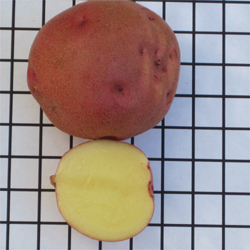 |
||||||||||||||||||||||
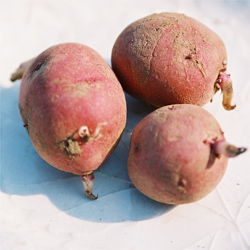 |
Red Beauty
Very large size, round tubers, bred by WI and ND. A cross of Cayuga x ND-1 released in 1955. Source: ME BO W07 Local grower: What's the best use in the kitchen? |
|||||||||||||||||||||
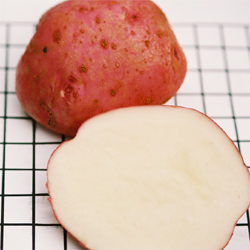 |
Red Cloud
Late-season. Round tubers with red skin and medium-dry, snow-white flesh. Excellent storage. High resistance to scab, early blight, hollow heart, heat stress and drought. Medium-sized spreading plants. Bred by U of Nebraska/Scotts Bluff 1992 and named after Oglala Sioux chief. Source: VT BI J07 - CV Fe5 Alt Source: CV Ron and CV Wo6 Local grower: What's the best use in the kitchen for this very dry flesh tuber? |
|||||||||||||||||||||
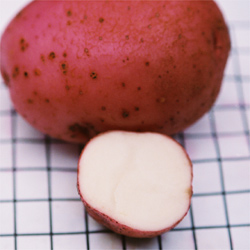 |
||||||||||||||||||||||
| Reddale, Red Dale
Large, round to square, flattened tubers with red skin and moist white flesh. Can get very large and may do better if crowded. Noticed some growth cracks, but not on larger tubers. Across of Erik x Chieftain released in 1984 as high yielding with excellent resistance to Vert. wilt, but dropped for commercial growth as it shatters in storage (a problem for storage in huge quantities - not an issue for gardeners). Has tendency to grow long stolons away from the vine above soil surface - perhaps this could be the perfect variety for growing potato in a barrel with dry leaves as shading mulch. |
||||||||||||||||||||||
| Good storage.
Source: MA C07 - Local grower: Alt Source: CV Ron and CV Wo6 |
||||||||||||||||||||||
| What's the best use in the kitchen? | ||||||||||||||||||||||
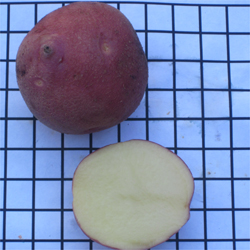 |
Red Dutch
Medium-large round to oval shaped tubers with red skin and pale yellow flesh. Another variety without history - heirloom variety in Canada, some Canadian gardener may offer some history? Source: AgriCanada12 Local grower: We tasted this potato and found it creamy and sweet. What's the best use in the kitchen for this starchy potato? |
|||||||||||||||||||||
| Red Gold
Medium round oval shaped tubers with red skin and yellow flesh, allegedly the first red skin/yellow flesh variety dev. by AgCanada, released in 1987 as a cross of G68211 x G6521-4RY. Good Heat Tolerance Source: CV Fe5 10 Alt Source: CV Ron CV Ma23 CV Wo6 Local grower: Curzio Grown in a 14" Poppy Orange bag in 2011 - 6 vines yielded 64 oz of tubers, 15 in regular size [48oz], 16 mini tubers [15oz] and just 10 micro [1oz]. The total weight of standard and mini tubers suggests tuberization at higher temps .. as the soil in growing bags is much warmer than for traditional field plantings. |
||||||||||||||||||||||
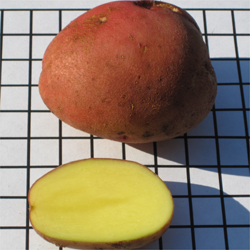 |
||||||||||||||||||||||
| As I noticed the vines set tubers high, in 2013 I tested 3 seed pieces in an 18" tall bag which proved to be a mistake for this variety. I'm planning to test seed crowding in 14" bags in 2014 to compare 4 vs 6 seed pieces. The 64 oz 2011 record [4 pounds] was my personal record for a 14" bag.
What's the best use in the kitchen for this likely waxy potato? We tasted this potato and found it waxy but a little dry, mild in flavor. The skin is medium thin with a slightly bitter aftertaste. Probably a good choice for soups or potato salad. |
||||||||||||||||||||||
| Red Island (aka AC Red Island)
Medium-large round to oval tubers, with bright red skin and yellow flesh. Bred by K.G. Proudfoot from the cross Brigus x Redsen and selected in 1987. Source: AgriCanada 11 Local grower: What's the best use in the kitchen for this starchy tuber? |
||||||||||||||||||||||
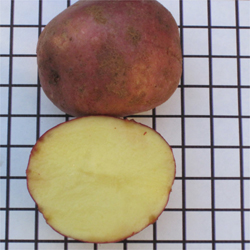 |
||||||||||||||||||||||
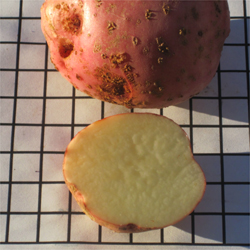 |
||||||||||||||||||||||
| Red Kote
Medium-large round oval shaped tubers with red skin and pale yellow flesh. Rare variety parent of Norland. Source: ME BO W 09 Local grower: What's the best use in the kitchen for this waxy potato? |
||||||||||||||||||||||
| Red Maria (aka NY129)
Medium-large round to oval tubers, with bright red skin and cream flesh. Commercially available from CV Fe5. Bred by Walter DeJong and Robert Plaisted in Ithaca, NY, originally knows as NY129 - selected for the bright skin color and the uniform round shape. Source: CV Fe5 11 Alt source: CV Ma23 Local grower: What's the best use in the kitchen for this waxy tuber? |
||||||||||||||||||||||
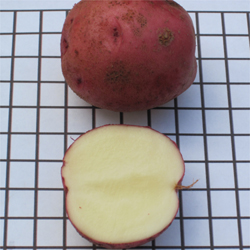 |
||||||||||||||||||||||
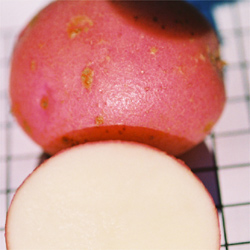 |
Red Norland, Dark Red Norland
Large, round tubers with red skin and white flesh. Early maturity. A 1964 clonal selection of Norland, which is a cross of ND 626 x Red Kote dev. by Bob Johansen and released in 1957. Source: MA C07 Alt Source: CV Ron CV Ma23 Local grower: What's the best use in the kitchen? |
|||||||||||||||||||||
| Red Ox
Large,blocky to oblong tuber with vivid red skin and flesh. An other wonderful creation of potato breeder Tom Wagner as a cross of Negro y Azul and Blue Ox, where the latter one is the male parent and it was a cross between a red skin/white flesh line, thus the red from the grandparent is showing in the Red Ox flesh. It grows TALL VINES and produced seed berries at Kenosha latitude. Tuber set both high and serial, great for growing in containers. Plus it carries seed berries. |
||||||||||||||||||||||
 |
||||||||||||||||||||||
| Source: WASTD13 Local grower: Curzio
Grown in 2013 in a 14" Poppy Orange bag, ONE tuber produced a record setting 57 oz [highest yield with ONE seed piece in a bag], 28 tubers, 11 large [several in the 4 to 7.5 oz range], 14 mini and only 3 micro. |
||||||||||||||||||||||
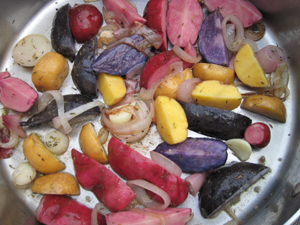 |
Red Ox is flagged for testing in 2014 in both 14" and 18" tall bags with 3 vs 2 mini tubers as starting seed in an attempt to increase the total yield, both in total crop weight and tuber number.
What's the best use in the kitchen for this starchy variety? We tasted this potato and found it flaky but moist, with good flavor. The skin is medium thin and tasty. |
|||||||||||||||||||||
| We have used this rainbow of potato colors to prepare a bed of vegetables for a Rainbow Trout. This picture shows 3 different colored flesh varieties: Blue Tomcat, Skagit Valley Gold and Red Ox. | ||||||||||||||||||||||
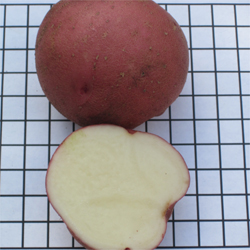 |
Red Pontiac, aka Dakota Chief
Medium size, round to oblong tubers with white flesh, widely adapted (especially to muck soils). Pontiac (aka Red Bliss) was bred from a cross between Triumph and Katahdin and was originally released in the USA in 1938 and to Australia in 1940. Red Pontiac, a selection with a brighter skin colour, was released in the USA in 1949. Very Tall Vines GRIN: AV27 Source: ME BO W07 Alt Source: CV Ron CV Ma23 CV Fe5 Local grower: Curzio |
|||||||||||||||||||||
| Grown in 2013 in a 14" Poppy Orange bag 3 seed tubers produced 70 oz, 38 tubers, including a record amount of 16 standard tubers, ranging in 2-5 oz, 8 mini and 14 micro. The vines were extremely tall and in 2014 I shall compare the growth in an 18" bag.
What's the best use in the kitchen for this starchy potato? We tasted this potato and found it mild, with good flavor. Probably a great choice for hand-cut fries or hash. |
||||||||||||||||||||||
| Red Thumb
Medium-small fingerling shaped tubers with red skin and pale red flesh. Not rare anymore as it is offered by Ronniger. Within 2 years the flesh has lost it's red stripes and is now creamy. Source: CV Ron 10 Alt Source: CV Fe5 CV Ma23 Local grower: Curzio |
||||||||||||||||||||||
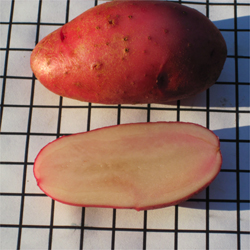 |
||||||||||||||||||||||
| What's the best use in the kitchen for this waxy potato? We tasted this potato as part of an event with 2 Chefs who compared 11 different varieties with red flesh. Red Thumb was rated the worst, with poor color retention after cooking and bland flavor. | ||||||||||||||||||||||
| Red Warba
Medium-small size, round tubers with white flesh and attractive mostly red skin color. A Clonal Selection from Warba released in MN in 1939 (while Warba is a cross of Triumph x MN4-16). Develops true seed. GRIN: AV 28 Source: ME BO W07 - SSE 1143 Local grower: Curzio Grown in a 14" Poppy Orange bag in 2013 it yielded an early crop of 33 oz, 29 tubers, of which 5 standard, 16 mini and 8 micro. It isn't a great potato ... but I'm planning on growing it in a hoophouse in 2014 to test how early it can be harvested. |
||||||||||||||||||||||
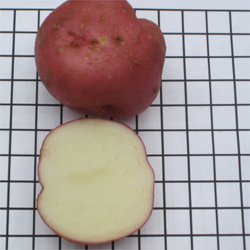 |
||||||||||||||||||||||
| Best use in the kitchen: Try to dice and pan cook to make Home Style Crunchy Fries.
We tasted this potato and found it to be starchy [unexpected for a red tuber], the flesh melts in your mouth like butter. The skin is thin. May work great to make gnocchi or hashbrowns. Not a good choice as a roasted potato as it falls apart. |
||||||||||||||||||||||
| Redder Blood TPS 13
Medium-small round tubers originally grown in 2013 from Tom Wagner's supplied botanical seed. The parent seedling is possibly open pollinated from Blue Blood Russet - this clone to be eventually renamed. Source: MO R Local grower: Curzio |
||||||||||||||||||||||
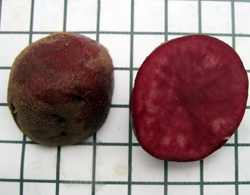 |
||||||||||||||||||||||
| What's the best use in the kitchen for this starchy potato? We tasted this potato and found it flaky, but not too dry. The flesh color keeps a very dark hue after cooking, especially if fried. The skin is thin and has a bitter aftertaste. | ||||||||||||||||||||||
| Rewai
Medium-large oblong shaped tubers with brown, purple striped skin and pale yellow flesh with a tiny purple ring below the skin. Rare variety - was not able to find any history, except that rewai is the Maori (New Zealand) word for potato. 2011 Mid Sept. harvest - 6 vines grown this year in a Red SmartBag yielded 45 oz of tubers - 20 Med-Small, 24 Mini and only 11 Micro tubers. The very small number of Micro vs. regular sized tubers points to the Great Heat Tolerance of this variety. |
||||||||||||||||||||||
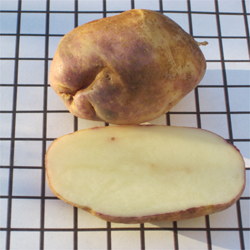 |
||||||||||||||||||||||
| Source: ME BO W 09 Local grower: Curzio
What's the best use in the kitchen for this waxy potato? |
||||||||||||||||||||||
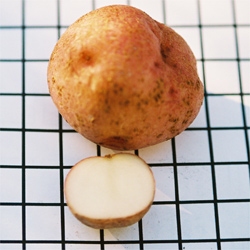 |
||||||||||||||||||||||
| Rhine Red
Medium-large round tubers, white flesh, tall plants with good yield, that need to be planted close to keep the size of the tubers smaller. Original source is Rhineland, WI, released in 1981 (Norchief x W639). May be virus infected, as the vines did not develop in Mike's garden - I'll try them in mine next year. Source: MI B07 Local grower: May be a waxy potato with thin skin - try to boil and mash. |
||||||||||||||||||||||
| Richter's Jubel
These small tubers were grown from an in-vitro vine donated by AgriCanada - we must wait next year crop to review tuber shape and size. Canadian seed saver add the grower's name to the variety. Jubel is a German variety released in 1908. Source: AgriCanada 09 Local grower: What's the best use in the kitchen for this starchy - multi purpose variety? |
||||||||||||||||||||||
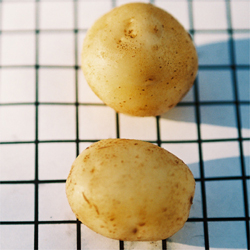 |
||||||||||||||||||||||
| Rideau
Variety donated by AgriCanada. Round shape with stunnig red-orange skin and creamy flesh. A cross of Viking x P177-13R released in 1979. Source: AgriCanada 09 Local grower: What's the best use in the kitchen? seems to be a multi-purpose variety with flesh that cooks starchy. |
||||||||||||||||||||||
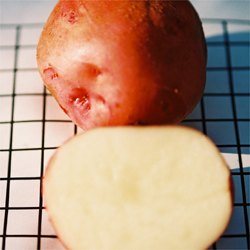 |
||||||||||||||||||||||
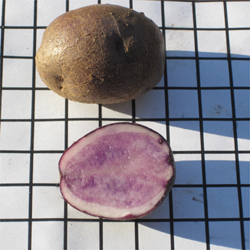 |
||||||||||||||||||||||
| River John Blue
These small tubers were grown from an in-vitro vine donated by AgriCanada - we must wait next year crop to review tuber shape and size. The skin may be thicker than in other blue varieties. Source: AgriCanada 09 Local grower: What's the best use in the kitchen for this blue fleshed variety? We have many blues in our collection and shall be able to compare cooking results. |
||||||||||||||||||||||
| Riverwood (aka PI 607501)
Medium-large round tubers, white flesh, huge yields claims Bill Minkey, planted in May07 and plant still green in late October, great storage. Sets true seed pods. GRIN: PI 607501 Source: MI B07 Local grower: May be a starchy potato with thin skin - try to bake. |
||||||||||||||||||||||
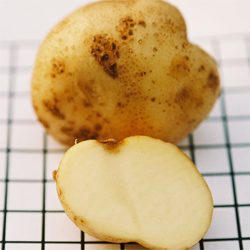 |
||||||||||||||||||||||
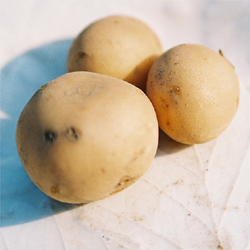 |
Robinta
Medium-large size, round tubers with pink skin (?) and white flesh, good storage. Will lists this variety from Bill Campbell, AK. Develops true seed. A cross of Rubinia x VE 70-9 released in Holland in 1992. Source: ME BO W07 Local grower: What's the best use in the kitchen? |
|||||||||||||||||||||
| Rödbrokig Svensk
Small-medium size, round tubers with pink marbled skin and creamy colored flesh. Originates from Sweden where it is still grown mainly at Småland in southern Sweden. Very small yield in Kenosha, while MikeC SSE member who lives further North, with shorter nights, reports true seed pods and more vigorous vines. In 2011 grown in a SmartBag - found tubers above the soil surface, which may be a sign for greater yield in vertical growth. Great if you like to grow many small tubers. |
||||||||||||||||||||||
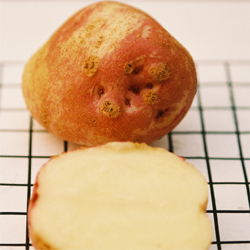 |
||||||||||||||||||||||
| GRIN: PI 527881 Source: IA FE S08 Local grower: Curzio
It's a starchy potato that tipically grows in round, small size - what's the best use for this potato? |
||||||||||||||||||||||
| Roko Red
Medium - large oblond tubers - a variety from the collection of Bill Higgins, Christmas Island, Nova Scotia. Reported to yield good crops. Source: HI B11 Local grower: What's the best use in the kitchen for this waxy potato? We tasted this tuber and found the taste creamy with a very light bitter aftertaste. The skin is medium - thin. |
||||||||||||||||||||||
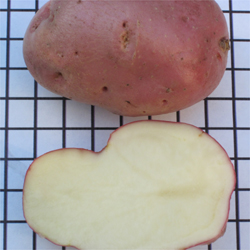 |
||||||||||||||||||||||
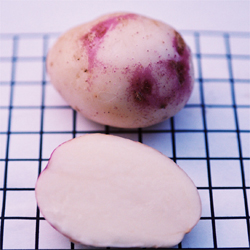 |
Rosa (a sport of Early Rose)
Medium-large oval to oblong tubers, blotchy pink skin to mark the eyes and white flesh. Believed to be a synonym of Early Rose, a seedling plant from Garnet Chili released in 1861. The Rosa vines were done in early July - likely to be virus infected. Source: ME BO W08 Local grower: Curzio What's the best use in the kitchen? |
|||||||||||||||||||||
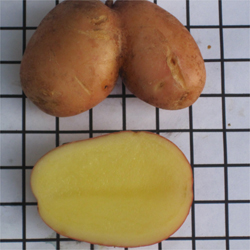 |
Rosa Ungarische
Medium-small round to oval, flat tubers with red skin and yellow flesh. Austro-Hungarian origin. Source: ME BO W09 Local grower: Curzio What's the best use in the kitchen for this waxy tuber? We tasted this potato and found it waxy and sweet. The skin is medium thin. |
|||||||||||||||||||||
| Rose Fir Apple, aka Rosa Tannenzapfen
Small-medium size, fingerling type tubers with pink skin and light yellow flesh. As the original name is German - Rosa is the color pink, Tannenzapfen is Fir cone (in Southern German dialect Tannenapfel which still means Fir cone, but sloppy translation made it apple). This 2012 picture clearly shows how the name suggests similarity to a pine cone. Source: Fedco 10 Local grower: Curzio Alt Source: CV Ma23 - CV Fe5 - CV Se16 CV Wo6 |
||||||||||||||||||||||
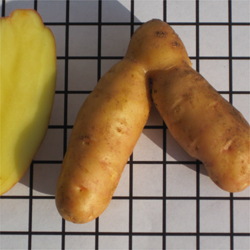 |
||||||||||||||||||||||
| Grown in 2013 in a an 18" tall bag, 3 tubers only produced 16.5 oz, 15 tubers, 7 standard and 7 mini. The variety is flagged to be grown in a 14" Poppy Orange bag in 2014. Fingerling shaped tubers don't grow well in taller bags.
Best use in the kitchen: Great for Potato Salads. See Austrian Potato Salad (Vegan) |
||||||||||||||||||||||
| Rose Gold
Medium-large round to oval tubers, rose skin and gold flesh. A cross of Abenaki and G6521-4RY [male parent of Red Gold], released in Ontario in 1970. Source: CV Ma23 CV Wo6 12 Local grower: Curzio Like Red Gold, Rose Gold does NOT work well in taller bags. Flagged for growing in 14" Poppy Orange bag in 2014. See Red Gold comments for seed crowding comparison. |
||||||||||||||||||||||
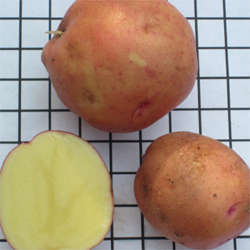 |
||||||||||||||||||||||
| What is the best use in the kitchen for this waxy tuber? We tasted this potato and found it Creamy with a pronounced flavor and a nutty aftertaste. It features a slightly bitter thin skin. Probably a great choice for potato salads. | ||||||||||||||||||||||
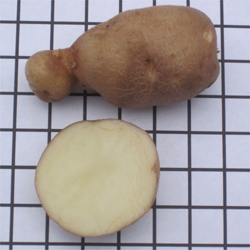 |
||||||||||||||||||||||
| Roslin Eburu
Small-medium round to oblong tubers, white skin and flesh. The name sounds exotic but this variety is all but exotic. A 1960 Scottish cross of un-named seedlings, but 7 steps back the pedigree shows Early Rose and Up-to-Date. It shows up in studies for aphid disease resistance. Source: US Genebank 12 Local grower: Curzio |
||||||||||||||||||||||
| What is the best use in the kitchen for this waxy tuber? We tasted this potato and found it waxy, slightly bitter. It features a very tasty, medium thick skin, that reminds us of a baked potato, while we cooked it in a soup. Perhaps a great choice for soups or stews if you wish the potato to keep its shape, rather than dissolve in the soup. | ||||||||||||||||||||||
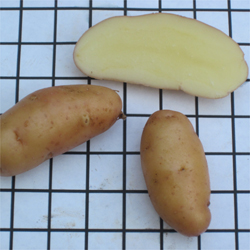 |
Rote Kipfler, aka Rote Kifler
Small-medium fingerling tubers, with dark yellow tending to pink skin and yellow flesh. The name is German and suggests red skinned croissant shaped. SSE has the name misspelled, and a google search in German web pages proves the misspelling without a doubt! This potato is an Austrian landrace. Source: SSE 13 Local grower: Curzio Grown in 2013 in a 14" Orange Poppy bag it produced 14 oz, 54 small tubers, 42 mini and 12 micro. Fingerlings are NOT the best choice for growing in bags, and definitely NOT in taller bags. |
|||||||||||||||||||||
| For 2014 I'm planning to test 4 vs 6 mini as starting seed to test for the benefit of seed crowding.
What is the best use in the kitchen for this waxy tuber? We have tasted this potato and found it very creamy and tasty. It features a thin skin with a bitter aftertaste. Definitely a great choice for potato salads. If grown in a crowded row or in containers the tubers will not grow larger than 1 oz each, which is perfect for cooking whole [not cut], and to maintain the natural flesh moisture in a bite size tuber. |
||||||||||||||||||||||
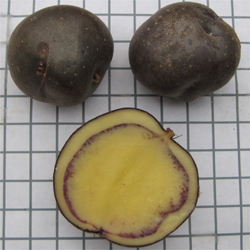 |
Round Blue Andean
Medium-large round tubers, purple skin and yellow flesh with a purple ring under the skin. Sets true seed pods. Source: SSE HF 14 Local grower: Curzio Grown in 2014 in an 18" tall Tan bag, 4 starting tubers produced 43 oz, 42 tubers, of which 6 standard, 29 mini and 7 micro. The yield is certainly over my average BUT the most impressive record is the number of seed berries developed on the vines ... over 70, therefore I'm confident I will have botanical seed for many years to come. |
|||||||||||||||||||||
| What is the best use in the kitchen starchy tuber? We tasted this potato and found it flaky and very dry. It features a medium thick skin BUT the tubers are not likely to grow as large as one would hope for a good bake potato. We believe this potato would make great roasted pieces. Roasting the potato with the skins, cut in quarters may also show off the circular purple ring and keep the dark yellow flesh. Avoid boiling to keep stronger colors. | ||||||||||||||||||||||
| Royal Gold (aka OAC Royal Gold)
Medium-large oval to oblong tubers, purple skin and pale yellow flesh - a Canadian variety cross of Caribe and Rose Gold. OAC is an acronym for Ontario Agriculture Canada. Good storage. Grown in 2014 in the potato hoophouse to test if an early planting would produce a higher yield. 5 tubers planted in a 14" black bag produced a record 103 oz, 31 tubers, 21 of them mostly larger than 3 oz, 9 mini and just one micro. Planning to test 2 bags in 2015 to compare starting with 5 tubers vs. 6. |
||||||||||||||||||||||
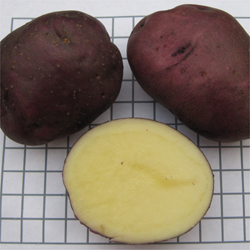 |
||||||||||||||||||||||
| Source: AgriCanada11 Local grower: Curzio
What is the best use in the kitchen starchy tuber? We tasted this potato and found it starchy with a hint of bitterness. The skin is medium thin. |
||||||||||||||||||||||
| Royal Kidney
Medium-small oval to oblong tubers (may grow in kidney shape), yellow red blushed skin and pale yellow flesh - a Scottish Heritage variety released in 1890. Source: AgriCanada11 Local grower: What is the best use in the kitchen starchy tuber? |
||||||||||||||||||||||
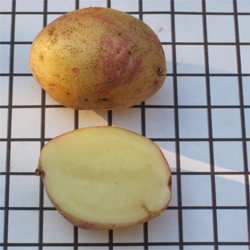 |
||||||||||||||||||||||
| Ruby Gold, OAC Ruby Gold
Medium-small oval to oblong tubers with ruby red skin and yellow flesh. A cross of Rhinered x Rose Gold by Canadian breeders Ali-Khan et al., released in Ontario in 1996. OAC is an acronym for Ontario Agriculture Canada Source: AgriCanada12 Local grower: What is the best use in the kitchen waxy tuber? |
||||||||||||||||||||||
| Ruby Pulsiver's Bluenoser
Medium-large oval - long shaped tuber with light purple skin and much darker blue "nose" on the tuber. Canadian collector Garrett Pittenger reports that this is one of three known Canadian Maritime "blues" - this variety was grown commercially on Tancook Island, Nova Scotia and was traditionally boiled with salt fish. The other two are Angelina Mahoney's Blue and Pugh's Purple. |
||||||||||||||||||||||
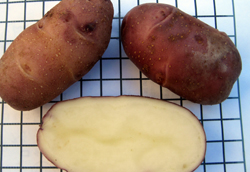 |
||||||||||||||||||||||
| In 2014 we now count 4 strains which could well all be the same potato. Angelina Mahoney's Blue, Gander Bay Blue, Ruby Pulsiver's Bluenoser and Scotia Blue [now available from SSE HF] which will be grown next to each other in 2015 so we can compare them better.
Source: AgriCanada 14 Local grower: Curzio What's the best use in the kitchen for this very starchy variety? We tasted this potato and found it flaky and dry. It features a thick skin. |
||||||||||||||||||||||
| Ruby Queen
Medium-small oval to oblong tubers with dark red skin and yellow flesh. Very old variety with unknown parentage. Mentioned in the Journal of Horticulture and Cottage Gardener, Sept 29, 1901. Source: LA D 12 Local grower: Curzio What is the best use in the kitchen starchy tuber? We tasted this potato and found it flaky, with good light flavor. The skin is medium-thin and sweet. |
||||||||||||||||||||||
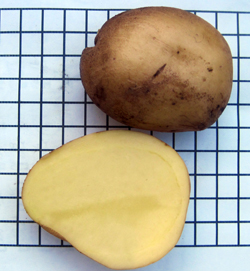 |
||||||||||||||||||||||
| Rural New Yorker # 2
Medium-large size, round tubers with pink skin and pale yellow flesh. Released in NY in 1888 by Elbert Carman, an agricultural editor (Rural New Yorker was the name of his magazine). This variety is a grand-parent of the var. Katahdin - therefore it must have Early Rose genes in the parentage. When I first received this potato from Will Bonsall in 2007 I took the first picture and categorized it as a white potato. [Could 5 years of growing a variety in organic matter change a tuber appearance so much? ] After growing it for 5 years, I now recognize the mistake and re-categorize it as a red potato. The 2011 picture clearly shows the features of an old variety - odd shape, deep eyes and the pink blotched color that is typical of the Early Rose parent. Source: ME BO W07 Local grower: What's the best use in the kitchen for this starchy variety? |
||||||||||||||||||||||
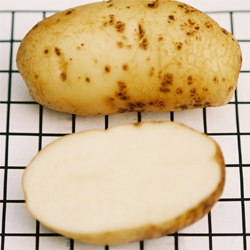 |
||||||||||||||||||||||
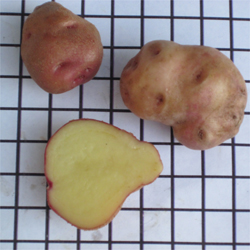 |
||||||||||||||||||||||
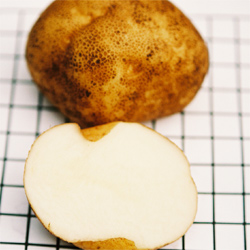 |
Russet Burbank
Large size, oblong, russeted tubers with white flesh. Released in 1914 as a sport of Burbank (which was released in 1876 as a seedling of Early Rose - a seedling of Garnet Chili 1853). Sets true seed pods. This is the most popular potato in USA - reported to have yielded 44.5% of the total crop for Fall harvest in 2012, or more than 13 billion pounds. See Potato Production in USA |
|||||||||||||||||||||
| GRIN: AV 29 Alt Source: CV Ron and CV Fe5 Local grower:
What's the best use in the kitchen? The standard for French Fryes |
||||||||||||||||||||||
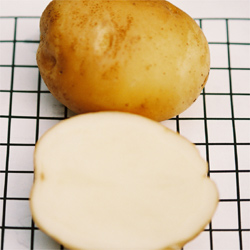 |
Russet Norkotah
Large size, oblong tubers with dark, heavily russeted, netted skin with white flesh. A cross of ND9526-4 x ND9687-5 dev. by Bob Johansen (ND State U.) and released in 1987. This is the 2nd most popular potato in USA - reported to have yielded 13.1% of the total crop for Fall harvest in 2012, or more than 5.5 billion pounds. See Potato Production in USA |
|||||||||||||||||||||
| GRIN: AV 49 Alt Source: CV Ron Local grower:
What's the best use in the kitchen? The standard for French Fryes |
||||||||||||||||||||||
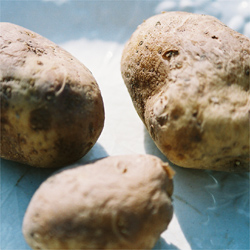 |
Russet Sebago
Tubers are elliptical to round-elliptical, medium thick; smooth ivory yellow skin; shallow eyes; white flesh. High yielding variety; fair to good storage quality; short dormancy period; sets few tubers if plants closely spaced. Medium specific gravity. Sebago Lake is the second largest body of water in Maine Source: IL SW G07 - Local Grower: Need to compare to Sebago which was bred by USDA, Presque Isle, ME (1938) from cultivars Chippewa x Katahdin. |
|||||||||||||||||||||
| My source Glenn claims that Russet Sebago is like regular Sebago only has lovely golden brown skin. | ||||||||||||||||||||||
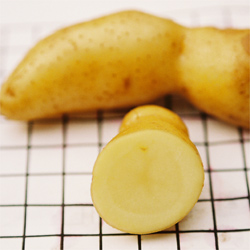 |
Russian Banana
Fingerling type tubers with with buff-yellow skin and light-yellow, waxy-textured flesh. Stores well. Great potential for the 99 pounds yield. Very Tall Vines Source: MA C08 - CV Ma23 (Banana) and CV Wo6 Local grower: Best use in the kitchen: Great for both soups, as cut pieces hold well the shape after boiling, and potato salads. See a French Potato Salad |
|||||||||||||||||||||
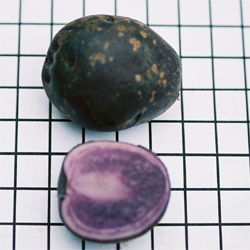 |
Russian Blue, aka Congo or All Blue
Large-medium size, oblong tubers with deep-blue to almost purple skin and brilliant purple, moist, firm flesh with slightly grainy texture. Todd tells me that this variety overwinters where planted in NY. This variety has a large number of names: it can be found also listed as Black Russian, Davis Purple, Eureka Purple, Fenton Blue, Purple Marker, Purple Mountain, Shaw #7, and Blue of Sweden (PSR: KA-67); Agri-Canada reports that the Congo cultivar is believed to have been crossed in 1900. Sets many true seed pods |
|||||||||||||||||||||
| Flagged for early flowering - turns out to produce tubers quite early - the Blue of Sweden tuber that I've received from PSR was planted late, and ended up in a pool of heavy rain - removed and transplanted after 2 weeks already showed tiny tuber settings before the first leaf emergence.
Also Blue of Sweden sets true seed pods. Tall Vines Source: NY CA T07 + PSR: KA-67 - Local grower: What's the best use in the kitchen for this starchy potato? High starch = best for baking, but how would you use it to high light the color feature - especially as it would be available on July 4th - which red/white/blue patriotic dish? |
||||||||||||||||||||||
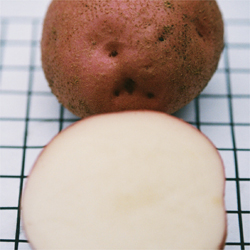 |
Sangie
Medium-large oblong tubers, pale red skin and cream flesh. A cross of Sangre (red skin, white flesh) x Bintje (yellow flesh). Source: ME BO W08 Alt Source: for Sangre CV Se16 Local grower: Best use in the kitchen: very starchy ... soup thickening and mashed ... while Sangre is reported to be waxy. |
|||||||||||||||||||||
| Santo Amor
Medium-small oval shaped tuber with tan skin and pale yellow flesh. A Brazilian cross of Konsuragis x Baronesa. This is an interesting cross of a German cultivar with a wild cultivar [Baronesa] that showed resistance to Y virus. Interesting because winters are very mild in Brasil and this variety must have established itself as particularly resistant to virus infection. Source: US Genebank 12 Local grower: Curzi |
||||||||||||||||||||||
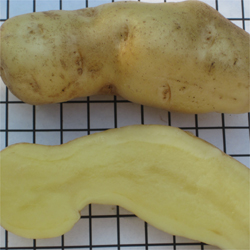 |
||||||||||||||||||||||
| What is the best use in the kitchen for this starchy tuber? We tasted this potato and found it flaky and sweet, with good flavor. The skin is thin with a bitter aftertaste. It is probably a good choice for potato pancake. | ||||||||||||||||||||||
| Sarpo Axona
Medium-large oblong tubers, yellow skin and pale yellow flesh. NOT the same as Axona - the UK variety listed by Euro-Potato. See Sarpo Mira for more info on the Hungarian breeder. Impressive production and reported to have high resistance to late blight. Source: WASTD13 Local grower: Curzio Grown in 2013 in a 14" black bag, ONE tuber produced 28.5 oz, 26 tubers, 5 over 2 oz, 19 mini and just 2 micro. Flagged for testing in an 18" tall bag in 2014 with 3 mini as starting seed. |
||||||||||||||||||||||
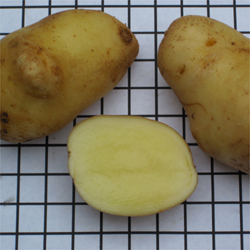 |
||||||||||||||||||||||
| What is the best use in the kitchen for this multi purpose, waxy variety? We have tasted this potato and found it waxy, with a good earthy flavor. As we tasted both Sarpo varieties in the same dish, we found Axona to have better flavor. The skin is thin. | ||||||||||||||||||||||
| Sarpo Duro
Medium-large oval to oblong tubers, pale red skin and pale yellow flesh. Sarpo Duro is a selfie of Sarpo Mira and was named by Tom Wagner. Source: WA HO C 14 Local grower: Curzio |
||||||||||||||||||||||
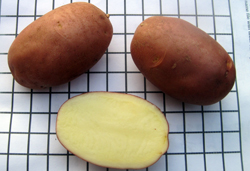 |
||||||||||||||||||||||
| What is the best use in the kitchen for this multi purpose, starchy variety? We tasted this potato and found it flaky, but not too dry. It probably would make great mash potato. The skin is thin, with a slight bitter aftertaste. Obviously very similar to Sarpo Mira. Would be interesting to do a direct comparison. | ||||||||||||||||||||||
| Sarpo Mira
Medium-large oval to oblong tubers, pale red skin and pale yellow flesh. SarPo is an acronym of the Hungarian project manager Dr. Istavaán Sárvári therefore Sar Potato. The Project led to the discovery of horizontal resistance to potato blight and viruses. May also have great tollerance to drought as in the 2012 extreme drought, without watering it has produced remarkably well. Source: AN J11 Local grower: Curzio |
||||||||||||||||||||||
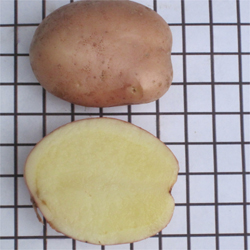 |
||||||||||||||||||||||
| Grown in 2013 in an 18" tall bag, 3 tubers produced 37 oz, 35 tubers, 3 over 2 oz, 28 mini and just 4 micro. Flagged for further testing in an 18" tall bag in 2014 with 4 mini tubers as starting seed.
What is the best use in the kitchen for this multi purpose, starchy variety? We tasted this potato and found it flaky, but not too dry. It probably would make great mash potato. The skin is thin, with a slight bitter aftertaste. |
||||||||||||||||||||||
| Sarpo Yelm
Named by Tom Wagner and selected for yield and resistance to Late Blight as a selfie of Sarpo Mira. We were impressed by the very dark color of the foliage. Source: WA HO C 14 Local grower: Curzio We tasted this potato and found it waxy. What is the best use in the kitchen for this multi purpose, waxy variety? |
||||||||||||||||||||||
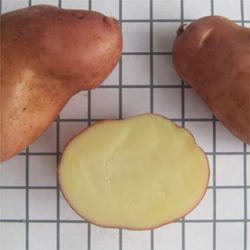 |
||||||||||||||||||||||
| Saucisse (aka Reine des Celtes)
Heritage French variety with medium-small oval to oblong tubers, pink skin and yellow flesh. Reported to be darker in the past - may go back to 1870. Source: AN J11 Local grower: not in USA We tasted this potato and found it creamy with just a hint of bitter. What is the best use in the kitchen for this multi purpose, starchy variety? |
||||||||||||||||||||||
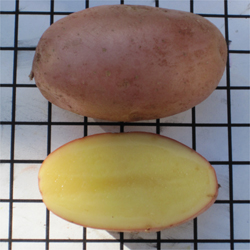 |
||||||||||||||||||||||
| Scotia Blue
Medium - large oblong tubers with lavender blue skin and creamy flesh. Scotia is just short for Nova Scotia, Canada and this variety may just be a strain of many available in Nova Scotia, including Angelina Mahoney Blue and Ruby Pulsiver Bluenoser. Source: IA SSE HF 14 Local grower: Curzio |
||||||||||||||||||||||
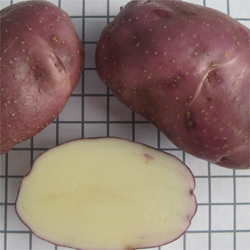 |
||||||||||||||||||||||
| We tasted this potato and found it very dry and flaky. Because is grows larger tubers it may work great to make gnocchi. The skin is medium thin with a nutty flavor. What would be the best use in the kitchen for this starchy variety? | ||||||||||||||||||||||
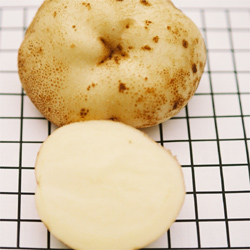 |
Sequoia
Jim tells me: Sequoia was once in the collections of a small group of seed savers, but I have been the only one offering it for many years. I got a request for a large sample which I couldn't supply from a gardener who thought it might be resistant to Colorado Potato Beetles. I am not sure that Sequoia is resistant to the beetles, but it might be able to stand fairly heavy infestation because it has big vines and could lose some of its foliage to feeding and still produce a crop. |
|||||||||||||||||||||
| At a meeting of seed savers an older man said that Sequoia potatoes helped his family get through hard times during the depression. It is my guess that this variety can do well and produce a good crop for people with a lack of resources due to its vigor and large vines. I have heavy soil that isn't good for potato production, but in a good year the vines are fairly long and some large tubers are produced. I only grow 6 or 8 fairly closely spaced hills and probably haven't really given them a chance to show what they can do. They do get some what scabby in my garden which probably has conditions that promote the development of scab. The tubers that aren't scabby seem to be slightly russeted, the flesh is white, and the few that I have eaten have a good flavor. Sets true seed pods
Source: MN TJ J07 - Local grower: Curzio Best use in the kitchen: We suggest to use this tuber for a very tasty Leek - Potato Soup - the tuber boils down to a thick soup consistency without the use a blender or food processor. See the recipe linked above for all the details. |
||||||||||||||||||||||
| Seneca Horn
Large, crescent shaped tubers with blue skin and cream flesh. Iroquois Indian potato from the Northern New York area, from Chief George Heron. In this picture 2 Seneca Horn tubers are compared to one Cowhorn. The skin looks different because the tubers were grown in different soil in 2010. Source: AA E 09 Local grower: Curzio - comparing to Cowhorn The taste comparison will likely be very similar as I found the one Seneca Horn tuber I cooked to taste rather mealy, starchy. |
||||||||||||||||||||||
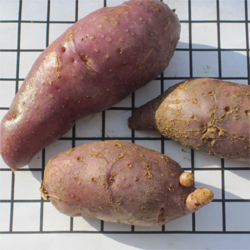 |
||||||||||||||||||||||
| Shamrock
Medium-large blocky tubers - looks similar to Lumpers - listed as a 1900 Irish variety. Source: LA D 12 Local grower: What's the best use in the kitchen for this starchy potato? Perhaps similar to Lumpers. |
||||||||||||||||||||||
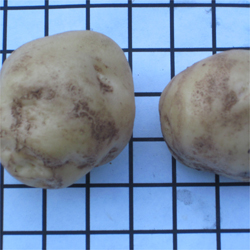 |
||||||||||||||||||||||
| Sharon's Blue
Medium-large oblong tubers with blue skin and blue flesh from the collection of Elmer Hanson. Grown from an in-vitro seedling in 2009 - unfortunately the 2010 crop was not large to allow for much comparative cooking. Source: AgriCanada 09 Local grower: Best use in the kitchen: to be compared with all other blue fleshed tubers - but it appears to keep the blue color darker once cooked. |
||||||||||||||||||||||
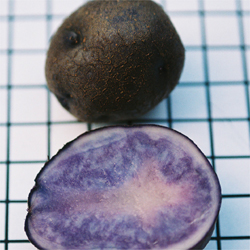 |
||||||||||||||||||||||
| Siberian, aka Fiery Eyes
Medium size tubers, white skin with red blotches around the eyes and white flesh. Potato collector George Brison tells me that he obtained this variety back around 1990 as Siberia and grew it for several years. George had an uncle who passed away at age 102+, in 2003, (he ate a lot of potatoes!!) and he remembered his parents, and himself, growing this variety back around 1920 and it was known as "Fiery Eyes". Grows TALL VINES and sets tuber high. May be a very good choice for growing in containers. |
||||||||||||||||||||||
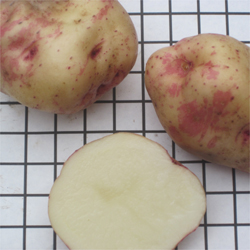 |
||||||||||||||||||||||
| Source: AgriCanada 10 in-vitro Local grower: Curzio
Grown in 2011 in a black 14" bag 6 seed pieces yielded 21.5 oz > 5 regular sized, 26 mini tubers and 35 micro. In 2013 a much better yield in an 18" tall bag, 3 seed pieces produced 56oz, 65 tubers, of which 11 above 2oz, 42 mini and 12 micro. What's the best use in the kitchen for this smaller, starchy variety? We tasted this potato and found if flaky but moist. The flavor is mild, almost bland. The skin is this and sweet. |
||||||||||||||||||||||
| Sieglinde
Medium-large oval to oblong tuber with yellow skin and darker yellow flesh. An Austrian cross of Bohm 155/06 x Juli released in 1935. Source: US Genebank 12 Local grower: We have tasted this potato and found it firm with a thin skin - probably a great choice for potato salads. What's the best use in the kitchen for this waxy variety? |
||||||||||||||||||||||
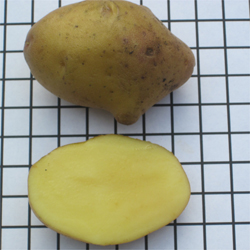 |
||||||||||||||||||||||
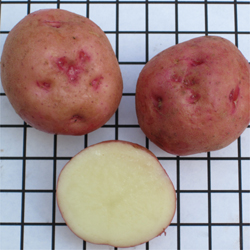 |
Six Weeks
Medium-large tuber with red skin and white flesh. Thank you to AgriCanada for making this rare tuber available - the name Six Weeks (roughly 40 days) hints to an early variety. The history of this tuber is intertwined to the Mennonites who left Switzerland circa1500 to find religious freedom abroad, eventually settling in the Canadian Province of Saskatchewan. Source: AgriCanada 10 Local grower: Curzio Grown in 2013 in an 18" tall bag, 3 tubers produced only 12 oz, 21 tubers, of which 13 mini and 8 micro. Not a good choice for 18" tall bags. |
|||||||||||||||||||||
| What's the best use in the kitchen for this starchy potato? We tasted this potato and found it flaky, but not too dry. This skin is medium-thin. | ||||||||||||||||||||||
| Skagit Diploid # 10
Medium-small round tubers, with dark purple and yellow skin and yellow flesh. An other variety from Tom Wagner's work. This variety grows very long vines and produces acorn shaped seed berries. Source: WA HO C 13 Local grower: Curzio |
||||||||||||||||||||||
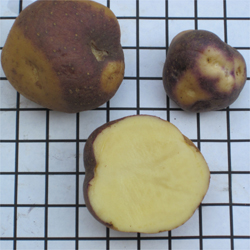 |
||||||||||||||||||||||
| What's the best use in the kitchen for this waxy potato? We tasted this potato and found it creamy, with a very delicate flavor. This skin is thin and slightly bitter. | ||||||||||||||||||||||
| Skagit Diploid # 11
Medium-small ancient looking tubers, with white skin and flesh. An other variety from Tom Wagner's work with Skagit lines showing how diverse tubers may develop. This variety grows very long vines and produces acorn shaped seed berries. Source: WA HO C 13 Local grower: Curzio |
||||||||||||||||||||||
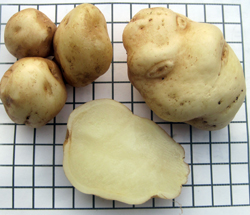 |
||||||||||||||||||||||
| Skagit Plenty
Medium-small round tubers, with dark yellow skin and dark yellow flesh. An other variety from Tom Wagner's work. This tuber looks suspiciously identical to SVG and I may need to double check if I received the correct cultivar. [edit anchor] Skagit Plenty should have visible lenticels on the skin? Source: WA HO C 14 Local grower: Curzio |
||||||||||||||||||||||
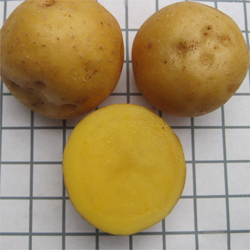 |
||||||||||||||||||||||
| What's the best use in the kitchen for this waxy variety? We have tasted this potato and found it waxy but a little dry with a spicy tingle, like it's expected from a Papa Criolla type of tuber. | ||||||||||||||||||||||
| Skagit Valley Gold
Medium-small round tubers, with dark yellow skin and dark yellow flesh. Perhaps the most popular Tom Wagner breed. At this time history and parentage not fully disclosed, except for Yema de Huevo, known to be a g.g.g. parent. Tom Wagner created this potato in response to request for a Papa Criolla that would produce well at lower altitudes. Source: WASTD13 Local grower: Curzio |
||||||||||||||||||||||
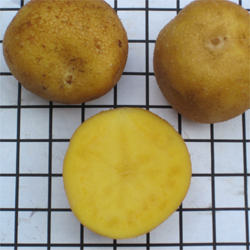 |
||||||||||||||||||||||
| Grown in 2013 in a 14" black bag, 3 tubers produced 24.5 oz, 39 tubers, of which none above 2 oz, 30mini and 9 micro. Flagged to be tested in 2014 in an 18" tall bag to compare with a 14" bag, with more mini tubers as starting seed to check if seed crowding works well with this variety.
What's the best use in the kitchen for this waxy variety? We have tasted this potato and found it flaky but moist. Great flavor. The dark yellow flesh must reflect high levels of betacarotine. The skin is medium thin and tasty. |
||||||||||||||||||||||
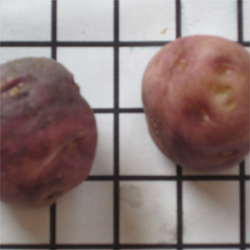 |
Skerry Blue (aka Kerry Blue)
Medium-small round-oval tubers, purple skin and white flesh with purple ring under the skin. Released in 1846. Source: ME BO W08 Local grower: What's the best use in the kitchen? |
|||||||||||||||||||||
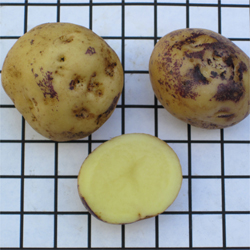 |
Skerry Champion, aka Champion
Medium-large round-oval tubers, yellow skin with red/purple marking and pale yellow flesh. An old Irish variety with White Peachblow [1865] and Compton's Surprise [1870] parentage, therefore likely a pre-1900 variety. Interesting to find an American variety [Peachblow] in the parentage of this old Irish variety. Source: LA D 12 Local grower: Curzio |
|||||||||||||||||||||
| What's the best use in the kitchen for this waxy variety? We tasted this potato and found it creamy with wonderful flavor. The skin is thin and tasty. The purple blotches in the skin keep well after cooking. Pan frying with olive oil and rosmary would make a great side dish that highlights the skin color pattern. | ||||||||||||||||||||||
| Snowden
Medium-small size, round tubers with white skin and white flesh. High yielding variety that produce a high tuber set with a large number of smaller tubers if spacing is too close. A spacing of 30 to 38 cm (12 to 15 inches) is recommended - but perhaps you may want smaller tubers. A cross of B5141-6 x Wischip released in WI in 1973. Source: ME BO W07 Alt Source: CV Ron Local grower: FredB |
||||||||||||||||||||||
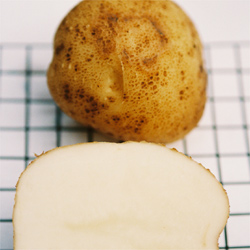 |
||||||||||||||||||||||
| What's the best use in the kitchen? | ||||||||||||||||||||||
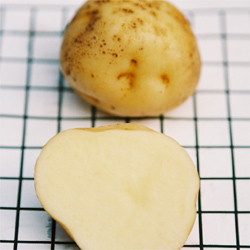 |
Snowdrift
Medium-small, white, blocky tubers with creamy flesh, good yield, good storage. GRIN: AV 35 Source: AK WO K07 Local grower: FredB What's the best use in the kitchen? Great for American Fries and Rösti. |
|||||||||||||||||||||
| Snowflake 1874
Heritage variety producing medium-large oval to oblong tubers, yellow skin with red blushes and white, very starchy flesh. Bred by Cyrus Pringle of Vermont and released in NY in 1874. NOT to be confused with other varieties named Snowflake (incl. one release in ND in 1963). Source: PA W3 11 Local grower: Will W Weaver reports this variety to be THE BEST for mashed potato. |
||||||||||||||||||||||
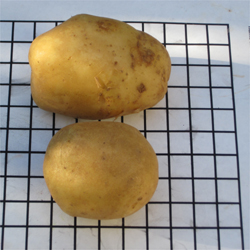 |
||||||||||||||||||||||
| Stella's New Foundland
A Canadian heritage variety with unknown parentage, featuring medium-small oval to oblong tubers with light purple skin and a cream colored flesh. Source: AgriCanada12 Local grower: Curzio Grown in 2013 in a 14" Poppy Orange bag 3 mini produced 25.5 oz, 23 tubers, of which 3 standard, 16 mini and 4 micro. Since mini tubers are more interesting to cook with, this variety has been flagged for testing in 2014 with 4 mini as starting seed - fewer starting seed would likely develop larger tubers. |
||||||||||||||||||||||
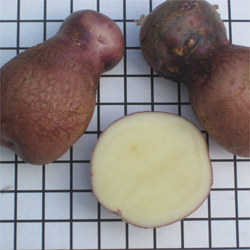 |
||||||||||||||||||||||
| What's the best use in the kitchen for this waxy potato? We tasted this potato and found it creamy, with a good earthy flavor. The skin is medium-thin with a slightly bitter aftertaste. Unforturnately the skin color is lost in cooking, but we noticed sometimes the lavender color transfers to the flesh surface. | ||||||||||||||||||||||
| Stick Valley
Small-large white tuber, the 2012 picture shows how much shape variation is possible. Another variety from the Korean Potato Valley Institute. Little is available about this variety, except it is developed for French Fries, therefore it should be starchy. Source: US Genebank 12 Local grower: We tasted this potato and found it tasty and sweet, featuring a med-thick sweet skin. What is the best use in the kitchen? |
||||||||||||||||||||||
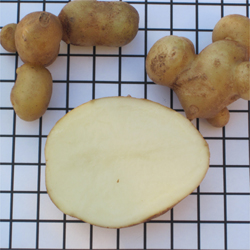 |
||||||||||||||||||||||
| Straight Banana
A fingerling type tuber selected by Evelyne Smetaniuk of Fort St. John, British Columbia by replanting the straightest tubers over a ten year time period. As you can tell from this picture it's a working project ... bananas will be never truely straight. Source: AgriCanada 09 Local grower: Best use in the kitchen: Pan roasted or in a German Rhine Potato Salad |
||||||||||||||||||||||
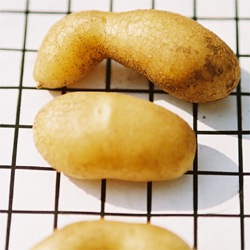 |
||||||||||||||||||||||
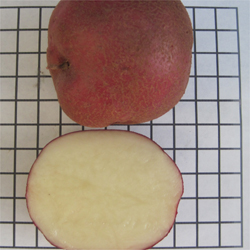 |
Srawberry Paw [aka NY136]
Medium-large size, round to oblong, but mostly blocky tubers - released by Cornell as NY136 [edit pagentage]. |
|||||||||||||||||||||
| Source: CV Fe5 14 Local grower: Curzio
What's the best use in the kitchen for this multi-purpose variety? We tasted this potato and found it flaky but moist, with a light flesh texture and a sweet aftertaste. It features a thin skin. |
||||||||||||||||||||||
| Superior
Medium size, round white tubers - compared to Irish Cobbler, but not as early. A cross of MN59.44 x USDA X96-56 released in WI in 1951. Source: ME BO W07 Local grower: Alt source: CV Ma23 What's the best use in the kitchen? |
||||||||||||||||||||||
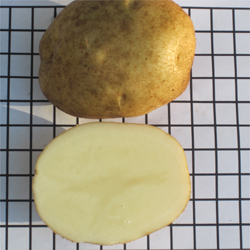 |
||||||||||||||||||||||
| Svart Potatis, see Blå Dalsland
Medium-small, round tubers with dark skin and yellow flesh (notice a purple ring under the skin), Svart is black in Swedish - these tubers have tendency to grow over the soil line and turn black if exposed to the sun light. Facebook friend Mikko Heikkinen reports that there may be confusion with this name, as it has also been used as a synonym for Congo [which we know is one of the many names of the popular All Blue - Blue Marker variety]. Source: ME BO W10 Local grower: Curzio |
||||||||||||||||||||||
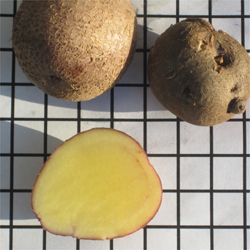 |
||||||||||||||||||||||
| What's the best use in the kitchen for this starchy tuber? | ||||||||||||||||||||||
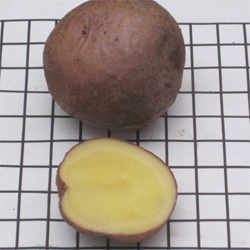 |
Svenljunga Blå
Medium-small round tubers with blue skin and pale yellow flesh, darker in the center - rare variety with likely Skandinavian heritage. Source: ME BO W10 Local grower: Curzio Grown in 2013 in a 14" Poppy Orange bag 3 mini produced 41.5 oz, 43 tubers, of which 10 standard [about 2 oz each], 29 mini and only 4 micro. Flagged for testing in 2014 with 4 mini as starting seed to check if we can increase the yield with on additional seed. |
|||||||||||||||||||||
| What's the best use in the kitchen for this starchy tuber? We tasted this potato and found it flaky but moist, with mild taste. The skin is medium thin and fades after cooking, while the flesh darkens the yellow color. | ||||||||||||||||||||||
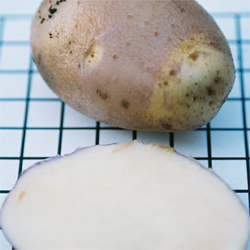 |
Tanana Purple
Medium round-flattened tubers, unique skin color mostly lavender with tan blotching and creamy flesh. Source: ME BO W08 Local grower: Curzio What's the best use in the kitchen for this starchy variety? |
|||||||||||||||||||||
| Taws Down Black
Perhaps yet another synonym to All Blue [see Ake Truedsson Blue for a list of synonyms] - this name originates in Ireland where it's used for marbles - small black stones. Source: LA D 12 Local grower: Curzio We have tested this potato and found it surprisingly good tasting, with a better texture than most blues, not as dry. What's the best use in the kitchen for this starchy variety? |
||||||||||||||||||||||
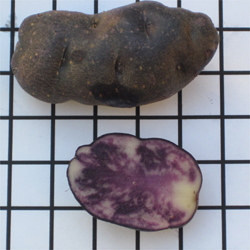 |
||||||||||||||||||||||
| Tet Red "Good Yield"
Medium-large blocky tubers with red skin and white flesh. A Tom Wagner breed of unknown parentage. Tom names it "Good Yield" and in fact it produces quite well. Source: WA ST D 13 Local grower: Curzio Grown in 2013 in a 14" Poppy Orange bag, ONE tuber produced 38.5 oz, 19 tubers, of which 9 standard, 6 mini and 4 micro. Flagged for testing with 3 seed pieces in 2014 .. expected to be a top producer. |
||||||||||||||||||||||
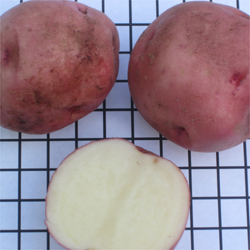 |
||||||||||||||||||||||
| What's the best use in the kitchen for this starchy variety? We tasted this potato and found it flaky, with good nutty flavor. The skin is thin and sweet. It should make a great mash potato. | ||||||||||||||||||||||
| Thumper
Small blocky tubers with dark yellow skin and flesh. A Tom Wagner breed of unknown parentage, but reported to be part on the Thunderation line and Skagit lines, which clearly show the phureja ancestry. Source: WA HO C 14 Local grower: Curzio |
||||||||||||||||||||||
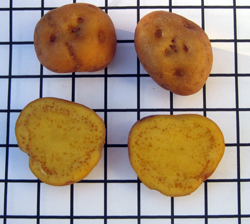 |
||||||||||||||||||||||
| What's the best use in the kitchen for this difficult to classify variety? We tasted this potato and found it in taste and texture very similar to yams, with a chestnut aftertaste. The skin is medium thick. | ||||||||||||||||||||||
| Tibet
A British variety with bicolor tan-red skin. The vines develop seed berries. Source: LA D 12 Local grower: Curzio Grown in 2013 in an 18" tall bag, the vine struggled, so the variety is tagged for a 14" bag in 2014. Very interesting how the vines seemed attractive to pests which completely defoliated the vine. Still it came back and even developed seed berries in the 18" tall bag. What's the best use in the kitchen for this waxy variety? We tasted this potato and found it creamy, with earthy taste. The skin is medium and bitter. |
||||||||||||||||||||||
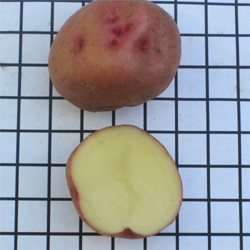 |
||||||||||||||||||||||
| Tobique
Medium-large round to oval tubers with yellow-red skin and pale yellow flesh, a Canadian cross of Cariboo x F45019 which is a late blight resistant seedling with high dry matter (seedling of Katahdin), released in 1977. Tobique, like Cariboo, grows Tall Vines. In 2011 grown in a black SmartBag - 2 seed pieces yielded 19 oz of tubers - 6 in standard size and 4 mini (no micro). As the soil in black bags is much warmer than for traditional field plantings, the number of standard sized tubers (but no micro) may well be a sign of great Heat Tolerance. Sets true seed pods |
||||||||||||||||||||||
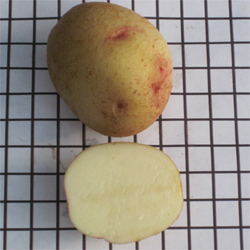 |
||||||||||||||||||||||
| Source: AgriCanada 10 Local grower: Curzio
What's the best use in the kitchen for this multi-purpose tuber? We tasted it and found starchy, slightly bitter. The skin is medium thick. |
||||||||||||||||||||||
| Tom Thumb
Medium-small British tuber. It grows the size of a thumb as the name suggests and features a reddish brown skin with pale yellow flesh. Source: LA D 12 Local grower: Curzio What's the best use in the kitchen for this waxy variety? We tasted this potato and found it creamy with good flavor. The skin is medium thin. The bite sized shape probably makes it a good choice for roasted side dish. |
||||||||||||||||||||||
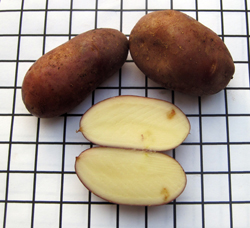 |
||||||||||||||||||||||
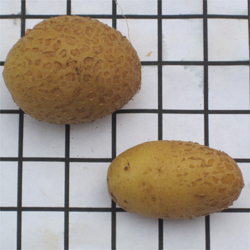 |
Torridon
Medium-small oblong tuber with russeted skin and light yellow flesh. A Scottish cross of 8372 a 17 x G5833 5 released in 1988. Reported to have high to very high resistance to all viruses. It features high dry matter. Source: US Genebank 12 Local grower: Curzio What's the best use in the kitchen for this starchy variety? |
|||||||||||||||||||||
| Unalm Guisi
Medium-small Peruvian tuber with parentage listed as the Mexican variety Conchita and the Peruvian varieties Yuracc Tarma and Wila Imilla. The name UNALM is an acronym for the National Agricultural University of La Molina in Peru, while GuiSi is a dedication to the memory of the late student Guillermo Simbaña who died, in a sad and dark night of terrorist insanity, near to the field where he was evaluating the hybrid's agronomic performance. |
||||||||||||||||||||||
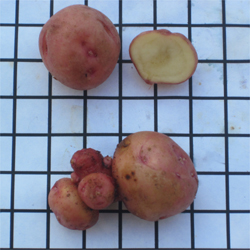 |
||||||||||||||||||||||
| Source: US Genebank 12 Local grower: Curzio
What's the best use in the kitchen for this starchy to multi-purpose variety? We tasted this potato and found it creamy. |
||||||||||||||||||||||
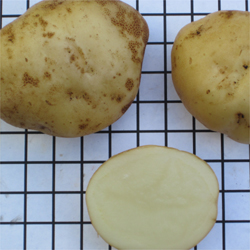 |
Up-to-Date
Medium-large flattened oval shaped tuber with cream colored skin and flesh; the skin may show light russet. A cross of Patterson's Virginia and Blue Don, released about 1894 by British potato breeder Archibald Findlay. One of the most popular varieties of the early 20th century - grown with a very large number of synonyms. GRIN: PI 407425 Source: AgriCanada 09 Local grower: Curzio |
|||||||||||||||||||||
| Grown in 2013 in an 18" tall bags, 3 tubers produced 32 oz, 34 tubers, of which 3 standard, 28 mini and only 3 micro. Flagged to be tested with 4 starting mini tubers in 2014.
What's the best use in the kitchen for this starchy to multi-purpose variety? We tasted this potato and found it flaky and earthy. Good, sweet tasting, medium thin, lightly russeted skin. This is a good multi-purpose variety. |
||||||||||||||||||||||
| Urgenta
Medium-small round to oval tubers with light red skin and pale yellow flesh, a Dutch cross of Katahdin x Furore by J.C. Cross, released in 1953. GRIN: PI 217560 Source: AgriCanada 10 Local grower: What's the best use in the kitchen for this waxy, buttery tasting tuber? |
||||||||||||||||||||||
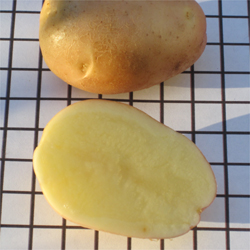 |
||||||||||||||||||||||
| Ursus
Large, round to oblong white tubers, developed in Poland as a cross of PS 647 x Maradonna and released in 2004. It shows high resistance to wart disease. Features high starch content and is suitable for French fries. Source: US Genebank 12 Local grower: Curzio Grown in 2013 in an 18" tall bag, 3 tubers produced 47.5 oz, 38 tubers, 4 above 2 oz., 30 mini and just 4 micro. Flagged to be tested in 2014 with 4 starting mini tubers to check if it is possible to further increade the total yield in an 18" tall bag. |
||||||||||||||||||||||
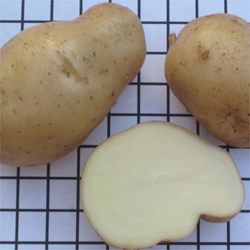 |
||||||||||||||||||||||
| What's the best use in the kitchen for this starchy tuber? We tasted this potato and found if flaky but moist, with good earthy flavor. The skin is thin. This variety would probably make wonderful LIGHT mash potato, as the texture of the starchy flesh is already quite moist and will not require too much addition of butter, milk or cream. | ||||||||||||||||||||||
| Valisa
Medium-small round to oval tubers with yellow skin and yellow flesh, bred by Rocky Verlin, founder of CV Potato Garden which now owns Ronniger Potato (CV Ron) as a cross of Agria and German Butterball. Not to be confused with other varieties with the same name - incl. one German and one owned by Norika. The German Valisa - not this one! - was used by Carlos Quiros of UC Davis to further improve the carotenoid content of his Inka Gold to produce 07S18 California Gold, 07S19 Gold Nugget and 07S20 Doubloon. |
||||||||||||||||||||||
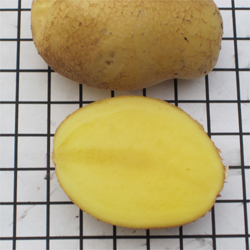 |
||||||||||||||||||||||
| Source: CV Ron11 Local grower:
What's the best use in the kitchen for this waxy variety? |
||||||||||||||||||||||
| Verrayes (aka Tartufolo)
Italian Heritage variety, from the mountain region North of Piedmont - aka Truffel because of the dark skin color and deep eyes which remind of the Italian mushroom. Seems to be quite late with possible resistance to light frost. Notice how the skin color bleeds into the flesh [rust when raw - turns blue when cooked]. Source: PSR Local grower: What's the best use in the kitchen for this waxy, multi-purpose variety? |
||||||||||||||||||||||
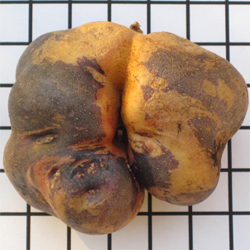 |
||||||||||||||||||||||
| Vicasso
Medium-small round to oval tubers with yellow skin with red blush on the stern end and yellow flesh, bred by Rocky Verlin, founder of CV Potato Garden which now owns Ronniger Potato (CV Ron) as a cross of Agria and German Butterball. Vicasso seems a little later than Valisa. Source: CV Ron11 Local grower: What's the best use in the kitchen for this waxy variety? |
||||||||||||||||||||||
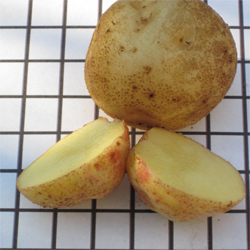 |
||||||||||||||||||||||
| Violette (aka Violette du Lac Bret)
Medium-large, fingerling shaped tubers with purple skin and purple flesh, grown in Switzerland (Lac Bret is a lake close to Vevey) and believed to be a 1920s sport of Négresse, aka Vitelotte Noire which was introduced into France in 1815 from Peru. Source: VT DA S07 Locat grower: Curzio |
||||||||||||||||||||||
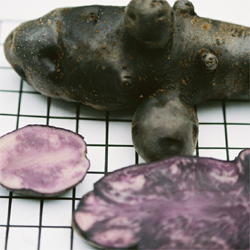 |
||||||||||||||||||||||
| Best use in the kitchen: Interesting suggestion for Négresse that may work with Violette: purple mash potato - by adding lots of butter it turns green (work 2 batches for bi-color mashed potatoes).
I'm planning to grow the 3 similar cultivars Violette, Negresse and Ajanhuiri in 2009 for comparison. Also I can't wait to be able to compare the taste - this year I had a good crop of Violette and noticed an earthy taste that reminds me of roasted chestnuts. The picture above shows a small Negresse cutting that seams lighter in color compared to Violette Lac de Bret. The darker color matches with higher levels of antioxidants. |
||||||||||||||||||||||
| Vivaldi
Medium-large oval tubers with yellow flesh. One of the most popular varieties grown in the Bisalta Mountain area of the province of Cuneo, Piedmont, Italy - cultivar originates from Holland. Released in 1985. Source: ITA CN Local grower: Best use in the kitchen: Grown in Italy especially for gnocchi. |
||||||||||||||||||||||
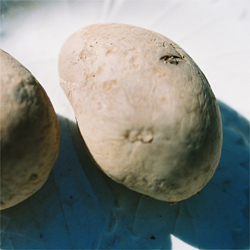 |
||||||||||||||||||||||
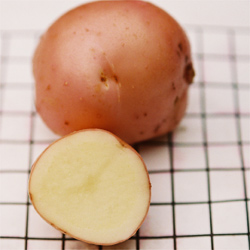 |
||||||||||||||||||||||
| Vriner
Medium-large, long-oval tubers with bright red skin and yellow flesh. Swiss variety. Source: PSR Local grower: Lost What's the best use in the kitchen? Flavorful mashed potatoes |
||||||||||||||||||||||
| Weisse Lötschentaler
Medium, oval white tubers. Grown in the Swiss valley of Lötschental, Canton of Valais. Source: PSR Local grower: Curzio Best use in the kitchen: The optimal variety for the Swiss side dish known as Rösti. |
||||||||||||||||||||||
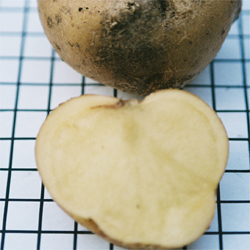 |
||||||||||||||||||||||
| Wettstein's White Crescent
Fingerling "crescent moon" shaped tubers, pale yellow skin and pale yellow flesh. Rare. Source: ME BO W08 Local grower: Best use in the kitchen: one more waxy fingerling to suggest for a potato salad. |
||||||||||||||||||||||
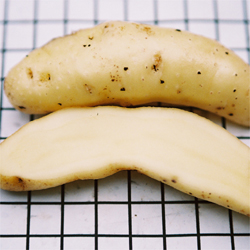 |
||||||||||||||||||||||
| White Rose, Wisconsin Pride
Large, long white tubers claimed to have been originated by Mrs. Rachael Chapman in New York State from a seed ball of the Jackson potato in 1893. Today White Rose is the preferred name, but it was also known as American Giant, Wisconsin Pride, Late Pride, California Long Whites, Long Whites. Source: AgriCanada 09 Local grower: Curzio Grown in 2013 in an 18" tall bag, 3 seed pieces produced 13 oz, 10 tubers, 3 above 2 oz., 5 mini and only 2 micro. While in 2011 6 tubers produced 27 oz in a 14" black bag. We flagged the variety to be tested in a 14" bag with 5 seed pieces in 2014. |
||||||||||||||||||||||
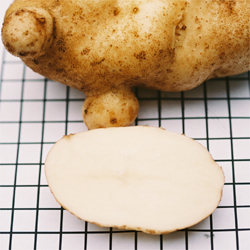 |
||||||||||||||||||||||
| What's the best use in the kitchen for this starchy potato? We tasted this potato and found it starchy but not too flaky. The taste is good with a mild bitter aftertaste. The skin is thin, which may not make this variety the best choice for a baked potato. Because it grows larger spuds, you will need to cut it in chunks, but It'is interesting to observe how the chunks keep their shape if not cooked too long. Usually starchy tubers fall apart easily. | ||||||||||||||||||||||
| Wiesner aus Zillis
Swiss heritage fingerling shaped tuber grown is Switzerland for 200+ years, possibly a parent of Parli and a yellow fleshed seedling of Yam (flesh is darker yellow than Parli). Zillis is a town in the Alps, located in Eastern Grisons, in the high valley of the Rhine river. Source: PSR Local grower: What is the best use in the kitchen for this very dry matter, starchy tuber? |
||||||||||||||||||||||
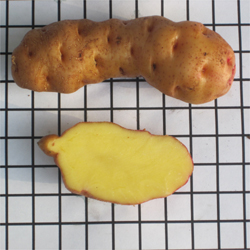 |
||||||||||||||||||||||
| Woudster
Medium-large oval to oblong tubers with bi-color tan/pink skin and cream color flesh. A Dutch variety released in 1960 as a cross of Rode Star x Libertas. Develops TALL VINES and sets tubers high and serial. May be a good choice for growing in containers. Source: SSE HF13 Local grower: Curzio Grown in 2013 in an 18" tall bag in part shade, 3 tubers produced 34 oz, 34 tubers, 4 above 2 oz, 26 mini and only 4 micro. Flagged to test in 2014 with 4 mini as starting seed, and will be grown in full sun. |
||||||||||||||||||||||
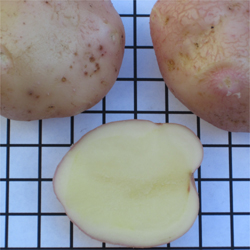 |
||||||||||||||||||||||
| What is the best use in the kitchen for this starchy tuber? We have tasted this potato and found it flaky and dry, with a bland flavor and slightly bitter aftertaste. The skin is medium-thin and bitter. | ||||||||||||||||||||||
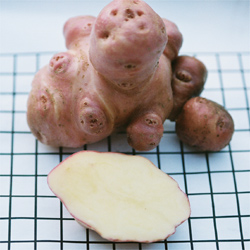 |
Yam
Medium-small tubers which grow showing features typical of very old cultivars - before commercial farming bread tubers to more regular shapes - yellow flesh, from England (1771), maybe parent to Swiss variety Parli. Very rare variety. Very late - the last vegetation to die off. Tuber set is very shallow. Source: MI B07 Locat grower: Curzio |
|||||||||||||||||||||
| What's the best use in the kitchen? Parli is one of the best potato for gnocchi - if this is a parent - could be as good. | ||||||||||||||||||||||
| Yana Macuco
Medium-small round, Peruvian landrace belonging to S. tuberosum subsp. andigenum. Impressive color of the stems. The vines grow very tall and the flowers mature to produce seed berries. PI 642182 CIP 702108 Source: US Genebank 14 Local grower: Curzio What's the best use in the kitchen for this waxy variety? We have tasted this potato and found it creamy and buttery, slight bitter aftertaste. The skin is medium thick. |
||||||||||||||||||||||
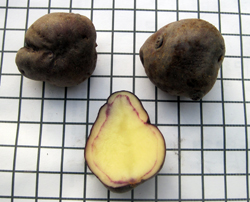 |
||||||||||||||||||||||
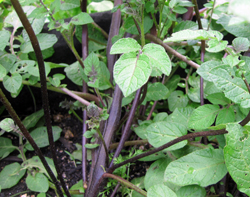 |
||||||||||||||||||||||
| Yana Macuco vines .. darkest color in the Exotic batch. | ||||||||||||||||||||||
| Yellow Finn
Medium-large round, flattened tubers with yellow skin and bright yellow flesh. A European Heritage Gourmet variety. Source: CV Fe5 Alt Source: CV Ron CV Ma23 CV Se16 Local grower: Suggested as one of the best varieties for gnocchi - the flesh is definitely starchy, therefore also great for mashing and baking. |
||||||||||||||||||||||
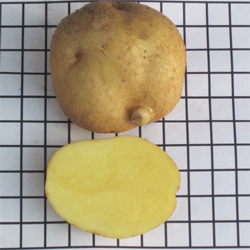 |
||||||||||||||||||||||
| Yellow Tumblestone
Large, oval to oblong yellow tubers with light purple eyes. I was not able to find any history on this variety. Source: MI BE O13 Local grower: Curzio Grown in 2013 in part shade in an 18" tall bag, 3 tubers produced 55 oz, 27 tubers, 9 standard, 14 mini and 4 micro. The tuber in this picture came in at 11 oz and is the largest tuber ever harvested in a growing bag. |
||||||||||||||||||||||
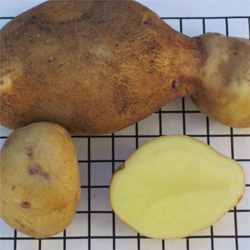 |
||||||||||||||||||||||
| What's the best use in the kitchen for this starchy variety? We have tasted this potato and found it flaky, with a earthy, slight bitter aftertaste. The skin is medium thin. | ||||||||||||||||||||||
| Yema de Huevo
Small tubers with swallen stolons. A Colombian landrace with extremely long growing season. This is a day neutral vine that requires a long season to tuberize. The tubers set on longer stolons which further swallen and set further micro tubers. GRIN: PI 665407 Source: US Genebank13 Local grower: Curzio Flagged to be tested in a bag to be placed in a hoophouse early in the spring to possibly extend the growing season. |
||||||||||||||||||||||
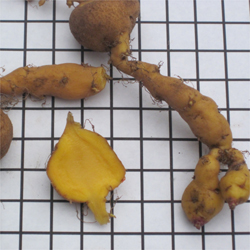 |
||||||||||||||||||||||
| What's the best use in the kitchen for this starchy variety? We have tasted this potato and found it creamy and extremely sweet - it reminds us of the taste of a sweet potato, with a very similar texture, down to the stringy texture of the swallen stolons. The stolons have a slightly bitter aftertaste. | ||||||||||||||||||||||
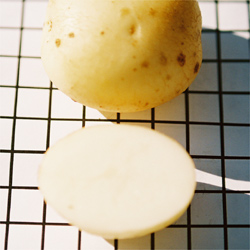 |
York
Medium-large size, round white tubers, early. A cross of F55069 x F53048 released in Canada in 1969. Reported to have high Alkaloids levels (TGA). GRIN: AV 46 Source: ME BO W07 Local grower: What's the best use in the kitchen? |
|||||||||||||||||||||
| Yukon Gold
Medium-large size, round to oval yellow tubers, very early, perhaps one of the best choices for early potato production in hoop-houses. Released in 1980 by UoG Ontario. Click here for the full story written by the breeder Gary Johnston. Source: CV Local grower: What's the best use in the kitchen? |
||||||||||||||||||||||
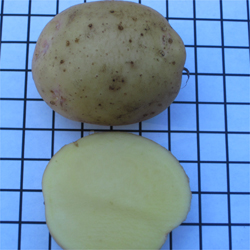 |
||||||||||||||||||||||
| Yungay, aka Papa Chola
Medium-large size, oval and flat tuber, yellow skin with red eyes and yellow flesh. Grows on long stolons and was developed in Peru as a cross of (Sequoia x Earlaine) x (Huagalina x Renacimiento). A variety grown commercially in Latin America, aka Papa Chola, with the meaning of tolerant to adverse soil conditions. This may be a day neutral variety which requires a long growing season. Oct 15 the vine was still flowering. In 2013 it produced a lot of seed berries. |
||||||||||||||||||||||
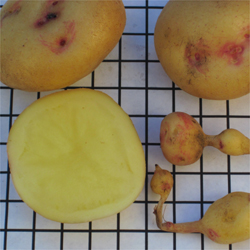 |
||||||||||||||||||||||
| Grown in 2013 in an 18" tall bag, 3 tubers produced 40.5 oz, over 50 tubers, of which 3 above 2oz, and 43 in mini size, and a number of micro bulbils [not counted]. The picture shows how this variety grows long stolons on which tubers swell in serial manner. Most tubers are in edible size, which makes this variety one of the best choices for growing in containers.
Source: US Genebank 12 Local grower: Curzio What's the best use in the kitchen? Perhaps for an Ecuadorian Locro soup? We tasted this potato and found it flaky, but moist, with a sweet, butter taste. The skin is thin and sweet. The red eye color keeps well after cooking. |
||||||||||||||||||||||
| Share your seed
Once you are satisfied with the quality of your plants and keep saving seeds for several years, the time comes to start sharing seeds. Become a member of Seed Savers Exchange. www.seedsavers.org/membership By becoming a member ($40 per year membership fee) you can order seed from 700 plus sources. Unfortunately there are only 48 seed savers in Wisconsin (+50%) and 19 in Illinois (-42%) ... but only 2 in Kenosha and Racine Counties. We need to change that and have more local gardeners listed in Seed Savers Year Books to make seed available to other local gardeners. This page lists all cultivars that I save - some are available to all (HAS), most are reserved to "listed" SSE members - click here to review the list of cultivars. Please call Seed Savers, become a "non-listed" member (support this no-profit organization) and eventually join me in offering seed as a listed member. Call (563) 382-5990
|
||||||||||||||||||||||
| Wanted: Potato Gardeners
If you'd like to participate with the Kenosha Potato Project - here are your options:
Please take the time to sign-up on the Kenosha Potato Facebook page to be kept posted on the progress. Click here to go to Facebook.
|
||||||||||||||||||||||
|
|
||||||||||||||||||||||